
The Project Gutenberg EBook of The Collector's Handbook to Keramics of the Renaissance and Modern Periods, by William Chaffers This eBook is for the use of anyone anywhere at no cost and with almost no restrictions whatsoever. You may copy it, give it away or re-use it under the terms of the Project Gutenberg License included with this eBook or online at www.gutenberg.net Title: The Collector's Handbook to Keramics of the Renaissance and Modern Periods Author: William Chaffers Release Date: November 30, 2010 [EBook #34508] Language: English Character set encoding: ISO-8859-1 *** START OF THIS PROJECT GUTENBERG EBOOK COLLECTOR'S HANDBOOK TO KERAMICS *** Produced by Chris Curnow, Joseph Cooper and the Online Distributed Proofreading Team at http://www.pgdp.net

Containing several hundred illustrations, some in colour, of rare,
curious, and choice examples of Pottery and Porcelain from the
earliest times to the beginning of the nineteenth century
NEW EDITION, REVISED AND EDITED BY
H. M. CUNDALL, I.S.O., F.S.A.
Royal 8vo, cloth extra, top edge gilt, to range with the same author’s
“Marks and Monograms on Pottery”
This important book, which was long out of print and scarce, is not
reprinted because of its rarity, but because it is an indispensable
companion to the same author’s “Marks and Monograms on Pottery and
Porcelain.”
As originally published in two volumes at 4 guineas, with the examples reproduced by the Woodbury process, it was an inconvenient book for reference, the examples being separated from the text. In this edition the illustrations are all printed in the letterpress, and are seen in conjunction with the history and description of the different potteries.
The book is not a bare reprint, but has been thoroughly edited, in many cases new or additional specimen pieces given, and the references made to the latest edition of the “Marks and Monograms,” so that the book is of the utmost use for the present day.
This work was undertaken by Mr. H. M. Cundall, I.S.O., F.S.A., and no pains have been spared to make it worthy to be in the hands of every collector as well as every library.

Chelsea Statuette, “Melpomene”
SELECTED FROM HIS LARGER WORK, ENTITLED
WITH 350 ILLUSTRATIONS
AUTHOR OF “MARKS AND MONOGRAMS ON POTTERY AND PORCELAIN”
“HALL MARKS ON GOLD AND SILVER PLATE,” ETC. ETC.
LONDON
GIBBINGS AND COMPANY, LIMITED
NEW YORK: CHARLES SCRIBNER’S SONS
1909
Printed by Ballantyne, Hanson & Co.
At the Ballantyne Press, Edinburgh
As “The Keramic Gallery” by the late William Chaffers forms a pictorial supplement to his book “Marks and Monograms on Pottery and Porcelain,” so likewise this work, “Handbook to Keramics,” which is an abridged edition of “The Keramic Gallery,” is intended to form a companion volume of illustrations to “The Collector’s Handbook of Marks and Monograms on Pottery and Porcelain.”
Whilst it has been found necessary on account of their size to omit some of the larger illustrations, which appear in the second edition of “The Keramic Gallery,” care has been taken to give representations, as far as possible, of each individual kind of pottery and porcelain, which have been produced in the various foreign and English manufactories from the Renaissance period down to the middle of the nineteenth century.
Brief accounts, extracted from the larger volume, of the various manufactories are also given, with a[Pg viii] view to help in establishing the period to which any specimen may belong.
It is hoped that this little work may prove to be of assistance to the Collector in identifying those specimens of Keramics bearing no marks, which may, from time to time, be brought under his notice.
H. M. C.
| PAGE | ||
| MAIOLICA— | ||
| Italy | 1 | |
| Spain | 41 | |
| CONTINENTAL FAYENCE— | ||
| France | 50 | |
| Germany | 84 | |
| Holland and Luxemburg | 100 | |
| Russia and Sweden | 107 | |
| CONTINENTAL PORCELAIN— | 110 | |
| Italy | 112 | |
| Spain | 127 | |
| Germany | 130 | |
| Austria | 160 | |
| Switzerland | 168 | |
| Holland | 170 | |
| Belgium and Luxemburg | 175 | |
| Russia | 179 | |
| Sweden | 184 | |
| Denmark | 185 | |
| France | 187 | |
| GREAT BRITAIN— | ||
| Pottery | 216 | |
| Porcelain | 255 | |
| ORIENTAL POTTERY AND PORCELAIN— | ||
| China | 285 | |
| Japan | 295 | |
| Persia, Syria, and Turkey | 304 | |
| INDEX | 313 |
| Chelsea Statuette, “Melpomene” | Frontispiece | ||
| MAIOLICA | |||
| ITALY | |||
| FIG. | PAGE | ||
| 1. | Urbino—Plateau. Marriage of Alexander and Roxana | 2 | |
| 2. | "Plateau, with Leda and the Swan in the centre | 3 | |
| 3. | "Plateau. By Alfonso Patanazzi, 1606 | 4 | |
| 4. | "Vase. Apollo and Daphne. Circa 1580 | 5 | |
| 5. | "Cruet. Circa 1570 | 6 | |
| 6. | "Plate. “The Stream of Life;” signed Mo. Giorgio | 7 | |
| 7. | "Vase, with Shield of Arms, by Mo. Giorgio. 16th century | 7 | |
| 8. | Pesaro—Drug Vase, inscribed “Sir di Cedro.” 17th century | 9 | |
| 9. | "Bowl, Cover, and Dish, 18th century | 10 | |
| 10. | Castel Durante—Vase. Circa 1560 | 11 | |
| 11. | "Plate. Circa 1530 | 11 | |
| 12. | Faenza—Plaque; inscribed “Andrea di Bono, 1491” | 12 | |
| 13. | "Plate, with motto “En Piu.” 15th century | 13 | |
| 14. | "Plaque. Joseph Sold by His Brethren. 16th century | 14 | |
| 15. | "Plate, with Arms and Arabesques, 16th century | 15 | |
| 16. | Diruta—Plate. Circa 1520 | 16 | |
| 17. | "Plate; inscribed “Sura Fiore.” Circa 1520 | 16 | |
| 18. | Forlì—Plate. Christ among the Doctors. 16th century | 17 | |
| 19. | Viterbo—Plateau. Diana and Actæon. Dated 1544 | 18 | |
| 20. | Cafaggiolo—Plateau. St. George. Circa 1520 | 19 | |
| 21. | Siena—Plate. By Mo. Benedetto. Circa 1520 | 21 | |
| 22. | "Plate. Woman and Two Peacocks. 18th century | 22 | |
| 23. | "Plate. Vintage; signed “Ferdinando Ma. Campani, 1747” | 22 | |
| 24. | "Plate. Galatea. Early 18th century | 23 | |
| [Pg xii]25. | Venice—Plate. Architectural Subject. Circa 1700 | 24 | |
| 26. | Nove—Tureen and Cover. 18th century | 25 | |
| 27. | Florence—Cup and Saucer | 26 | |
| 28. | Padua—Plate. Myrrha Fleeing from her Father | 27 | |
| 29. | Castelli—Bowl and Cover. 18th century | 28 | |
| 30. | "Ewer and Basin. 18th century | 29 | |
| 31. | Monte Lupo—Plate. Three Cavaliers | 31 | |
| 32. | Milan—Écuelle and Dish. 18th century | 32 | |
| 33. | "Ewer and Dish. 18th century | 32 | |
| 34. | "Cup and Plate. 18th century | 32 | |
| 35. | Turin—Dish with pierced Border. Dated 1577 | 33 | |
| 36. | Ferrara—Plateau. Triumph of Bacchus. First half of 18th century | 34 | |
| 37. | Genoa—Bottle. 18th century | 35 | |
| 38. | Savona—Basket. 18th century | 36 | |
| 39. | Loreto—Two Bowls | 37 | |
| 40. | Sgraffiato or Incised Ware—Bowl. About 1460 | 38 | |
| 41. | ""Plate. About 1540 | 38 | |
| 42. | ""Basket. 19th century | 39 | |
| SPAIN | |||
| 43. | Hispano-Moresque—Vase. 15th century | 40 | |
| 44. | "Azulejo. 14th century | 41 | |
| 45. | "Plateau. 15th or 16th century | 43 | |
| 46. | "Plateau. 15th or 16th century | 44 | |
| 47. | Valencia—Dish | 45 | |
| 48. | Manises—Vase | 46 | |
| 49. | Triana—Bottle in Form of a Lady | 47 | |
| 50. | "Dish. Dated 1774 | 47 | |
| 51. | Alcora—Plaque with Rococo Frame | 48 | |
| 52. | Talavera—Bowl | 49 | |
| CONTINENTAL FAYENCE | |||
| FRANCE | |||
| 53. | Saint Porchaire—Candlestick | 51 | |
| 54. | "Biberon | 52 | |
| 55. | Apt—Vase | 53 | |
| [Pg xiii]56. | Blois—Candlestick | 54 | |
| 57. | Avignon—Ewer. About 1600 | 55 | |
| 58. | Palissy Ware—Dish, with Reptiles, Fish, &c. 16th century | 56 | |
| 59. | Nevers—Pilgrim’s Bottle. Second half of 17th century | 57 | |
| 60. | "Ewer. Second half of 17th century | 58 | |
| 61. | "Pilgrim’s Bottle | 59 | |
| 62. | Rouen—Ewer | 60 | |
| 63. | "Ewer | 61 | |
| 64. | "Plate | 61 | |
| 65. | "Compotier | 62 | |
| 66. | "Compotier | 62 | |
| 67. | Strassburg—Fountain | 63 | |
| 68. | "Clock and Bracket | 64 | |
| 69. | Moustiers—Plateau | 65 | |
| 70. | "Compotier | 66 | |
| 71. | "Plate | 67 | |
| 72. | "Barber’s Basin | 67 | |
| 73. | Varages—Plate | 68 | |
| 74. | Marseilles—Tureen | 69 | |
| 75. | Sinceny—Bowl and Cover | 71 | |
| 76. | Lunéville—Pair of Rustic Figures | 73 | |
| 77. | "Dish | 73 | |
| 78. | Aprey—Plate | 74 | |
| 79. | Manerbe—Finial | 75 | |
| 80. | St. Clément—Écuelle | 76 | |
| 81. | Niderviller—Plate | 77 | |
| 82. | St. Armand-les-Eaux—Inkstand | 79 | |
| 83. | Sceaux Penthièvre—Plate | 80 | |
| 84. | Creil—Plate | 81 | |
| 85. | Lille—Dish | 82 | |
| GERMANY | |||
| 86. | Nuremberg—Jug. 15th century | 85 | |
| 87. | "Dish | 86 | |
| 88. | Bayreuth—Coffee-pot | 88 | |
| 89. | Limburg—Cruche | 90 | |
| 90. | Raeren—Cruche | 90 | |
| 91. | Seigburg—Canette | 91 | |
| [Pg xiv]92. | Grenzhausen—Jug | 92 | |
| 93. | "Fountain | 93 | |
| 94. | Kreussen—Tankard | 94 | |
| 95. | Harburg—Cruche | 95 | |
| 96. | Dresden—Böttcher Coffee-pot | 97 | |
| 97. | Teinitz—Plate | 98 | |
| 98. | Kiel—Bishop Mitre Bowl | 99 | |
| HOLLAND | |||
| 99. | Delft—Cruche | 101 | |
| 100. | "Teapot | 102 | |
| 101. | "Vase | 103 | |
| 102. | "Plate | 103 | |
| 103. | Amsterdam—Dish | 105 | |
| SWEDEN | |||
| 104. | Rörstrand—Butterboat | 108 | |
| 105. | Marieberg—Vase and Cover | 108 | |
| 106. | "Plate | 109 | |
| CONTINENTAL PORCELAIN | |||
| ITALY | |||
| 107. | Florence—Cruet | 112 | |
| 108. | "Bowl | 113 | |
| 109. | Doccia—Teapot | 113 | |
| 110. | "Basin | 114 | |
| 111. | Naples—Capo di Monte—Vase | 115 | |
| 112. | ""Saucer | 115 | |
| 113. | ""Cup and Saucer | 116 | |
| 114. | ""Coffee-pot | 116 | |
| 115. | Treviso—Écuelle | 117 | |
| 116. | "Cup and Saucer | 118 | |
| 117. | Turin, Vinovo—Écuelle | 118 | |
| 118. | Venice—Vase and Cover | 120 | |
| 119. | "Vase | 121 | |
| 120. | Nove—Jardinière | 123 | |
| 121. | "Vase | 124 | |
| [Pg xv]122. | "Vase | 125 | |
| 123. | "Milk-pot | 125 | |
| SPAIN | |||
| 124. | Madrid—Buen Retiro—Group | 127 | |
| 125. | ""Vase | 128 | |
| 126. | ""Vase | 128 | |
| 127. | Alcora—Plaque | 129 | |
| GERMANY | |||
| 128. | Dresden—Vase | 131 | |
| 129. | "Sucrier, Cup, and Saucer | 132 | |
| 130. | "Cup and Saucer | 132 | |
| 131. | "Vase and Cover | 133 | |
| 132. | "Bust of a Girl | 134 | |
| 133. | "Teapot and Saucer | 134 | |
| 134. | Berlin—Group | 135 | |
| 135. | "Group | 136 | |
| 136. | "Milk-pot, Cup, and Saucer | 137 | |
| 137. | Höchst—Lamp-stand | 138 | |
| 138. | "Tray and Sucrier | 139 | |
| 139. | Frankenthal—Plate | 140 | |
| 140. | "Déjeuner Service | 141 | |
| 141. | Nymphenburg—Tankard | 142 | |
| 142. | "Cup and Saucer | 143 | |
| 143. | Anspach—Cup and Saucer | 143 | |
| 144. | Bayreuth—Cup | 144 | |
| 145. | Kelsterbach—Harlequin | 145 | |
| 146. | Thuringia—Cup and Saucer | 146 | |
| 147. | Closter Veilsdorf—Teapot | 146 | |
| 148. | "Tray | 147 | |
| 149. | Rudolstadt—Milk-pot, Cup, and Saucer | 147 | |
| 150. | Fulda—A Peasant | 148 | |
| 151. | "A Peasant | 148 | |
| 152. | "Cup and Saucer | 149 | |
| 153. | "Coffee-pot | 149 | |
| 154. | Fürstenberg—Bust of Augusta, Duchess of Brunswick | 150 | |
| 155. | "Medallions | 150 | |
| [Pg xvi]156. | Ludwigsburg—Chocolate-pot | 151 | |
| 157. | "Coffee-pot | 152 | |
| 158. | Regensburg—Cup and Saucer | 153 | |
| 159. | Grossbreitenbach—Milk-pot | 153 | |
| 160. | Limbach—Sucrier, Cover, and Stand | 154 | |
| 161. | Gera—Sugar Basin | 155 | |
| 162. | "Cup, Cover, and Saucer | 156 | |
| 163. | Gotha—Figure of Bacchus | 157 | |
| 164. | Rauenstein—Cup and Saucer | 158 | |
| 165. | Wallendorf—Vase | 159 | |
| AUSTRIA | |||
| 166. | Vienna—Cabaret | 161 | |
| 167. | "Milk-pot | 162 | |
| 168. | "Plate | 163 | |
| 169. | "Cup and Saucer | 164 | |
| 170. | Schlaggenwald—Cup and Saucer | 166 | |
| 171. | Herend—Cabaret, portion of a | 167 | |
| SWITZERLAND | |||
| 172. | Nyon—Cup and Saucer | 168 | |
| 173. | "" | 169 | |
| 174. | Zurich—Group | 169 | |
| HOLLAND | |||
| 175. | Weesp—Ewer | 170 | |
| 176. | "Coffee-pot | 170 | |
| 177. | Oude Loosdrecht—Vase | 171 | |
| 178. | ""Panel | 172 | |
| 179. | Amsterdam—Pair of Bottles | 172 | |
| 180. | Oude Amstel—Teapot and Sucrier | 173 | |
| 181. | ""Sucrier | 173 | |
| 182. | The Hague—Plate | 174 | |
| BELGIUM AND LUXEMBURG | |||
| 183. | Tournai—Cup and Saucer | 175 | |
| 184. | "Plate | 176 | |
| [Pg xvii]185. | "Salt-cellar | 176 | |
| 186. | Brussels—Milk Jug | 177 | |
| 187. | "Teapot | 177 | |
| 188. | Luxemburg—Two figures of “The Seasons” | 178 | |
| RUSSIA | |||
| 189. | St. Petersburg—Cup and Saucer | 179 | |
| 190. | ""Verrière | 179 | |
| 191. | Moscow—Statuette | 180 | |
| 192. | "Cup and Saucer | 181 | |
| 193. | Korzec—Cup and Saucer | 182 | |
| 194. | Baranowka—Milk Jug | 183 | |
| SWEDEN | |||
| 195. | Marieberg—Custard Cup and Cover | 184 | |
| DENMARK | |||
| 196. | Copenhagen—Cabaret | 185 | |
| 197. | "Cabaret | 186 | |
| FRANCE | |||
| 198. | St. Cloud—Jug | 187 | |
| 199. | "Statuette | 188 | |
| 200. | Chantilly—Dish | 189 | |
| 201. | "Pair of Figures | 190 | |
| 202. | Mennecy-Villeroy—Sugar Basin and Stand | 191 | |
| 203. | "Group | 192 | |
| 204. | Sceaux Penthièvre—Cup and Saucer | 193 | |
| 205. | ""Milk-pot | 193 | |
| 206. | Arras—Sceau | 193 | |
| 207. | Boulogne-sur-Mer—Plaque | 194 | |
| 208. | ""Sucrier | 194 | |
| 209. | Étiolles—Cup and Saucer | 195 | |
| 210. | Lille—Cup and Saucer | 195 | |
| [Pg xviii]211. | Bourg-la-Reine—Custard Pot | 196 | |
| 212. | Clignancourt—Milk-pot and Cover | 197 | |
| 213. | "Cup and Dish | 197 | |
| 214. | "Milk Jug | 197 | |
| 215. | Orleans—Bowl, Cover, and Stand | 199 | |
| 216. | Niderviller—Milk-pot and Cover | 200 | |
| 217. | Boissette—Teapot | 201 | |
| 218. | Caen—Cup and Saucer | 201 | |
| 219. | Valenciennes—Cup and Saucer | 202 | |
| 220. | Strassburg—Cup and Saucer | 203 | |
| 221. | Paris: Rue Thiroux—Sucrier | 204 | |
| 222. | "Rue de Bondy—Ewer and Basin | 204 | |
| 223. | "Rue Fontaine au Roi—Part of a Tea Service | 205 | |
| 224. | "Faubourg St. Honoré—Teapot | 206 | |
| 225. | "Pont-aux-Choux—Teapot | 206 | |
| 226. | "Rue de Crussol—Cup | 207 | |
| 227. | "Belleville—Watch-stand | 207 | |
| 228. | "Vincennes—Cup and Saucer | 208 | |
| 229. | ""(Royal Factory)—Vase | 210 | |
| 230. | """Cup and Saucer | 211 | |
| 231. | Sèvres—Vase | 212 | |
| 232. | "Écuelle | 213 | |
| 233. | "Group | 214 | |
| GREAT BRITAIN | |||
| POTTERY | |||
| 234. | Staffordshire—Tyg | 218 | |
| 235. | "Mug | 218 | |
| 236. | "Plateau | 219 | |
| 237. | Etruria—Wedgwood Vase | 220 | |
| 238. | """ | 222 | |
| 239. | ""The Portland Vase | 223 | |
| 240. | ""Teapot, Caddy, and Plate | 224 | |
| 241. | ""Six Jasper Cameos | 225 | |
| 242. | ""Vase | 225 | |
| 243. | ""Ewer | 225 | |
| [Pg xix]244. | Burslem—Obelisk, by Ralph Wood, and Tea Set, by Aaron Wood | 226 | |
| 245. | "Statuette of Chaucer, by Ralph Wood | 227 | |
| 246. | "Vase, by Moses Steel | 228 | |
| 247. | Shelton—Bowl, by S. Hollins | 229 | |
| 248. | "Basin, by T. & J. Hollins | 229 | |
| 249. | New Hall China Works—Cup and Saucer | 230 | |
| 250. | Bradwell—Teapot, by Elers | 231 | |
| 251. | Hanley—Barrel, by Miles | 231 | |
| 252. | "Vase, by Elijah Mayer | 232 | |
| 253. | "Jardinière | 233 | |
| 254. | "Vase | 233 | |
| 255. | Tunstall—Jug, by W. Adams | 234 | |
| 256. | Lane End—Sugar Basin | 235 | |
| 257. | "Teapot | 235 | |
| 258. | Longport—Cup, Cover, and Saucer | 235 | |
| 259. | "Dish | 235 | |
| 260. | Lane Delph—Cup, Cover, and Saucer | 236 | |
| 261. | Liverpool—Mug | 237 | |
| 262. | "Punch Bowl | 238 | |
| 263. | "Tiles, by J. Sadler | 239 | |
| 264. | "Teapot | 239 | |
| 265. | Jackfield—Teapot | 241 | |
| 266. | Fulham—“Lydia Dwight” | 242 | |
| 267. | Lambeth—Dish | 243 | |
| 268. | Don Pottery—Tea-caddy | 245 | |
| 269. | Leeds—Chestnut Bowl and Cover | 246 | |
| 270. | Castleford—Teapot | 246 | |
| 271. | Swinton—Teapot | 247 | |
| 272. | Newcastle-on-Tyne—Dish | 248 | |
| 273. | "Mug | 248 | |
| 274. | St. Anthony’s—Jug | 249 | |
| 275. | Nottingham—Mug | 249 | |
| 276. | "Jug in the form of a Bear | 250 | |
| 277. | Great Yarmouth—Plate | 250 | |
| 278. | Lowesby—Garden Pot | 251 | |
| 279. | "Vase | 251 | |
| 280. | Bristol—Tiles | 252 | |
| 281. | Cadborough—Vessel in the form of a Pig | 253 | |
| [Pg xx]282. | Swansea—Dish | 254 | |
| PORCELAIN | |||
| 283. | Worcester—A Cup and Saucer | 256 | |
| 284. | "Portion of a Tea Service (Japan pattern) | 258 | |
| 285. | """(with coloured transfer) | 258 | |
| 286. | Rockingham—Plate | 259 | |
| 287. | "Vase | 259 | |
| 288. | Derby—Group. Chelsea-Derby | 260 | |
| 289. | "Pair of Vases" | 261 | |
| 290. | "Plate, by Billingsley | 261 | |
| 291. | "Cup, Cover, and Saucer. Crown-Derby | 262 | |
| 292. | "Scent Vase" | 262 | |
| 293. | "Cup, Cover, and Saucer" | 263 | |
| 294. | Burton-on-Trent—Comport | 264 | |
| 295. | Wirksworth—Cup and Cover | 264 | |
| 296. | Pinxton—Jardinière | 265 | |
| 297. | "Sugar Bowl and Cover | 265 | |
| 298. | Plymouth—Coffee-pot | 266 | |
| 299. | "Beaker and Cover | 266 | |
| 300. | "Centrepiece | 267 | |
| 301. | "A Shepherdess | 268 | |
| 302. | "A Shepherd | 268 | |
| 303. | Bristol—Bowl and Cover | 269 | |
| 304. | "Dish | 269 | |
| 305. | Caughley—Mug | 270 | |
| 306. | "Plate | 270 | |
| 307. | Coalport—Dish | 271 | |
| 308. | Stoke-on-Trent—Spode Cup, Cover, and Saucer | 272 | |
| 309. | """Vase | 273 | |
| 310. | ""Minton Bowl | 274 | |
| 311. | Longton Hall—Vase | 275 | |
| 312. | Bow—Teapot | 274 | |
| 313. | "Bowl | 276 | |
| 314. | "Plate | 276 | |
| 315. | "Statuette, “Flora” | 277 | |
| 316. | "Bust of King George II. | 278 | |
| 317. | "Group, “A Tea Party” | 279 | |
| 318. | Chelsea—Statuette, Marshal Conway | 280 | |
| 319. | ""“Shepherd” | 280 | |
| [Pg xxi]320. | Chelsea—Vase | 281 | |
| 321. | Swansea—Plate | 282 | |
| 322. | "Plate | 282 | |
| 323. | Nantgarw—Plate | 283 | |
| 324. | "Cup and Saucer | 283 | |
| 325. | "Vase | 284 | |
| ORIENTAL | |||
| 326. | China—Stoneware Vase | 286 | |
| 327. | """ | 287 | |
| 328. | "Porcelain Vase | 288 | |
| 329. | ""Ewer | 289 | |
| 330. | "Bottle | 290 | |
| 331. | "Jar | 291 | |
| 332. | "Plate. Eggshell porcelain | 292 | |
| 333. | """" | 293 | |
| 334. | Japan—Vase. Hizen ware | 296 | |
| 335. | "Figure of Fukurokuji | 297 | |
| 336. | "Saké Cup and Stand | 298 | |
| 337. | "Jar. Ôto ware | 299 | |
| 338. | "Vase. Kishin ware | 300 | |
| 339. | "Candlestick. Tozan porcelain | 300 | |
| 340. | "Flask. Satsuma ware | 301 | |
| 341. | "Incense Burner. Imari porcelain | 302 | |
| 342. | Persia—Wall Tile. 13th century | 305 | |
| 343. | "Water-bottle. With metallic lustre | 306 | |
| 344. | "Dish for Rice | 307 | |
| 345. | "Rose water Sprinkler | 308 | |
| 346. | """ | 309 | |
| 347. | Damascus—Plate | 310 | |
| 348. | "Dish | 311 | |
| 349. | Rhodian—Plate | 312 | |
The painted pottery of Italy, ever since its introduction into that country in the 15th century, has been called by the Italians themselves Maiolica. In England it was in the 18th century called Raphael ware, on account of an impression which existed that Raphael himself condescended to paint on some of the ware. The idea probably originated from the fact that many designs were reproduced on maiolica by the keramic artists from engravings of Raphael and other great masters. The best period of this pottery was, however, subsequent to his death, which took place in 1520.
The term maiolica appears to be derived or rather corrupted from Maiorca, one of the Balearic Islands, noted for its pottery from a very early period. It was in the 16th century called Maiorica, and subsequently Maiolica.
Urbino was one of the most celebrated of all the Italian fabriques, and must have had by far the most [Pg 2]trade, although no doubt many of the specimens now attributed to this city were the works of other manufactories; there are, however, a considerable number of signed and dated pieces, and the style and touch of the principal artists engaged there may easily be detected. The best known of all the keramic artists of Urbino was Francesco Xanto Avelli da Rovigo, whose works are now so highly appreciated; he usually painted after the designs and engravings of Raphael and other great masters, but seldom adhered strictly to the grouping of the originals; he also painted subjects from Virgil, Ovid, and other poets. The marks which he placed upon his works consisted of one or more initial letters of his name, F.X.A.R., but usually the X. only, or sometimes Xanto, with the date. (See Fig. 1.)

Fig. 1.—Plateau. Marriage of Alexander and Roxana.
After Raphael. Signed and dated “Xanto, 1533.”

Fig. 2.—Plateau, with Leda and the Swan in Centre.
16th Century.
[Pg 4]Another celebrated artist of Urbino, who flourished in the middle of the 16th century, was Orazio Fontana, whose family name was Pellipario; Fontana being a name taken in consequence of several of the family being manufacturers of vases as well as artists.

Fig. 3.—Plateau. By Alfonso Patanazzi, 1606.
[Pg 5]The family of Patanazzi worked in the early part of the 17th century. Alfonso Patanazzi signed his pieces of the years 1606 and 1607 in full, as well as Alf. P. and A. P. (See Fig. 3.)

Fig. 4.—Vase. Apollo and Daphne. Circa 1580.
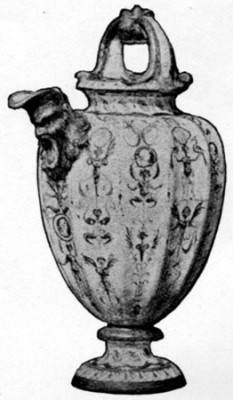
Fig. 5.—Cruet. About 1570.
Gubbio, in the Duchy of Urbino, is known principally by the works of Maestro Giorgio Andreoli, who seems to have monopolised the secret of the ruby and yellow metallic lustre, with which he enriched not only his own productions but put the finishing touches in lustre on the plates of Xanto and other artists from Urbino, as well as from Castel Durante. There is no doubt that the painting of the piece and the application of the metallic lustre colours were two distinct operations, and that it was painted and the colours fixed in the muffle kiln some months before it was touched with the lustre pigments, and again subjected to another baking. Giorgio was a statuary as well as a painter of maiolica, several of his sculptures in marble being yet extant.

Fig. 6.—Plate. “Stream of Life.” 16th Century.
Signed by Mo Giorgio. Diam. 7¾ in.

Fig. 7.—Vase. By Mo Giorgio.
H. 10½ in. 16th Century.
[Pg 8]Another painter in lustre, of the school of Mo Giorgio, has signed his pieces with the letter N., which is supposed by some to be a monogram of Vincenzio, the son of Mo Giorgio; and a painter named Perestino, of Gubbio, produced some very beautiful pieces, dated 1533 and 1536.
Guido Ubaldo II. della Rovere, who became Duke of Urbino in 1538, was a patron of the fabrique of Pesaro. The maiolica with yellow lustre, blue outlines and imbricated borders, which are assigned to Pesaro, belong to the first part of the 16th century; many of these have portraits and scrolls inscribed with the name of the person to whom they were dedicated. When Passeri visited the town in 1718, there was only one potter, making ordinary vessels. Some years after, in 1757, he sent potters from Urbania and recommenced the manufacture.
According to M. A. Jacquemart, two artists of Lodi—Filippo Antonio Callegari and Antonio Casali—were also established here about the middle of the 18th century. The bowl and cover and dish, Fig. 9, painted and gilt with flowers, are signed by them with their initials. There was another fabrique, [Pg 9]established by Giuseppe Bertolucci of Urbania in 1757; Pietro Lei, a painter of Sassuolo, was engaged there.

Fig. 8.—Drug Vase.
17th Century.

Fig. 9.—Bowl, Cover, and Dish.
18th Century.
Castel Durante, a small town near Urbino, had a very extensive manufactory of maiolica; most of its early productions of the beginning of the 15th century are often confounded with those of Urbino, but there is evidence enough to show the beautiful character of the decorations employed there. Piccolpassi, director of a bottega for maiolica, at Castel[Pg 11] Durante, circa 1550, wrote a treatise on the art of making and decorating it, whilst under the patronage of Guidobaldo II. The manuscript is in the Art Library of the Victoria and Albert Museum. This interesting work is illustrated with pen-and-ink sketches of all the details of manufacture and patterns of the ware, and the prices at which they were to be obtained; allusions are also made in it to other towns celebrated for the same industry; and the principal forms of the vessels are described by name.

Fig. 10.—Vase. About 1560.

Fig. 11.—Plate. About 1530.
In the year 1635 the name of the fabrique was[Pg 12] changed to Urbania in compliment to Pope Urban VIII.; and in 1722 it was the only one which remained in the Duchy of Urbino, where articles of utility alone were made.
A great trade was carried on in pharmacy vases or Vasi da Spezieria, covered with grotesque heads, cornucopiæ, &c., designed and shaded with light blue, touched with yellow, orange, brown and green, the patterns being mostly in a bold style.
If not the most ancient, Faenza was one of the most celebrated of the manufactories of maiolica in[Pg 13] Italy. It was this town that gave to the French the name by which they have to the present day distinguished their enamelled pottery, as Spain had previously supplied the name to Italy. Thus in Italy it was called maiolica from Maiorca, and in France, faïence from Faenza. The earliest dated piece now extant is probably a plate in the Musée de Cluny, dated 1475, made by Nicolaus de Ragnolis. Another specimen, in the Sèvres Museum, is inscribed “Nicolaus Orsini, 1477”; and in the same collection is a plate, signed “Don Giorgio, 1485,” probably by Maestro Giorgio.

Fig. 12.—Plaque. “Andrea di Bono, 1491.”

Fig. 13.—Plate. With an Emblem of Two Hearts pierced
with Arrows and the Motto “En Piu.”
15th Century.
[Pg 14]The products of this fabrique retained for a long time a special character by which they are easily identified; at first the outlines of the figures were very simple and formal; the yellow lustre does not appear to have been adopted.

Fig. 14.—Plaque. Joseph sold by his Brethren.
16th Century.
In the 16th century a favourite decoration was grotesques and arabesques in blue camaïeu on yellow ground, or alternately on the two colours (see Fig. 15).[Pg 15] The reverses of the Faenza plates are frequently light blue, with concentric circles or a spiral line in a darker colour; when white, with imbrications or zones alternately blue and yellow. Another peculiarity by which the Faenza ware is known, is the presence of red.

Fig. 15.—Plate. Arms and Arabesques.
16th Century.
Many of the lustred pieces of maiolica, with light yellow lustre edged with blue, which were attributed formerly to Pesaro, have been now classed among the wares made at Diruta, from the circumstance of a plate in the Pourtalès Collection—subject, one of Ovid’s Metamorphoses, being similarly decorated with the yellow lustre, and signed by El Frate of Diruta, 1541. Some specimens have “In Deruta” inscribed at length; others have simply the letter D with a bar through it; and early pieces have the signature of the painter, El Frate, but without the yellow lustre.

Fig. 16.—Plate. Blue and White.
16th Century.

Fig. 17.—Plate. Inscribed “Sura Fiore.”
About 1520.
According to Passeri there were fabriques of maiolica at Forlì in the 14th century. Its contiguity to Faenza exercised a great influence on the decoration of the ware, and the patterns on the obverses and reverses are similar. Fig. 18 has on the back “In la botega di Mo. Jeronimo da Forli.”

Fig. 18.—Plate. Christ amongst the Doctors.
Diam. 14 in. 16th Century.
[Pg 18]Rimini is only known by a few specimens, which are actually signed, and by the mention made of its fabriques by Piccolpassi. The pieces are dated 1535, and as late as 1635.
There were manufactories at these three places in the 16th century, but few specimens of their productions now exist. (See Chaffers’ Marks and Monograms, p. 112.) The first named is illustrated (Fig. 19) by a plateau; a man at the bottom holds a scroll inscribed “VITERBO DIOMED, 1544.”

Fig. 19.—Plateau. Diana and Actæon.
Dated 1544.
This fabrique, established towards the end of the 15th century, became very important, lasting probably throughout the 16th century. The name is spelt in different ways, such as Chaffagiuolo, but Cafaggiolo is the general form.

Fig. 20.—Plateau. St. George.
Circa 1520.
[Pg 20]Among the ornaments on this ware are frequently tablets with SPQR and SPQF (Florentinus), and on several the motto “Semper,” adopted by Pietro de’ Medici in 1470, and continued by Lorenzo il Magnifico. The device of a triangle and the word “Glovis,” meaning when read backwards “si volge” (it turns), was used by Giuliano de’ Medici in 1516, alluding to his change of fortune.
Another characteristic of this fabrique is the dark blue background of many of the pieces, and the method in which it was coarsely applied by the brush.
Fig. 20 represents the St. George of Donatello, from the bronze statue in the church of Or San Michele, at Florence.
The earliest specimens known of this important manufactory are some wall or floor tiles of the commencement of the 16th century. They are of maiolica, ornamented with polychrome designs of chimeræ, dragons, amorini, masks, birds, &c., beautifully painted in brilliant colours, especially orange and yellow on a black ground. They vary in shape, being triangular, pentagonal, or square, to suit the geometrical designs of the wall or floor they covered;[Pg 21] the average diameter is 5 inches. The plate in blue camaïeu on white ground, in the accompanying illustration (Fig. 21) is signed on the reverse “fata in Siena da Mo. Benedetto.”
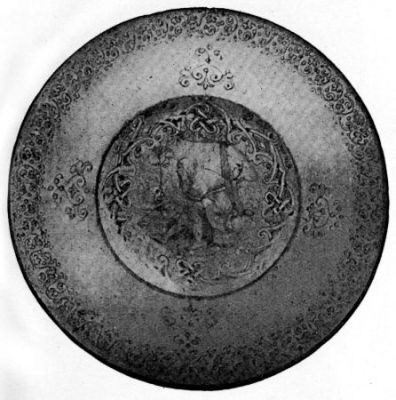
Fig. 21.—Plate. By Mo. Benedetto.
About 1520.
After a long interval, the name of the town again appears on maiolica of a very characteristic description, accompanied by the names of the artists: Bartolomeo Terenze (or Terchi) Romano in 1727, and Ferdinando Maria Campani, 1733 to 1747, the subjects being taken from Raphael, Annibale Caracci, and other masters (see Figs. 22-24).

Fig. 22.—Plateau. Woman and Peacocks.
18th Century.

Fig. 23.—Plate. Vintage.
Signed Ferdinando Ma
Campani, Siena, 1747.

Fig. 24.—Plate. Galatea.
After Annibale Caracci.
Early 18th Century.
This city was, about the middle of the 16th century, the centre of a considerable trade in the exportation of Italian fayence into Spain, and especially to Valencia, in exchange for the golden metallic lustre ware of that country. Antonio Beuter, a traveller, about 1550, praises the fayence of Pisa as well as those of Pesaro and Castelli. A specimen[Pg 24] bearing the name “PISA,” a large vase of fine form, covered with arabesques on white ground, was in the collection of the late Baron Alphonse de Rothschild.
Little is known respecting the Venetian maiolica of the 16th and 17th centuries, but numerous pieces exist bearing marks with Venice recorded on them. These are specimens of the 17th century with a mark of a fishhook, and from the long intervals between its use, it evidently belongs to a fabrique and not a painter. As an example of Venetian maiolica, circa 1700, see Fig. 25, a plate painted with an architectural subject.

Fig. 25.—Plate. Circa 1700.
[Pg 25]In 1753, the Senate of Venice conceded to the brothers Bertolini the establishment at Murano of a kiln for making fayence. But it did not succeed so well as the promoters anticipated, and it was probably discontinued about 1760, as the concession was annulled by a decree of April 1763.
In 1728, Giovanni Battista Antonibon established in the village of Nove, near Bassano, a manufactory of earthenware, and in 1732 he opened a shop in Venice for the sale of his wares. In 1741 the factory was still in a prosperous state, and carried on by his son, Pasqual Antonibon. In 1766 Pasqual took his son, Giovanni Battista Antonibon, into partnership, and in 1781 Sig. Parolini joined the concern, continuing the fabrication with great success until 1802, when they leased the premises to Giovanni Baroni, and the business was carried on under the name of Fabbrica Baroni Nove. It was prosperous for a short time, and some beautiful examples were produced.

Fig. 26.—Tureen and Cover.
18th Century.
[Pg 26]Maiolica fina or fayence only is still continued to be made, the manufacture of porcelain, for which at one time the works were so famed, not having been revived.
Of the early maiolica made here little is known, but fayence of the 18th century is occasionally met with, marked with the letter F or Fl.

Fig. 27.—Cup and Saucer.
In a street which still retains the name of Boccaleri (makers of vases) were discovered traces of ancient potters’ kilns, and some triangular wall tiles, of blue and white maiolica alternately, of the end of the 15th[Pg 27] or beginning of the 16th century. Among these was a plaque, 20 in. in diameter, of the Virgin and Child between two saints, surrounded by angels. The subject is taken from a cartoon by Nicolo Pizzolo, a painter of Padua and a pupil of Squarcione; on the summit of the throne is written Nicoleti, the name he usually adopted. The plaque is now preserved in the Museum of that city.

Fig. 28.—Plate. Myrrha fleeing from her Father.
Fig. 28, a plate, painted on grey ground, is inscribed on the reverse with the name of the place and the date 1548.
The manufactory of Castelli, a small town in the Abruzzi, north of the city of Naples, was still flourishing towards the end of the 17th century. Francesco[Pg 28] Saverio Grue, a man of letters and science, became about this time director of this Neapolitan maiolica fabrique. The ware was boldly ornamented with subjects, correctly designed and well painted; sometimes the landscapes were delicately heightened with gold. His sons and brothers continued to add lustre to his name for nearly a century. Francesco Antonio Grue’s works, which have dates, range from 1677 to 1722, the subjects being principally scriptural and mythological. Luigi Grue, about 1720-1740, painted landscapes and figures. Ioanes Grue or Grua painted scriptural subjects from about 1730 to 1750. Saverio Grue was the re-inventor of gilding on fayence; some of his pieces are dated 1749 and 1753. His earliest paintings are without gold, consisting of classical subjects and mottoes on plaques. C. A. Grue was a painter about the same time.

Fig. 29.—Bowl and Cover.
18th Century.
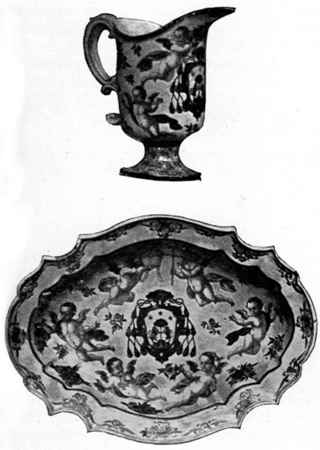
Fig. 30.—Ewer and Basin.
18th Century.
[Pg 30]Fig. 29, a bowl and cover, painted with nude figures after Annibale Caracci; and filled in with fruit, foliage, and cartouches, is signed “Liborius Grue P.”
Maiolica was made in the city of Naples in the 17th century, but little is known respecting it. Examples of the fayence of the 18th century are frequently met with, signed FDV—F. del Vecchio; Giustiniani; the letter N crowned, and sometimes the letters H.F.
The plates and dishes of coarse heavy earthenware, rudely painted with large caricature figures of soldiers and men in curious Italian costumes of the 17th and 18th centuries, in menacing and warlike attitudes, striding across the plates, holding swords, spears, and other weapons, are usually attributed to Monte Lupo, near Florence. The manufactory is still in existence.
[Pg 31]Fig. 31, is signed on the back “Raffaello Girolamo fecit Monte Lupo 1639.”

Fig. 31.—Plate. Three Cavaliers.
No specimens can be identified of an earlier date than the 18th century. The fayence is usually painted with grotesque figures, but sometimes with flowers and scrolls in relief, also with Watteau or Chinese subjects. (See Fig. 33.)
Some pieces, apparently of a later date, are from the manufactory of Pasquale Rubati, and usually signed with his initials.

Fig. 32.—Écuelle and Dish.
18th Century.

Fig. 33.—Ewer and Dish.
18th Century.

Fig. 34.—Cup and Plate.
18th Century.
That there was a manufactory of maiolica at Turin in the 16th century is proved by a dish with pierced border, painted on the inside with a boy carrying two birds on a long pole; it is marked underneath—Fatta in Torino adi 12 di Setēbre 1577 (see Fig. 35). The manufactory was in existence in the first half of the 18th century and was under Royal patronage, as a large dish which was in the collection of the Marquis D’Azeglio is inscribed on the back of the rim: “Fabrica Reale di Torino GR 1737.” In the centre of the reverse is a monogram composed of F. R. T. (Fabbrica Reale Torino).

Fig. 35.—Dish.
Dated 1577.
Alfonso I., Duke of Ferrara, himself occasionally worked in a room attached to his palace, and is said to have discovered a fine white colour, which was adopted by the fabriques of Urbino. He died in 1534. His successor, Duke Alfonso II., summoned Camillo Fontana (son of the celebrated Orazio Fontana of Urbino) in 1567 to give new life to the manufactory. All the well-known pieces bearing the impresa of the Duke, a flame of fire and the motto “ARDET ETERNUM,” were produced at this fabrique, about 1579. At a much later period, probably late in the 17th century, there was still a manufactory here.

Fig. 36.—Plateau. The Triumph of Bacchus.
First Half of the 18th Century.
A fabrique (according to V. Lazori) was founded here about 1540, by Simone Marinoni, but it is not known how long it lasted. Later pieces of the 17th century bear a certain resemblance to the Castelli ware. In 1728, a manufactory of maiolica was set on foot by the sisters Manardi, which was continued in 1735 by Giovanni Antonio Caffo; and some time after, but previous to 1753, another was carried on by Giovanni Maria Salmazzo.
Piccolpassi speaks of Genoa as a great mart for maiolica about the year 1540. He tells us the patterns painted—arabesques, leaves, landscapes, &c.—and the prices charged, but no specimens of this early date have hitherto been identified. The fayence of the 18th century, however, is of frequent occurrence; its decoration is much the same as that of Savona, viz. rude and hasty sketches in blue camaïeu, sometimes with small caricature figures in the style of Callot.[Pg 36] In consequence of Genoa’s maritime position, the mark selected for this ware was a beacon, by some erroneously called a lighthouse, from which some object is suspended on a pole.

Fig. 37.—Bottle.
18th Century.
Fig. 37, a bottle, painted in blue with birds and scroll ornaments, has this mark.
The manufactory of Savona was founded in the 17th century at the village of Albissola, situated on the coast, near Savona. The ware is generally ornamented in blue on white ground, the designs are roughly executed, and the mark, consisting of a shield of arms of the town, is often seen on the reverse. There are some other marks attributed to Savona: a double triangle with the letter S, called the “knot of Solomon” (Salomone), the sun with G.S., the falcon mark, the tower mark, and the anchor mark, so called from these emblems being depicted on the ware. Fig. 38, a basket, perforated and with two handles, is rudely painted with scrolls in yellow, blue, and green; in the centre is a cartouche with the letters S.A.G.S.

Fig. 38.—Basket.
18th Century.
Although Santa Casa at Loreto is not strictly speaking a fabrique of maiolica, yet maiolica is actually made within the precincts of the sanctuary. Bowls are made of clay, mixed with the dust shaken from the dress of the Virgin and walls of the sanctuary, and in this form are preserved by the faithful as tokens of their visit to the shrine.

Fig. 39.—Two Bowls.
The earthenware vessels with stanniferous enamel, called in Italy sgraffiato ware, have been attributed to Città di Castello. They are engraved in outline and decorated en engobe—that is, the object before being glazed is covered with a second coating of coloured slip or engobe, on which is graved the ornament or design after it has been merely dried by the air, leaving a sort of champ levé, and afterwards baked in the kiln. These fayence vases are generally enamelled in yellow, green, and brown. Fig. 40, a bowl, is decorated with foliage, on the stem are three lions seated, in full relief; round the bowl runs a wreath of yellow flowers; and within is a man wrestling with a dragon, surrounded by a wreath. There was a manufactory of this sgraffiato ware at La Fratta, near Perugia, which was continued down to a late period. Fig. 42, a basket-shaped pot, has ornaments in relief. Similar ware was also made at Pavia in the 17th century.

Fig. 40.—Bowl of Incised Ware.
About 1460.

Fig. 41.—Plate.
Diam., 11½ in. About 1540.

Fig. 42.—Red Glazed Earthenware Basket.
19th Century.
Hispano-Moresque

Fig. 43.—Vase.
Height 20¾ in. 15th Century.
The exact date of the introduction of enamelled pottery with lustre-pigment into Spain is unknown, but the existence of manufactures of “golden” pottery at Calatayud, in Aragon, is testified to by the Mohammedan geographer Edrisi in the 12th century.

Fig. 44.—Azulejo.
The Hispano-Moresque period, which is best known to us from the numerous specimens preserved to our time, commences with the 14th century,[Pg 42] when the Alhambra of Granada was erected by the Moors.
The earlier pieces of the 14th and 15th centuries may be distinguished by a golden yellow metallic lustre, and blue enamel on a white ground. The designs are Moorish, consisting of diaper patterns, foliage, fantastic and other animals, shields of arms of Spanish princes, &c., and sometimes Arabic inscriptions, transformed into ornamental designs.
Fig. 43, a vase, is decorated with leaves and conventional flowers, in reddish yellow lustre and blue.
The azulejos or enamelled tiles of the Alhambra, bearing passages from the Koran, shields and other devices, are well known; they date from the beginning of the 14th century (see Fig. 44).
Malaga. The principal as well as the earliest centre for the manufacture of fayence was in this city, and the finest known specimen of Moorish fayence is the celebrated vase of the Alhambra, which is supposed to be as early as the palace itself, viz. the 14th century, and was probably made here. The colours of the decoration are a pure blue enamel, surrounded or heightened with a yellow lustre on white ground.
Figs. 45 and 46 are other specimens of the Spanish lustre ware, with shields of arms, of the 15th or 16th century.
Majorca was the next in importance as regards its ancient manufacture, but it must also have had a very extensive trade in fayence, for it was exported to almost every part of the globe. Giovanni de’[Pg 43] Bernardi da Uzzano, writing in 1442 about the productions of the Balearic Isles, says “the fayence of Majorca has a very extensive sale in Italy.”

Fig. 45.—Plateau.
As the keramic art in Spain declined, the Arabic inscriptions, which were perfect on the early vases like that of the Alhambra, were copied, but the painter, not knowing their signification, employed them as ornaments, until at last they became altogether confused and illegible. The arabesques were no longer in such elegant taste, and large coats of arms entirely filled the centres of vases and plates.
[Pg 44]Valencia was also celebrated for its fayence, which may be traced back to Roman times, for Saguntum, now Murviedro, is mentioned by Pliny and others as noted for its jasper red pottery. It is impossible to discover the origin of the lustred pottery of Valencia, but it probably dates from the beginning of the 15th century, when it became the most important in Spain. The pieces attributed to this place have Christian devices; many of them bear the inscription, “In principio erat Verbum et Verbum erat apud Deum,” from the first chapter of St. John, and the eagle displayed (not in an escutcheon as in the arms of Aragon), for St. John was particularly venerated at Valencia. Of its earlier productions of the Moorish period nothing is known.

Fig. 46.—Plateau.

Fig. 47.—Dish.
Valencia has from time immemorial been celebrated for its azulejos or enamelled tiles. There are many houses of the 15th and 16th centuries still existing in the ancient cities of Spain, the walls of whose rooms are covered with tiles ornamented with borders, scrolls, and geometrical designs. The celebrity of this manufacture is maintained to the present day. Fayence of all descriptions was [Pg 46]extensively made at Valencia throughout the 17th and 18th centuries. Fig. 47, a dish, is blue and white with a lion in the centre.
Manises, near Valencia, was also celebrated from the 16th to the 18th century. The decorations appear to be of Oriental design, executed for the most part in a rich copper-coloured lustre. Some dishes with copper-colour lustre have upon them a mark of an open hand, which may be the emblem of the place, and are dated 1610 and 1611. Fig. 48, a vase, is painted in lustre, with foliage, birds and animals, and with a rudely executed shield of arms, seemingly of Sicily or Portugal.

Fig. 48.—Vase.
[Pg 47]Triana, near Seville. There were several fabriques here, one for the manufacture of spires or ornaments of earthenware, with which the gables of the buildings were crowned; others for the azulejos or tiles so much used in Spain, and for fayence vessels of all descriptions. Fig. 49 is a bottle in the form of a lady in the costume of the period of Louis XIV., en grande tenue; inside the fontange or top-knot of the headdress, which forms the spout, is written “Victor. I. Viva. Mi. Arno. Don. Damian. Sant. ✠.”

Fig. 49.—Bottle.
Height 14 in.

Fig. 50.—Dish.
Dated 1774.
Alcora. There was a very important fabrique of fayence at this place, carried on by the Count D’Aranda, in the 18th century.
[Pg 48]The usual mark upon this fayence is the letter A in gold or colour.

Fig. 51.—Plaque.
Talavera, near Toledo, was one of the most important manufactories in Spain in the 17th and 18th[Pg 49] centuries, and the word talavera was used to indicate all fayence in the same manner as fayence in France and delft in England.

Fig. 52.—Bowl.
18th Century.
Fig. 52, a bowl, is glazed, decorated within and without with a bull fight, storks, and trees, in green, orange and manganese.
Maiolica and Fayence are essentially the same, being composed of the same material and covered with a tin glaze or opaque white enamel, which serves to hide the dingy colour of the clay, and forms a fine ground for the reception of colours.
Saint Porchaire. All the earliest writers on the subject appear to have thought that it was made in Touraine, and it was called Henri Deux ware.
The ware next became known as Faïence d’Oiron, but in 1888 it was affirmed that the factory of this pottery was at Saint Porchaire.
The distinguishing characteristics of this curious ware are, in the first place, the body, which is of a creamy white pipeclay, very compact and of fine texture, so that it does not, like the ordinary fayence, require an opaque white enamel, but merely a transparent glaze; and secondly, that instead of being painted with enamel colours over the surface, it is inlaid with coloured plates, in the same manner as the champ levé enamels or niello work in metal.
Fig. 53, a candlestick of cream-coloured ware, is inlaid with arabesques and other patterns, in dark brown and reddish brown, with reliefs of three boys,[Pg 51] tragic masks, shields of arms of France, and the cipher of Henri II.; above are three terminal figures of satyrs; date about 1540.

Fig. 53.—Candlestick.
Fig. 54, a biberon, is inlaid with interlaced bands and scrolls, rosettes, guilloches, masks, &c., in a reddish colour; a curved band on the neck has a[Pg 52] row of ciphers, these being the letters A. M., elegantly arranged as a decorative monogram, probably that of the Constable Anne de Montmorency.
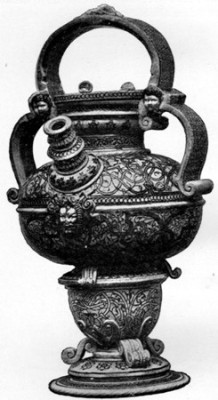
Fig. 54.—Biberon.
Height 9¼ in.
[Pg 53]Beauvais was celebrated for the manufacture of decorative pottery in the 14th century, and descriptions of cups of the terre de Beauvais frequently occur in early inventories. Several specimens of it are still in existence; they are of red, green, or blue glaze, with gothic inscriptions and arms of various provinces of France in relief.
Apt. The fabrication of fayence is said to have commenced here about the middle of the 18th century, principally in imitation of jasper and brocatelle marble. The manufactory of M. Bonnet was established about 1780, and marbled ware and vases of a yellow colour were produced.

Fig. 55.—Vase.
Fig. 55 is a yellow vase with masks and vine leaves.
[Pg 54]Blois. A manufactory of fayence was in existence here throughout the 17th and 18th centuries. It was similar to that of Nevers and Rouen. Some specimens are signed Lebarquet.
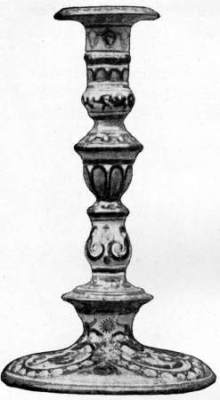
Fig. 56.—Candlestick.
Avignon. A manufactory of pottery flourished here from about 1650 to 1780, but there were also potteries early in the 16th century. The pottery is of a chocolate brown, with a fine metalloid glaze like bronze or tortoiseshell. The ewers and bottles are of elegant forms, resembling those of[Pg 55] Italy, sometimes perforated and ornamented with masks and flowers in relief, or painted yellow.

Fig. 57.—Ewer.
About 1600.
Bernard Palissy, born 1510, succeeded, after many years of diligent research, in discovering the enamel which decorates his ware. His earthenware, as well as his style of decoration and his beautiful modelling, were quite original. The natural objects represented upon his ware are true in form and colour, being mostly modelled from nature; the shells are copied from tertiary fossils found in the[Pg 56] Paris basin; the fish are those of the Seine, and the reptiles and plants such as he found in the environs of Paris.

Fig. 58.—Dish.
16th Century.
Nevers. The earliest evidence of the making of fayence at Nevers is the foundation of a fabrique by Dominique Conrade, in the latter half of the 16th century, which was carried on by his son and grandson. In 1652, Pierre Custode established another fabrique, which was equally successful, and seven generations of his family were employed in it. Other manufactories were started in the 18th century.
The fayences of the first epoch, 1600 to 1660, have frequently been confounded with Italian [Pg 57]maiolica, but a little attention will show the points of difference. In the Nevers ware the figures are always yellow on blue ground; the Italian figures are usually blue on yellow. At Nevers red or metallic lustre was never employed, and the outlines are always traced in manganese violet, never in purple or black. During the second epoch, the ground was a peculiar lapis-lazuli blue, like the Persian colour called bleu de Perse; it entirely covered the piece, was spotted or painted with white, or sometimes in yellow and orange, and decorated with flowers and birds. The Chinese patterns are in light blue en camaïeu, sometimes intermixed with a sort of brown lilac.

Fig. 59.—Pilgrim’s Bottle. Bleu de Perse.
2nd half of 17th Century. Height 11½ in.

Fig. 60.—Ewer. Painted with Japanese figures,
2nd half of 17th Century. Height 15⅜ in.

Fig. 61.—Pilgrim’s Bottle. Apollo and Daphne;
rev. A
Bacchanalian Scene.
In blue and yellow. Height 12¼ in.
Rouen. There was a manufactory of pottery at[Pg 60] Rouen early in the 16th century, and towards the end of the next century there were many establishments. At the commencement of the 18th century, the Chinese style pervaded all the Rouen fayence, but it was transformed or travestied and possessed a special physiognomy; the subjects were landscapes and buildings with figures, fantastic birds, dragons, &c., in blue, green, yellow, and red, bordered with the square Chinese ornaments. At a later date the decoration consists principally of flowers issuing from cornucopiæ and rococo ornaments; this sort of style is called in France “à la corne.” The paste of the Rouen fayence is heavier and thicker than that of Delft, but the designs and ornaments are full of taste, decorated in blue camaïeu and in polychrome, some in the style of Nevers, with white on bleu de Perse, but of paler colour. The pieces were frequently of large size, and included fountains, consoles, vases, &c.
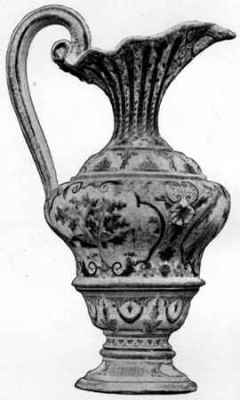
Fig. 62.—Ewer.

Fig. 63.—Ewer.
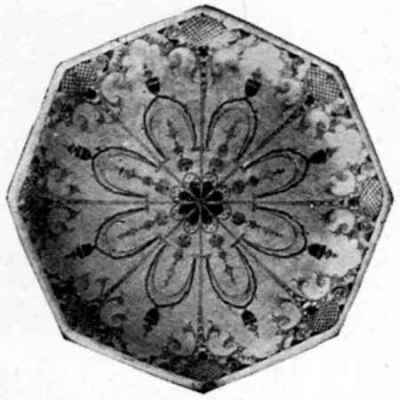
Fig. 64.—Plate.
Fig. 62 is painted with polychrome decoration of landscapes, &c.; period of Louis XIV.; height 26⅜ in.
Fig. 63 is painted in blue with arabesques and flowers; period of Louis XIV.; height 9¾ in.
[Pg 62]Fig. 64 is painted in the centre with a rose ornament, with medallions and scrolls round the rim, in blue and orange; period of Louis XIV.; diam. 10 in.

Fig. 65.—Compotier.

Fig. 66.—Compotier.
Fig. 65 is painted in polychrome; period of Louis XV.; diam. 9⅝ in.
Fig. 66 is painted with Chinese figures, &c., in polychrome; period of Louis XV.; diam. 10 in.
[Pg 63]Strassburg[1] and Hagenau were noted for the manufacture of fayence, established by Charles François Hannong about 1709. It was called in France “poterie du Rhin,” and is of a peculiar character, and easily known, being generally decorated with flowers and scrolls in red, rose colour, and green. Charles F. Hannong was succeeded by his sons Paul and Balthasar. The former took charge of the Strassburg works, and the latter the factory which had been started at Hagenau. The Strassburg fayence works were closed in 1780.

Fig. 67.—Fountain.

Fig. 68.—Clock and Bracket.
[Pg 65]Fig. 67, polychrome decoration, bears the initials of Paul Hannong; about 1750; height 22¼ in.
Fig. 68, in three pieces, coloured in maroon, yellow, blue and green, bears the mark of Paul Hannong; about 1750; height 3 ft. 9 in.
Moustiers. The products of the Moustiers fabriques may be divided into three periods:—
1st Epoch. Towards the end of the 17th century. The subjects are hunting scenes, &c., painted in blue; champêtre scenes and figures in costumes of the period of Louis XIV.; and mythological and biblical subjects with arabesque borders. The outlines are sometimes lightly indicated in violet of manganese.

Fig. 69.—Plateau.
2nd Epoch. From the commencement of the[Pg 66] 18th century to about 1745. The specimens of this period are in blue camaïeu with highly finished and graceful interlaced patterns, among which are cupids, satyrs, nymphs, terminal figures, flowers, masks, &c.; canopies with draperies resting upon consoles, vases, fountains, &c.
3rd Epoch. From 1745 to 1789. The fayence is mostly painted in polychrome; the colours are blue, brown, yellow, green, and violet. The decorations are flowers, fruit, and foliage, and sometimes mythological subjects. Other patterns of this period consist of grotesque figures, and caricatures. The outlines of the designs were transferred to the surface of the ware by means of paper patterns, pricked with a fine needle and powdered over with charcoal.

Fig. 70.—Compotier.
Fig. 69, painted in green camaïeu with a rustic subject in the style of Boucher, with polychrome floral border; 1720 to 1760; diam. 11⅛ in.
Fig. 70. Compotier, painted with a central[Pg 67] hunting subject, after Tempesta, surrounded by a floral border, and outer border of garlands, in polychrome; 1680 to 1720; diam. 10⅜ in.

Fig. 71.—Plate.

Fig. 72.—Barber’s Basin.
Fig. 71. Plate, octagonal, with curved outline, painted with central medallion of Juno standing in a landscape, surrounded by a garland, and round[Pg 68] the border the busts of divinities within medallions, and garlands, in polychrome; 1680 to 1720; diam. 10 in.
Fig. 72. Barber’s basin, painted in polychrome with the subject of Diana and Actæon; 1680 to 1720; length 15 in.
Varages also possessed manufactories in the 18th century for fayence in the style of Moustiers, from which it is only a few miles in distance. Some of this ware bears the mark of a cross, and was called “Faïence à la Croix.” Fig. 73 is painted with rustic figures in landscape, after Wouverman; crimson and green flower border, and marked with a cross. 18th century. Diam. 11½ in.

Fig. 73.—Plate.
Marseilles. The manufacture of fayence at Marseilles, and elsewhere in the South of France, was in activity early in the 17th century. A little after 1750, twelve fabriques of pottery were in existence. In 1790 there were eleven manufactories existing, but most of them ceased about 1793, on account of the Treaty of Commerce with England. The Revolution[Pg 70] of 1793 gave an additional blow to the keramic industry of Marseilles. In 1805 there were only three factories at work, employing twenty hands. In 1809 only one remained.

Fig. 74.—Tureen.
The fayence is much the same in character as that of Moustiers, and sometimes resembles that of Strassburg. The decorations are frequently in red or green, sometimes with Chinese designs. There is one peculiarity about the Marseillaise fayence which at once fixes its identity, and this is, three green leaves or marks painted on the backs of plates and dishes to hide the imperfections in the enamel caused by the pernettes or points of support on which they rested in the kiln. There is also a great resemblance between the early ware made here and at Genoa, in consequence of the emigration of many workmen. We learn from a complaint made on the subject by the potters of Marseilles to the Intendant of Provence in 1762, from which it seems they took a great number of apprentices at very low wages, and the wages were paid in fayence, which mode of payment they said deteriorated the quality, and caused the workmen to emigrate to Genoa. Also they complained that great quantities of Genoese fayence were imported into Languedoc and Provence, and spread over France, which was absolutely ruinous to the trade of the two provinces, and especially to Marseilles.
Fig. 74. Soup tureen, cover, and stand, with polychrome flower decoration and gilding, was made by Savy, about 1750; length of tureen, 15½ in.
Sinceny in Picardy. A manufactory was [Pg 71]established here in 1733, by Jean Baptiste de Fayard, Gouverneur de Chaunay et Seigneur de Sinceny. Dr. Warmont (Recherches Historiques sur les faïences de Sinceny, &c., Paris, 1864) divides the products of this manufactory into three periods:—
1. Rouennaise, 1734 to 1775.
2. Faïence au feu de réverbère, 1775 to 1789.
3. Décadence de l’Art, 1789 to 1864.
The earliest pieces were painted in blue; the next in blue touched with red or green and yellow, decorated with lambrequins (mantlings), à la corne (cornucopiæ), birds, and butterflies. Chinese figures were doubtless stencilled by pricked papers and charcoal powder.

Fig. 75.—Bowl and Cover.
[Pg 72]About 1775 a great improvement was perceptible in the fayence of Sinceny; the paste became finer in quality, the colours brighter and more varied, in more exact imitation of the porcelain of Japan. This was accomplished by what is called le feu de réverbère, in contradistinction to the old process au grand feu; the latter included only one baking, while in the other the ware was placed a second time in the kiln, and the pigments were not exposed to so great a heat, which allowed the employment of brighter colours. Table services decorated in polychrome, with branches of roses, sometimes in green camaïeu; delicate wicker baskets, watch stands, &c., were produced; they were painted with Chinese figures, rococo scrolls, and other ornaments. From 1790 the fayence au feu de réverbère was largely discontinued on account of its expensive character and the introduction of English ware at a lower price; but still, both descriptions were occasionally made.
Fig. 75 is a bowl and cover, painted in colours inside with a coronet, supported by two cupids on clouds with a flaming heart beneath, 18th century.
Lunéville. Founded in 1731 by Jacques Chambrette, it was called La Manufacture Stanislas; Jacques was succeeded by his son Gabriel and his son-in-law Charles Loyal. They made fayence of blue decoration like Nevers, and sometimes with rose and green colours like the old Strassburg ware. Large figures of lions, dogs, and other animals, of natural size, are sometimes met with.

Fig. 76.—A Pair of Rustic Figures. With polychrome decoration.
About 1775. Height 8¾ in.

Fig. 77.—Dish. In polychrome.
About 1760. Length 13¼ in.
[Pg 74]Aprey, near Langres. Established, about 1750, by Lallemand, Baron d’Aprey. About 1780 it was conducted by M. Vilhault, who made a superior kind of fayence. The early style is that of Strassburg with rose colour, green and yellow predominating.
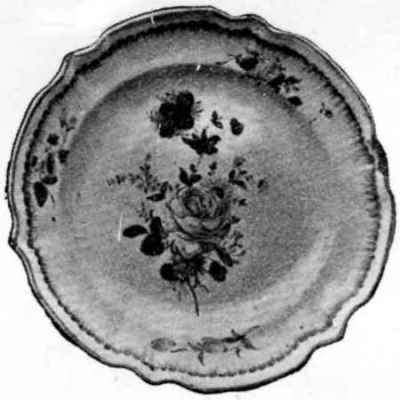
Fig. 78.—Plate. In polychrome.
Diam. 9⅜ in.
At Manerbe, near Lisieux in Normandy, and at Malicorne, Infreville, Château-la-Lune and Armentières, those elegant glazed earthenware pinnacles or finials which adorn the gables of old mansions in various parts of Normandy were constructed. They are 5 or 6 feet in height, being a series of small ornaments placed one above another on an iron rod; they partake of the character of the figulines rustiques of Palissy, and have frequently been sold as such.

Fig. 79.—Finial.
About 1600.
[Pg 76]St. Clément. Established about 1750. Little is known of this fabrique. There are some specimens of the 18th century in the Sèvres Museum; also some others of later date, 1819 and 1823.

Fig. 80.—Écuelle.
With gilt scrolls on white ground.
Toulouse. Established in the 18th century. The ware is very similar in style to early Rouen pottery. A large hunting bottle, with loops for suspension, painted with blue flowers, and bearing round the neck the inscription “Laurens Basso a Toulousa Le 14 Maÿ 1756,” was formerly in the possession of the late Mr. C. W. Reynolds.
Niderviller.[2] Established in 1760, by Jean Louis, Baron Beyerlé. The ware is in the German style, potters from Germany having been employed in its production, and is remarkable for the richness and delicacy of its decoration, which most frequently consists of flowers in bouquets and garlands. His fayence figures and groups are well modelled. About 1780,[Pg 77] four years before Beyerlé’s death, the factory was purchased by General Count Custine, and carried on by him under M. Lanfray, principally for the manufacture of porcelain, which will be subsequently referred to.
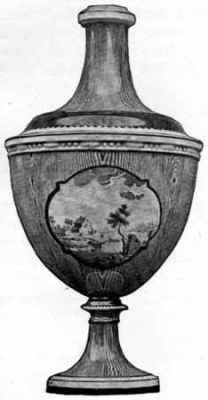
Fig. 81.—Vase.
Fig. 81. Vase with cover, one of a pair; urn shape, painted to resemble deal, with medallions containing landscapes in rose camaïeu, and borders of bay leaves. It bears the mark of Count Custine; date about 1774; height 17⅜ inches.
[Pg 78]Douai. Two brothers of the name of Leech, from England, were engaged, in 1782, by M. George Bris, of Douai, to superintend the manufacture of English pottery on a large scale, in a factory (now a Normal School) in the Rue des Carmes. It was one of the first of the kind established in France. The chief workmen, who came originally from England, instructed pupils, who carried the new process to Chantilly, Forges, and other places in France.
Vincennes. In 1768 M. Maurin des Abiez undertook a manufacture of fayence in the manner of Strassburg, it being well known that there did not exist in France any fayence comparable to it in beauty and solidity; he had purchased the secret, and brought to Paris a staff of workmen who had been engaged at Strassburg. He acquired possession of the Château de Vincennes for twenty years. Pierre Antoine Hannong was engaged as director, and the works were carried on for four years, until 1771, when the factory got into difficulties and was closed.
Sarreguemines.[3] Established about 1770 by Paul Utzschneider. The beautiful fayence produced here is in imitation of porphyry, jasper, granite, and other variegated hard marbles, and was sometimes cut and polished by the lathe; it was also made with white raised figures on blue in the style of Wedgwood, and a third kind was red ware like the Japanese. The name is impressed on the ware.
[Pg 79]St. Amand-les-Eaux, near Valenciennes. Founded about 1750 by M. Fauquet, and continued by his son. The latter occupied himself especially with the gilding of his ware, which gave his neighbours the opportunity of saying he melted all his louis-d’ors in making his experiments and ruined himself. In the revolution of 1789 he emigrated, and all his goods were confiscated. In 1807 he attempted to revive the fabrique, and advertised that the St. Amand works were in full activity, making white fayence in the style of Rouen.

Fig. 82.—Inkstand.
Fig. 82, an inkstand, with ink and pounce pots and drawer, painted on a grey ground with blue and white flowers under the glaze; about 1760-80.
Sceaux Penthièvre. In 1753, Jacques de[Pg 80] Chapelle established a manufactory of a particular sort of fayence, of which he alone possessed the secret. The ware is in the style of Strassburg, its prevailing colours being pink and green; it is painted with flowers, but more carefully finished, and with landscapes and other forms of decoration.

Fig. 83.—Plate.
Bourg-la-Reine. Established in 1773 by Messrs. Jacques and Jullien, who removed hither from Mennecy. The early ware is very similar to that of Sceaux. Besides the white fayence for domestic use, more artistic pieces were produced, painted on the enamel after it had received a slight baking; this ware is principally in imitation of the Italian.
Creil. A manufactory of fine fayence, worked[Pg 81] in the 18th century by M. St Criq, made opaque porcelain and stoneware in the English style, and transferred prints on to the ware.

Fig. 84.—Plate.
With a yellow border and transfer-printed landscape.
Montereau. In 1775, Messrs. Clark, Shaw, & Co., obtained letters patent to carry on a manufactory of English fayence, called Queen’s ware, from clay found in the vicinity. This ware had a very extensive sale, and dealt a severe blow to the manufacture of French fayence. It soon spread over France, and was extensively made at Toulouse, Creil, Sarreguemines, and other places.
Lille. A manufactory of fayence, was founded[Pg 82] in 1696, by Jacques Feburier, of Tournai, and Jean Bossu, of Ghent, who made a ware à la façon de Hollande.

Fig. 85.—Dish.
Another important manufactory of fayence was established in 1711, by Barthélemy Dorez and Pierre Palissier; it continued in active work for nearly a century. A third fayence manufactory was founded in 1740 by J. Masquelier, and was continued in[Pg 83] the same family until 1827. A fourth was established in 1744, by M. Chanou, who made a brown earthenware called terre du St. Esprit, in the English fashion. There were also two other factories here in the 18th century.
The pottery of Germany consists of two distinct classes: the fayence with opaque white stanniferous glaze, and that which to a great extent is called in England stoneware, in Germany Steingut, and in France grès or sandstone. These epithets exactly describe the quality of the latter ware. It is very serviceable for domestic utensils, such as drinking bottles and vessels of everyday use, and is covered with a thin transparent glaze, effected by throwing common salt into the kiln when the ware is nearly baked—the salt vaporised by the heat surrounds the vessels, and acting upon the silica of their surfaces produces a thin gloss of silicate of soda over the ware, rendering it perfectly impervious.
Nuremberg (Nürnberg). The celebrated Veit Hirschvogel, of Schlettstadt, was born in 1441, and died in 1525; he was a great potter, contemporary with Luca della Robbia, of Florence. The early pieces of pottery are somewhat like maiolica, but the colours are brighter, green predominating in many specimens; figures in relief in niches are frequently seen on vases. Several chimney-pieces of this ware of the 15th century are still in existence, one is in the castle of Salzburg, and many[Pg 85] pieces treasured up in museums are supposed to have been made by Hirschvogel himself. The Nuremberg pottery of the 16th and 17th centuries is not uncommon. Hirschvogel was succeeded by his sons and a host of continuators. Fayence of the 18th century is also met with, painted with scriptural subjects, sometimes in blue camaïeu, sometimes in other colours.

Fig. 86.—Jug.
15th Century.
Fig. 86. Jug, of enamelled earthenware, in[Pg 86] various colours, with figures in low relief; attributed to Veit Hirschvogel; height 13 in.

Fig. 87.—Dish.
Fig. 87. Dish, painted in the centre with Christ rising from the tomb; signed with the painter’s name Glüer, 1723.
Leipzig. In the convent of St. Paul, which was built in 1207, there was a frieze of bricks, covered with tin enamel glaze, representing in relief the heads of Saints and Apostles, 20 in. by 15 in., 2½ in. thick. On the demolition of the convent a selection of these was deposited in the Dresden Museum; they are of Byzantine character, in green enamel[Pg 87] shaded with black; the hair, beard, and eyes of the figures are coloured.
Strehla. A manufactory for earthenware was in existence here for many centuries. A pulpit of enamelled earthenware still exists, supported by a life-size figure of Moses, ornamented with eight plaques of religious subjects and figures of the four Evangelists, bearing the name of the potter and the date 1565.
Oberdorf. A factory was carried on by a potter named Hans Seltzman; a very fine stove made by him, with an inscription and dated 1514, is in the Palace at Füssen, in Bavaria. Many other places throughout Germany were equally famous in the 16th and 17th centuries, for the manufacture of stoves, as Augsburg, Memmingen, &c.
Bayreuth. The manufacture of a brown stoneware with Renaissance medallions, arabesques, &c., in relief flourished here in the 16th century. At a later period, fine fayence was produced, painted in blue camaïeu. The designs are delicately traced with a brush on a fine paste; the forms are canettes, jardinières, &c. At the end of the 18th century a fabrique of fayence was carried on by a Herr Schmidt, who assiduously copied the English ware; there are specimens in the Sèvres Museum bearing the counterfeit mark of “Wedgwood.”

Fig. 88.—Coffee-pot.
Fig. 88. Coffee-pot and cover, chocolate coloured ground, decorated with gilt scrolls; F, the cypher of Frederick the Great, under a crown in front; about the middle of the 18th century; height 9 in.
Cologne (Köln). The stoneware made here in the 16th century is better known throughout Europe than any other description of pottery; its durability[Pg 89] for domestic uses and the elegant character of its ornamentation in relief, caused it to be sought for everywhere. The grès de Cologne has been confounded with the grès de Flandres, which latter name is given erroneously and indiscriminately to all stoneware of German manufacture, notwithstanding the German inscriptions the pieces bear and the arms of German cities and families. The best and most highly finished decorative grès or stoneware cruches were undoubtedly made in Germany, if not at Cologne. The clay for making the Cologne ware came from Langerwehe between Düren and Aix-la-Chapelle. The manufactory was not actually in Cologne, but in the vicinity, possibly at Frechen, and at Lauenstein, where a factory was established in the 18th century.
There were also factories at Siegburg and Limburg.
All the ware was made in moulds, and it must be borne in mind that the vessels were not always made at the date indicated upon them, for the moulds were used successively through a series of years, and it is no uncommon occurrence to find two different dates upon the same piece. Some of the finest specimens known bear the name of Baldem Mennicken, a potter dwelling at Raeren in the ancient Duchy of Limburg, which town until the treaty of 1814 was part of Holland, and it is probable that the stoneware produced here indicates the origin of grès de Flandres.

Fig. 89.—Limburg Cruche.
Grey and blue. Height 8¾ in.

Fig. 90.—Raeren Cruche.
Grey and blue. Height 7¼ in.

Fig. 91.—Siegburg Canette.
Cream colour. Dated 1574.
Height 17¼ in.
[Pg 92]Grenzhausen, in Nassau. There was a factory here about 1780, where grès or stoneware was made; it is of a fine quality and easily mistaken for the more ancient grès. The forms are usually plates, dishes, and jugs, in which the decoration consists of a fine blue enamel on grey ground, with incuse ornaments executed by hand.

Fig. 92.—Jug.
[Pg 93]Fig. 92, a jug of reticulated pattern, is engine-turned, and enriched with brilliant enamel colours, 18th century.

Fig. 93.—Fountain.
[Pg 94]Fig. 93, a large fountain, is purple blue and white, 16th century; height 30 in.
Kreussen, a town of Bavaria, has long been noted for its pottery. The grès of the 17th century, called Kreussener Steingut, is of a dark brown colour, in the forms of cylindrical mugs, tankards, &c., with figures in relief round them, painted in bright coloured enamel.

Fig. 94.—Tankard.
[Pg 95]Fig. 94, a tankard, has a chocolate-coloured ground, with coloured enamel ornaments and figures of the Emperor and the Electors of Germany on horseback, dated 1696.
Bunzlau, in Silesia. Grès was made here in the 16th and 17th centuries. The products of the 18th century are distinguished by ornaments in relief, flowers, coats of arms, &c., sometimes gilt. At the present time an extensive trade is still carried on in the manufacture of chocolate and coffee pots, usually covered with a brown glaze, and lined with white. There is preserved a monster coffee-pot, 15 feet high, made at this place in the 18th century.
Harburg, on the Elbe, opposite Hamburg, is noted as the residence of Johann Schaper, who was born towards the end of the 16th century. His exquisite paintings of landscapes and figures are usually in Indian ink or sepia en grisaille, the colours being fixed by heat.

Fig. 95.—Cruche.
Fig. 95, a cruche of fine fayence, painted with[Pg 96] a landscape in grey camaïeu, is signed “Joh. Schaper”; it has a white ground with flowers and fruit in natural colours; date about 1640; height 8½ in.
Scherzheim, in Würtemberg. The Wintergursts, father and son, were celebrated potters here, and made fayence from the beginning of the 17th century; it is from their manufactory that the table services, of which each piece represents an animal or a vegetable, were made.
Lauenstein, near Coblenz. A manufactory was established in 1760; the grès or stoneware made here was of grey and blue, ornamented with incuse patterns; it was made in large quantities, and carried by the Rhine boats to the markets in Holland, where it met with a ready sale.
Höchst, near Mainz. Enamelled fayence was made here in the beginning of the 18th century, at a factory founded by Gelz of Frankfort. The manufactory ceased in 1794, but a potter named Dahl established one in the vicinity. He made statuettes and other ornaments.
Dresden. A manufactory was established at Meissen, on the Elbe, about 12 miles from Dresden, by Augustus II., King of Poland and Elector of Saxony, for the manufacture of hard paste, or true[Pg 97] porcelain. The experiments of Tschirnhaus and Böttcher commenced about 1706; to the latter is attributed the invention of hard paste. His first attempt produced a red ware, like jasper, which was cut and polished by the lapidary and gilt by the goldsmith. It was made from a kind of brown clay found at Meissen. This red ware, made by Böttcher, was a fine stoneware, having opacity, grain, and toughness.
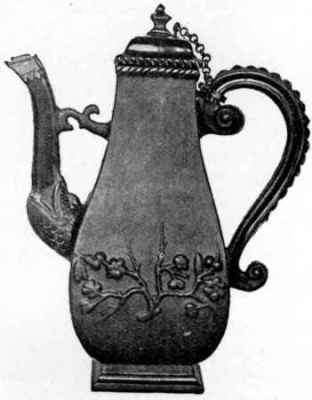
Fig. 96.—Böttcher Coffee-Pot.
Another kind of pottery was made at the beginning of the 18th century, in imitation of the Japanese; it was called the red pottery of Dresden.
[Pg 98]Teinitz (Bohemia). A manufactory was carried on in this small town in the 18th century by a potter named Welby.

Fig 97.—Plate.
Fig. 97. A plate painted in bistre camaïeu with the Discovery of Calisto by Diana. It has an elegant border in grey, with richly gilt designs, resembling the gilding of Vienna. Date about 1800.
Frankenthal. Paul Hannong, driven from Strassburg in 1753, in consequence of the Vincennes monopoly, founded a manufactory here in the following year for hard paste porcelain; he also made great quantities of fayence, usually decorated with flowers, as at Strassburg. It was called “Poterie du Rhin.”
Arnstadt (Gotha). A factory was established here about the middle of the 18th century. A fayence jug, painted in blue camaïeu, with St. George[Pg 99] and the Dragon, coloured flowers on the sides, and a purple and green check border, is in the British Museum.
Kiel was noted for its fayence about 1770; the factory was under the direction of J. Buchwald, who had been master potter at Marieberg, 1761 to 1765; a few years after, probably in 1767 or 1768, he became director of the Kiel manufactory. The paintings of landscapes and flowers in colours are well finished.

Fig. 98.—Bishop’s Mitre Bowl.
Delft, a town between the Hague and Rotterdam, was celebrated for its earthenware at a very early period. The exact date of its commencement is not known, but there is a record of a certain Herman Pietersz, a fayence maker, being married in 1584, consequently pottery was being made in the town towards the end of the 16th century. At this period the decorated Dutch pottery showed Italian influence in its design, and it is recorded that a painter on pottery named Vroom studied his art in Italy.
After the middle of the 17th century the industry increased rapidly, and reached its greatest prosperity about 1680, when there were about thirty different factories, and the ware was decorated by highly skilled artists. No one was allowed to establish a factory unless he had obtained a licence from the Guild of St. Luc.
To this period belong famous potters, such as P. J. Van Kessel of “The Metal Pot”; Abram de Kooge of “The Old Moor’s Head,” who decorated landscapes in blue camaïeu; and Albrecht de Keizer, with his two sons-in-law, Jacob and Adrian Pynaker,[Pg 101] of “The Three Porcelain Bottles,” who were the first to imitate oriental porcelain. Other potters of note at this time were the Eenhorns, father and two sons, the Kleftyns, and the five Kams.

Fig. 99.—Cruche.
[Pg 102]By the middle of the 18th century, owing to the competition of English pottery, the Delft industry was already on the wane. In 1780 the factories were reduced to one half their former number, and by 1808 only seven existed. All these gradually succumbed, and now only one factory, “The Old Porcelain Bottle,” remains.

Fig. 100.—Teapot.
The forms of the Delft ware are very varied; among other curious efforts the potters produced musical instruments. There are four fayence violins extant, all painted in blue camaïeu, with figures in Dutch costume of the 17th century, dancing and singing, musicians and kermess scenes, in the manner of Gerard Lairesse, with cupids and Renaissance ornaments as borders.
[Pg 103]The decorated pieces of Ter Himpelen, although rarely signed, are much prized; he painted fairs and marine subjects on square plaques, about the year 1650. So also are those of Piet Viseer, a celebrated colourist, who flourished about 1750; and of Van Domelaar, who painted Chinese landscapes, &c., about 1580.

Fig. 101.—Vase.
[Pg 104]Fig. 99, a cruche, is painted in blue camaïeu, with a musical party, in the costume of about 1670.
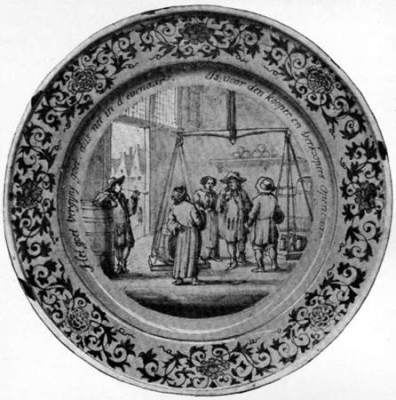
Fig. 102.—Plate.
Fig. 100, a teapot, is painted in polychrome with Chinese landscapes and flowers on a black ground. It has the mark of Louwys Fictoor. Late 17th or early 18th century.
Fig. 101, a vase, is painted in blue with flowers, in[Pg 105] imitation of a Chinese type. The mark of Ghisbrecht Lambrechtse Kruyk. Later half of 17th century.
Fig. 102, a plate painted with figures in blue, is one of a set of twelve representing the tobacco industry.
Utrecht. There was a manufactory of tiles here, founded in 1760; they were decorated in blue or violet, en camaïeu, in imitation of Delft; the manufactory was closed in 1855.
Amsterdam. A German Jew of Breslau, named Hartog, known as Hartog Van Laun, and another, named Brandeis, established a manufactory of fayence near the gate of Weesp, at Amsterdam. The ware is heavy, not very artistic, and usually in blue camaïeu. Fig. 103, a fruit dish, is painted in blue, with a man and woman seated.

Fig. 103.—Dish.
[Pg 106]Overtoom. A manufactory of fine fayence was established in 1754, in the parish of Amstelveen, near Amsterdam; it lasted ten years. The Barons Van Haeren and Van Palland were the proprietors, and Ariel Blankers was the director. The fayence, though heavy, was of a fine white enamel and of good forms; besides table and tea services, groups of birds, modelled from nature, statuettes, &c., were made.
An important fabrique was established at Luxemburg by the brothers Boch, in 1767, who had removed from Audun le Riche in France. They made various descriptions of earthenware, as well as fine fayence, and largely imitated the English Queen’s ware.
St. Petersburg. About the year 1700, Peter the Great, during his stay at Saardam, induced some potters of Delft to emigrate to St. Petersburg, where he established a manufactory. We have no information on the subject, except a notice of it in the “Connaissances Politiques,” of Beausobre, published at Riga in 1773: “There is also among the porcelain manufactories at St. Petersburg a fabrique of fayence, on the other side of the Neva, where they make every description of vessels of correct design and in good taste. A private gentleman of Revel has also established at his own cost, near this city, a fabrique of fayence, and has obtained painters and potters from Germany.”
Rörstrand, a suburb of Stockholm, where a factory for earthenware was established in 1726. The works were at first under the direction of Jean Wolf. He was succeeded by C. C. Hünger. In 1772 they were managed by Nordenstople, and later by Geyer.

Fig. 104.—Butterboat.
Marieberg

Fig. 105.—Vase and Cover.
[Pg 109]Fig. 104, a butterboat, leaf-shaped, is painted with flowers; dated 1771.
Stockholm is the same manufactory as Rörstrand, but the mark was altered when the latter town was united to the capital.
Marieberg, near Stockholm. The second Swedish pottery was established in 1750, on the expiration of the monopoly of Rörstrand, by M. Ehrenreich, under the patronage of Count Scheffer, Councillor of State. The fayence was something like Delft ware, and it was also ornamented with transfer printing.

Fig. 106.—Plate.
Fig. 105, a vase and cover, is coloured in relief; date about 1770.
Fig. 106, a plate with pierced border, has a shield of arms and flowers; dated 1768.
Porcelain has this distinguishing characteristic, that when held up to a strong light it appears translucent, unlike fayence, which is perfectly opaque. Its fracture is hard and white internally, like a broken piece of alabaster.
Porcelain of soft paste has the appearance of an unctuous white enamel like cream; it is also to the touch of a soft, warm, and soapy nature, something like the surface of fine fayence. The pâte tendre is also soft in another sense, being unable to bear so great a degree of heat in the furnace as hard porcelain. The soft paste may, therefore, be easily cut or scratched with a steel point or a file, which would have no effect upon the hard paste; it is consequently liable to become much scratched by frequent use. The hard paste or true porcelain is of the whiteness of milk; it feels to the touch of a hard and cold nature, and is somewhat heavier than the soft; underneath the plates and other pieces the rim or edge is left unpolished, or without glaze.
The painting upon porcelain is executed after the ware has been baked. Whilst in a biscuit state, the piece to be painted is dipped into a diluted glaze; it readily absorbs the water, leaving on the surface a thin coating of components which quickly dries[Pg 111] into a solid shell, uniformly thick over all its parts, and sufficiently firm to bear handling without being rubbed off during removal into the seggar or case which protects it in the kiln.
The amateur must be upon his guard in collecting porcelain, and not place too much reliance on the marks which he may find upon the ware. When the mark is not indented on the paste, or baked with the porcelain when at its greatest heat (au grand feu), it gives no guarantee of its genuineness. The mark was nearly always affixed before glazing. It is necessary in forming a correct judgment of the authenticity of a piece of valuable china, such as Sèvres, that many things be taken into consideration: First, above all it is most important to be satisfied whether the porcelain be of hard or soft paste, and whether such description of paste was made at the particular epoch represented by the mark; then, if the decoration be in keeping with the style adopted at the time indicated, the colours, the finish, and various other indicia must also be taken into consideration.
Florence. The first successful attempt in Europe to imitate porcelain was made at Florence as early as 1580, under the auspices of Francesco I. de’ Medici, but it was not so hard as that of China; that is to say, it was not composed of kaolin and petuntse, but was a soft paste and translucent, which is one of the principal tests of porcelain. For some reason, the manufacture of this porcelain was abandoned after the death of the inventor.

Fig. 107.—Cruet.
Fig. 107, a cruet for oil and vinegar, has scroll ornament in blue; on either spout A and O (Aceto and Olio). About 1600.
[Pg 113]Fig. 108, a bowl, is painted inside and out with blue flowers. About 1600.

Fig. 108.—Bowl.
Doccia. The manufactory was founded in 1735 by the Marquis Carlo Ginori, contemporaneously with the manufactory at Sèvres. About 1760 it rose to great importance, and large groups were executed from the models of the most celebrated sculptors. In 1821 the moulds of the Capo di Monte porcelain were transferred to Doccia.

Fig. 109.—Teapot.
[Pg 114]About 1860 the fabrication of the imitative Capo di Monte ware of the 18th century, in coloured mezzo-rilievo, was brought to great perfection, as well as the successful imitation of the maiolica of Xanto and Maestro Giorgio of the 16th century, by the invention and introduction of metallic lustres in the colouring.

Fig. 110.—Basin.
Fig. 109, a teapot, is painted with flowers and purple border.
Fig. 110, a basin, has a band of flowers in relief. Diameter 5½ in.
Naples—Capo di Monte. This manufactory was founded by Charles III. in 1736. It is considered of native origin, as the art, which was kept so profound a secret in Dresden, could, at that early period, have scarcely had time to be introduced here, and the char[Pg 115]acter of its productions are also essentially different. The king himself took great interest in it, and is said to have worked occasionally in the manufactory. The beautiful Capo di Monte services and groups in coloured relief are of the second period, circa 1760.

Fig. 111.—Vase.

Fig. 112.—Saucer.

Fig. 113.—Cup and Saucer.

Fig. 114.—Coffee-pot.
Fig. 111, a vase, has green ornaments, on gold ground, and medallions of figures.
Fig. 112, a saucer, bears a portrait of Ferdinand IV. and legend.
[Pg 117]Fig. 113, a cup and saucer, is painted with landscape and figures.
Fig. 114, a coffee-pot, has classical subjects.
Treviso. There was a manufactory of soft porcelain probably established towards the end of the 18th century, carried on by the brothers Giuseppe and Andrea Fontebasso.
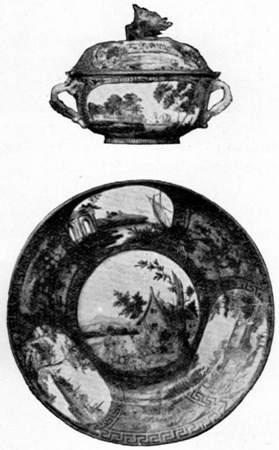
Fig. 115.—Écuelle.
Fig. 115, an écuelle, with blue ground, has gold fret[Pg 118] borders and oval medallions of Italian buildings, landscapes, and figures.
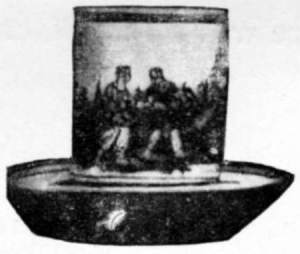
Fig. 116.—Cup and Saucer.
Fig. 116, the cup is painted with a garden scene, with a man and woman holding flowers, the former also holding a bird, the latter a cage.
Turin—Vinovo. Vittorio Amedeo Gioanetti established a manufactory of porcelain at Vinovo or Vineuf in 1770. Attempts in this direction had been previously made, but they were unsuccessful, and it was not until Gioanetti applied himself to the manufacture that it succeeded. The ware was noted for its fine grain and the whiteness of its glaze, as well as for the colours employed in its decoration.
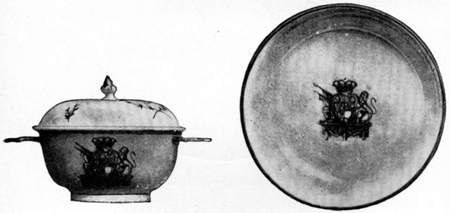
Fig. 117.—Écuelle.
[Pg 119]Fig. 117, an écuelle, is ornamented in gold, with initials and the Royal Arms.
Venice. Porcelain of soft paste was made here probably about 1720.
The “Casa eccellentissima Vezzi” was founded by Francesco Vezzi, a goldsmith of Venice. He invested the sum of 30,000 ducats in a porcelain company, amongst whose shareholders were Luca Mantovani and others. The site of the Vezzi manufactory of porcelain was at S. Nicolo in Venice. How long after Vezzi’s death it was carried on does not appear, but judging from the statements made to the Senate in 1765, it did not long survive him, and the secret of his process for making porcelain had evidently not been disclosed.
Materials for making porcelain were to be obtained in the Venetian dominions, but not such as to produce the hard or Oriental porcelain; they were therefore procured from Saxony, as were probably also some of the workmen, which will account for the fact that the “Casa eccellentissima Vezzi” produced both hard and soft paste.
The pieces made at the Vezzi manufactory are painted with masquerades, grotesque Chinese figures and decorations in relief, flowers, birds, arabesques, and geometrical patterns and colours, statuettes, &c., especially in the Venetian red which pervades all the decorations, the handles, borders, and mouldings being sometimes covered with silver or platinum, producing the effect of oxidised metal mountings. Another striking peculiarity in the decoration of porcelain of this period is a border of black or coloured diaper work formed by crossed lines, having in the interstices small gilt points or crosses bordered by scrolls. These specimens are mostly of hard paste in the form of bowls, plates, tureens, &c.

Fig. 118.—Vase and Cover.

Fig. 119.—Vase. Cozzi period.
Height 17 in.
A beautiful example of this porcelain is represented in Fig. 118, a vase and cover of hard paste painted in lake camaïeu, heightened by gold, with a continuous landscape; the peculiar border, noticed above, with marks and interlaced bands, is shown on the cover; the edges, knob, and flutings are raised and plated with silver or platinum.
After the Vezzi manufactory had ceased to exist we have no documents to prove that any efforts were made to introduce the manufacture of porcelain into Venice until December 1757, when a petition was presented to the Venetian College by Frederick Hewelcke & Co., who stated that the sale introduced and directed by them in Dresden[Pg 122] of Saxon porcelain had been carried on in a very flourishing manner, but that in consequence of the then existing war (the Seven Years’ War, which commenced in 1756), they had been obliged to abandon Saxony and to seek refuge in a foreign country.
On the 18th of March 1758, a decree granted to the Hewelckes the privileges they had requested. It seems that the undertaking proved eventually to be unfortunate, and at the termination of that war, which had brought them to Venice, they returned to their native country.
In 1765, the Senate granted to Giminiano Cozzi, in the Contrada di San Giobbe, Venice, protection and pecuniary assistance in carrying out a manufacture of porcelain. Cozzi’s first efforts were directed towards the imitation of the Oriental ware; and a very large trade was carried on by him for nearly fifty years. He produced statuettes in biscuit, in glazed white porcelain, and coloured groups, vases, &c. The gilding on Cozzi’s porcelain is especially fine, the pure gold of the sequin having been used in its decoration.
The manufactory ceased to exist in 1812.
Nove. The manufacture of porcelain at Nove may be traced back as far as the 12th January 1752, when Pasqual Antonibon brought from Dresden a certain Sigismund Fischer to construct a furnace for making porcelain in the Saxon style.
From this time forward he continued his experiments, and must have made great progress in the art, for in February 1761 he had three furnaces, of which one was for Saxon (ad uso di Sassonia),[Pg 123] the other two for French porcelain (ad uso di Francia).
In 1762, Antonibon submitted specimens of his porcelain to the Board of Trade, and petitioned that the patent rights which had been conceded to Hewelcke should be extended to him. At that time, the report states, Antonibon had at Nove a manufactory, rich in buildings, machinery, and tools. The capital embarked in it was estimated at 80,000 ducats, and so great was the sale of his products that he gave employment to 150 men and their families, in addition to 100 people employed in his retail business, carried on at his three shops in Venice. This extensive manufactory was, however, principally for maiolica.

Fig. 120.—Jardinière.
By Antonibon.
On the 7th April 1763, a decree was made in his favour; and he appears to have set earnestly to work in his manufacture of porcelain. His competitor,[Pg 124] Hewelcke, shortly after deserted Venice; but he had a more formidable rival in Giminiano Cozzi, who obtained a decree for making porcelain in 1765, in which Pasqual Antonibon’s manufacture is noticed, the Senate declaring it to be the duty of the magistrate to make such arrangements as would lead to an amicable understanding between the rival manufacturers and their workmen.

Fig. 121.—Vase.
Pasqual Antonibon and his son Giovanni Battista[Pg 125] continued the fabrication of porcelain until the 6th February 1781, when they entered into partnership with Signor Parolini. The same manufacture, con sommo onore dell’arte, was continued by them until the 6th February 1802, when it was leased to Giovanni Baroni, who produced some very charming pieces both in form and decoration; but in a few years, from being badly conducted, it began to fall off, and by degrees it went to decay and was abandoned. The “Fabbrica Baroni,” however, lingered on for more than twenty years.

Fig. 122.—Vase.

Fig. 123.—Milk-pot.
An example of the Baroni fabrique, in porcelain, with female figure handles, and painted with classical subjects, is given. (See Fig. 121.)
On 21st May 1825, the old firm of “Pasqual Antonibon and Sons” resumed the works, the actual proprietors being Gio. Batt. Antonibon and his son Francesco; they continued the manufacture of[Pg 126] porcelain until 1835, but all their efforts to sustain it were ineffectual; they could not compete with the porcelain manufactories of France and Germany, so they were compelled to abandon the factory.
Madrid—Buen Retiro. This manufactory (Soft Paste), called “La China,” was founded by Charles III. in 1759, in the gardens attached to his palace, El Buen Retiro, at Madrid. It was organised by workmen whom he brought with him from Naples. The early ware produced here consequently resembles that of Capo di Monte.

Fig. 124.—Group.
[Pg 128]The royal manufactory was taken possession of by the French, and the place converted into a fortification, which surrendered in 1812 to the Duke of Wellington. It was subsequently blown up by Lord Hill when the misconduct or perfidy of Ballasteros compelled him to evacuate Madrid.

Fig. 125.—Vase.
Height 22 in.

Fig. 126.—Vase.
With scenes from “Don Quixote.”
Height 17 in.
Ferdinand VII., on his restoration, recreated La China, at La Mancha, once a villa of the Alva family[Pg 129] on the Manzanares; but this factory also has ceased to exist, at least as regards artistic merit.
Alcora. The Comte de Laborde, in his View of Spain, in 1808, says, “On ne fait de Porcelaine (en Espagne) qu’à Alcora et à Madrid: celle d’Alcora est très commune, on en fait très peu.” In confirmation of this assertion M. Chas. Davillier, on a visit to Spain, saw an engraving of a furnace for baking porcelain with this inscription: “Modele de four pour la porselene naturele, fait par Haly pour M. le Comte d’Aranda Alcora, 29 Juin 1756.” The works are also noticed by Don Antonio Ponz, Viaje de España, in 1793.
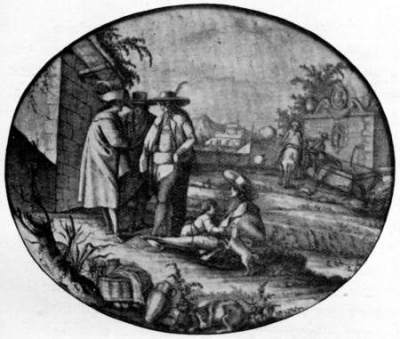
Fig. 127.—Plaque.
Dresden. The celebrated porcelain manufactory at Dresden, or rather at Meissen (in its vicinity), was established by Augustus II., Elector of Saxony, for the manufacture of true porcelain, that is, hard paste. The experiments of Tschirnhaus and Böttcher commenced about 1706, and to the latter is attributed the invention of hard paste. His first attempt was a red ware, like jasper, which was cut and polished by the lapidary, and ornamented by gilding; it was a fine stoneware, having the opacity, grain, and toughness of pottery. Later, Böttcher succeeded in discovering the mode of making true porcelain by the accidental detection of the kaolin necessary for the purpose. In consequence of this important discovery, Augustus II. established the great manufactory at Meissen, of which Böttcher was appointed Director in 1710, and about 1715 he succeeded in making a fine white porcelain. The first decorations upon this ware were very imperfect, consisting of a blue colour under the glaze, in imitation of Nankin blue porcelain. It was under Horoldt’s direction, in 1720, that paintings of a superior character, accompanied by gilding, and medallions of Chinese figures were introduced, and magnificent services completed.[Pg 131] In 1731, Kändler, a sculptor, superintended the modelling of animals, groups, vases, &c., while other artists painted birds, insects, and copies of paintings principally of the Flemish school. The best productions emanated from the Dresden manufactory from 1731 to 1756.

Fig. 128.—Vase.

Fig. 129.—Sucrier, Cup and Saucer.
Etched by Busch.

Fig. 130.—Cup and Saucer.
Of the Marcolini period, with gros bleu ground.
Kändler modelled men and animals of the natural size, as well as peacocks, herons, pelicans, and other birds. Among the pieces produced about this time by, or under the direction of, Kändler, at Meissen was Count Bruhl’s tailor mounted upon a goat, with all the implements of his trade about him. This vain man had a great desire that his likeness should be executed in porcelain at the royal manufactory, and his request was complied with, but probably not in such a way as to gratify[Pg 133] his vanity, for not only the tailor but his wife were thus immortalised, aere perennius, in porcelain. In 1754 Dietrich became Director, and he was succeeded in 1796 by Marcolini, whose beautiful productions are well known. Porcelain of his period is always distinguished by a star underneath crossed swords. In spite of the precautions taken at Meissen to prevent the secret becoming known—the penalty being death, or perpetual imprisonment in the Castle of Königstein—some workmen escaped to reveal it elsewhere.

Fig. 131.—Vase and Cover.
Painted with views of public buildings in Dresden.
The white Meissen porcelain was sometimes ornamented by private persons, especially by a Baron Busch, Canon of Hildesheim, who was the only person possessed of the secret of engraving with a diamond on china.

Fig. 132.—Bust of a Girl.
White porcelain.

Fig. 133.—Teapot and Saucer.
Pink ground, painted with landscapes and figures.
[Pg 135]Berlin. This manufactory for Hard Paste was established by Wilhelm Caspar Wegeli in 1751, in the Neue Friedrichsstrasse. It was carried on for about ten years, but it never remunerated the originator, and he abandoned it in 1761, when Gottskowski, a celebrated banker, became the purchaser, and removed the works to Leipziger Strasse; assisted by his capital, they were brought to great perfection.

Fig. 134.—Group.
In plain white. Wegeli period.
Height 9 in.
Johann Ernst Gottskowski obtained the secret of porcelain from Ernst Heinrich Richard, who had been employed by Wegeli. Gottskowski did not personally manage the manufactory, but placed it under the management of the Commissioner Grunenger, which led to his employment from the year 1763 to 1786 as the head of the royal porcelain manufactory at Berlin.
In 1763, Gottskowski gave up to the king the whole of his factory of porcelain, receiving 225,000[Pg 136] dollars, and entering into a contract for the sale of his secrets.

Fig. 135.—Group.
Wegeli period.
Height 6¾ in.
With a view to encouraging the manufacture in his kingdom, the king made presents of superb services of Berlin china to several German princes in the year 1766. When Frederick the Great occupied Dresden, in the seven years’ war, he expatriated many of the best modellers and painters to form his royal manufactory; among these were Meyer, Klipsel, and[Pg 137] Böhme. The king also transported great quantities of the clay and a portion of the collection. Independently of this, and the better to insure employment for the five hundred persons engaged in the processes, he restricted the Jews resident in any part of his dominions from entering into the marriage state, until each man had obtained a certificate from himself, which was only granted on the production of a voucher from the Director of the manufactory that porcelain to a given amount had been purchased, and that there was reasonable cause for granting the indulgence. Of course the Jews more readily disposed of their purchases than the general dealers, and the device was attended with favourable results. To insure the success of the establishment and extend its operations, Frederick embraced every opportunity that was presented; and it was so well supported that in 1776 seven hundred men were constantly employed, and it is said that three thousand pieces of porcelain were made daily.

Fig. 136.—Milk-pot, Cup and Saucer.
[Pg 138]In 1769 an order was published permitting a lottery company to purchase annually to the amount of 90,000 dollars.
About 1872, the Berlin Royal Porcelain Manufactory was working seven kilns, and employing three hundred workmen; the annual produce amounted on an average to half a million finished articles, value 150,000 Prussian dollars. The superintendence was entrusted to Herr Kolbe (who succeeded Herr Frick in the direction), under whom were Dr. Eisner as chemist, Herr Mantel as master modeller, and Herr Looschen as head painter.

Fig. 137.—Lamp-stand.
Höchst, a town situated on the Main, and now in Nassau, belonged to the Electors of Mainz. A manufactory was founded in 1746 by J. C. Göltz and J. F. Clarus, two merchants of Frankfort, assisted by A. von Löwenfinck, but they were unsuccessful, and called in Ringler, of Vienna, who had escaped from the manufactory. During the Electorate of Johann Friedrich Karl, Archbishop of Mainz, their porcelain ranked among the first in Europe. About 1760 the celebrated modeller Melchior was engaged, and some very elegant statuettes and designs for vases, &c., were produced. Melchior left the manufactory about 1785, and his successor, Ries, was not so skilful, and all his figures having disproportionate heads, the so-called “thick-head” period commenced. Christian[Pg 139] Gottlieb Kuntze was another celebrated worker in this fabrique. On the invasion of the French under General Custine in 1794, all the materials were sold by auction.

Fig. 138.—Tray and Sucrier.
Frankenthal, in Bavaria. Established in 1754, by Paul Hannong, who, having discovered the secret of hard porcelain, offered it to the royal manufactory at Sèvres, but the authorities not agreeing as to the price, the offer was declined, and they commenced persecuting him—for in that year a decree forbade the making of translucent ware in France except at Sèvres—and Hannong was compelled to go to Frankenthal, leaving his fayence manufactory at Strassburg in charge of his sons. In 1761 the factory was purchased by the Elector Carl Theodore, and it[Pg 140] attained great celebrity, which it maintained until he became Elector of Bavaria, in 1777. It then declined, and all the stock and utensils were sold in 1800 and removed to Greinstadt. The following chronogram denotes the year 1775:—
VarIantIbVs · fLosCVLIs · DIVersI · CoLores ·
fabrICæ · sVb · reVIVIsCentIs · soLIs · hVIVs ·
raDIIs · eXVLtantIs ·
In·frankenthaL· ✴
It occurs on a porcelain plate, Fig. 139, having in the centre the initials of Carl Theodore, interlaced and crowned, within a gold star of flaming rays; radiating from this are thirty divisions, and on the border thirty more, all numbered and painted with small bouquets, en camaïeu, of all the various shades of colour employed in the manufactory.

Fig. 139.—Plate.

Fig. 140.—A Déjeuner Service.
Neudeck, on the Au, and Nymphenburg. This factory was established in 1747, by a potter named Niedermayer. Graf von Hainshausen became its patron in 1754, and in 1756 he sent for Ringler, who organised the establishment, and it was then placed under the protection of the Elector Maximilian Joseph. On the death of his successor, Carl Theodore, in 1799, the Frankenthal manufactory was abandoned,[Pg 142] and transferred to Nymphenburg, which is still a royal establishment, and well supported. The pieces are manufactured in white at Nymphenburg, but chiefly decorated at Munich and elsewhere; that is the reason why on the same piece the Nymphenburg mark is frequently found impressed, with the mark of some other factory painted in colour.

Fig. 141.—Tankard.
Fig. 141, moulded in relief and painted with flowers; marks, the coat of Bavaria, 1765 in gold, two leaves and I. A. H. in green; height 7¼ in.
[Pg 143]Fig. 142, painted in colours; marks, the coat of arms of Bavaria, and A incised; diameter 3¼ in. and 5¼ in.
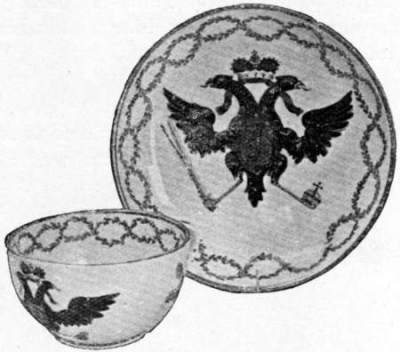
Fig. 142.—Cup and Saucer.

Fig. 143.—Cup and Saucer.
Anspach, a town which belonged to the Margraves[Pg 144] of Anspach and is now in Bavaria. There was a factory here about 1760.
Fig. 143 is painted with figures in colour; signed “Schelk, pinx.”; mark A in blue; diameter 3 ins. and 5¼ in.
Bayreuth was under the same rulers as Anspach, and is now also in Bavaria. There was a manufactory here in the 18th century, but little appears to be known respecting it.

Fig. 144.—Cup.
Fig. 144 is painted in colours, and gilt inside; mark, “Metzsch 1748 Bayr”; diameter 2¾ in.
Kelsterbach, in Hesse. A manufactory for pottery was founded here about 1758, where later[Pg 145] porcelain was also made. The works only lasted about sixteen years.

Fig. 145.—Harlequin.
Fig. 145 is painted in colours; mark, H. D. under a crown, in blue; height 6¾ in.
Thuringia. In the middle of the 18th century a number of small porcelain factories sprang up in this district. It is said that they owe their origin to a chemist named Macheleid, who discovered by accident a deposit of kaolin, and obtained permission from the Prince of Schwarzburg to establish a factory at[Pg 146] Sitzenroda, which in 1762 was removed to Volkstedt.

Fig. 146.—Cup and Saucer.
Diam. 2¾ in. and 5¾ in.
Closter, or Kloster, Veilsdorf, or Volkstedt. The porcelain manufactory of Sitzenroda was transferred to Volkstedt, in Thuringia, in 1762, where it was farmed by a merchant named Nonne, of Erfurt, who greatly enlarged and improved the works. About the year 1770 it was carried on by Greiner. In 1795 more than 120 workmen were employed.

Fig. 147.—Teapot.

Fig. 148.—Tray.
Fig. 148 is moulded in rococo style, and painted with flowers; mark, shield of Saxe-Meiningen between C. V.; length 12½ in.
Rudolstadt. The factory at Volkstedt was afterwards removed to Rudolstadt, near Jena. Gotthelf Greiner had the direction of several of the other Thuringian manufactories; he died in 1797.

Fig. 149.—Milk-pot and Cup and Saucer.
[Pg 148]Fulda, in Hesse. A factory was established here about 1763 by Arnandus, Prince-Bishop of Fulda, for the manufacture of porcelain. The best artists were employed, and many grand vases, figures, and services of a fine white paste and handsomely decorated were produced.

Fig. 150.—A Peasant.

Fig. 151.—A Peasant.

Fig. 152.—Cup and Saucer.

Fig. 153.—Coffee-pot.
Fürstenberg. In Brunswick, established in 1750, by the help of Bengraf, who came from Höchst; he died the same year, and Baron von Lang, a distinguished chemist, undertook the direction of the works, under the patronage of Carl, Duke of Brunswick. The manufactory was carried on by the Government up to the middle of last century.
Fig. 154, a bust of Augusta, Duchess of Brunswick, grand-daughter of King George II., is in white biscuit; mark, F in blue, a running horse, and W; height 20½ in.

Fig. 154.—Bust.

Fig. 155—Medallions.
In white biscuit.
[Pg 151]Fig. 155. Portraits of O. D. Beckmann and A. L. Schlötzer; marked with a running horse and F; length 2⅞ in.
Ludwigsburg, in Würtemberg. Established by J. J. Ringler in 1758, under the patronage of Carl Eugene, the reigning duke. It was celebrated for the excellence of its productions and the fine paintings on its vases and services, as well as for its excellent groups. This factory ceased in 1824.
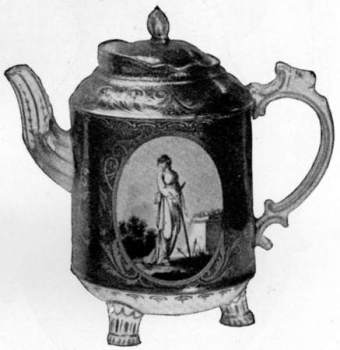
Fig. 156.—Chocolate-pot.
Fig. 156 is painted with figures of Hope and Music[Pg 152] in panels; mark, double C under a crown, in blue; height 5¼ in.

Fig. 157.—Coffee-pot.
Fig. 157 is painted in lake camaïeu, with a landscape and buildings after Claude, and has a gilt, arabesque and scroll border.
[Pg 153]Regensburg, or Ratisbon. This factory was established about 1760.

Fig. 158.—Cup and Saucer.
Grossbreitenbach. A factory was established here about 1770 by Greiner. The demand for his porcelain was so great, that not being able to enlarge his works at Limbach, he started this as well as Veilsdorf and Volkstedt.

Fig. 159.—Milk-pot.
Fig. 159 is grey blue ware in imitation of Wedgwood,[Pg 154] with classical group in white relief, bearing a wreath with the cypher F. G. C. under a crown; marks, “Breitenbach et Limbach,” and “Gruber”; height 4 in.
LIMBACH

Fig. 160.—Sucrier, Cover, and Stand.
[Pg 155]Limbach, Saxe-Meiningen. This manufactory was also under the direction of Gotthelf Greiner. It was established about 1762.
Fig. 160 is painted with flowers; mark, two letters L crossed; diameters 4⅞ and 8¼ in.
Gera. A manufactory was founded here about 1780.
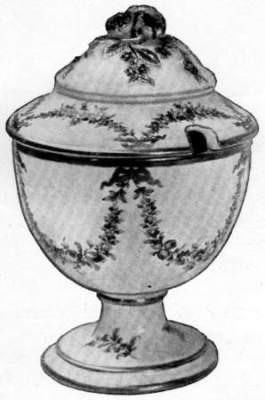
Fig. 161.—Sugar Basin.
[Pg 156]Fig. 161 is painted with festoons of pink flowers; mark, G in blue; height 6¼ in.

Fig. 162.—Cup, Cover, and Saucer.
Fig. 162 is grained in imitation of oak, with medallions painted with views, “Schloss aus dem Kohlenhofe” on cup, and “Lauchstaedt vor dem Brunnen” on saucer; signed, “Rühlig Fec”; mark, G in blue; diameters 3 and 5¼ in.
Baden-Baden. A porcelain manufactory was established in 1753 by the widow Sperl and workmen from Höchst, with the patronage of the reigning Margrave, under Pfälzer. It ceased in 1778.
GOTHA

Fig. 163.—Figure of Bacchus.
In white biscuit.
Height 11 in.
[Pg 158]Gotha. Founded in 1780 by Rothenberg, and afterwards (1802) conducted by Henneberg.
Rauenstein, in Saxe-Meiningen. A factory for hard paste was established here in 1760.

Fig. 164.—Cup and Saucer.
Fig. 164 is painted with flowers; mark, R—n; diameters 3 and 5 in.
Wallendorf, in Saxe-Coburg. There was also a factory for hard paste established by Greiner and Haman here in 1762.
[Pg 159]Fig. 165 is painted in dark blue, and with leaves in relief; mark, W, in blue; height 10 in.

Fig. 165.—Vase.
This manufactory for hard paste was founded about 1717. There are several traditions as to its origin: one is that a musician named La France, and a billiard-marker, named Dupuis, brought with them to Vienna, in October 1717, a certain Cristofle Conrad Hünger, who had been employed at Meissen as an enamel painter and gilder, and that in the following year they were joined by a man named Stölzel of Meissen, who was possessed of the secret, and became director. Another that it was a private enterprise set on foot by Claude du Pasquier, who obtained from the Emperor Charles VII. a privilege for twenty-five years. Major Byng Hall (Adventures of a Bric-à-Brac Hunter), however, says that it was established in 1718 by Claude Innocenz de Blaquier, who engaged one Stenzel or Stölzel to co-operate with him. With this object in view De Blaquier proceeded secretly to Meissen, where he contrived to scrape acquaintance with the arcanist in a coffee-house. He engaged with Stenzel in a game of billiards, taking care to lose, and thus he secured his object. Stenzel after some slight hesitation, accepted an offer of a thousand dollars to be paid yearly.

Fig. 166.—Cabaret.
De Blaquier had to contend with many difficulties owing to his not being possessed of the secret, and at the end of the second year Stenzel not having been paid regularly according to his contract, returned to Meissen, after having maliciously destroyed many of[Pg 162] the models. The works had consequently to be suspended. But De Blaquier, being a man of energy and determination, endeavoured by numerous experiments to discover the porcelain mixture, and his efforts were finally crowned with success.

Fig. 167.—Milk-pot.
After twenty-five years’ labour De Blaquier decided in 1744 to offer the works to the Government.
The young Empress Maria Theresa resolved to support the factory, which promised to give occupation and profit to her subjects, honour and gain to[Pg 163] the State. She therefore commanded that it should be taken by State contract from its owner, and that De Blaquier should receive the direction with a salary of 1500 florins a year.

Fig. 168.—Plate.
From 1747 to 1790 was the best period for figures and groups, while from 1780 to 1820 painting on china became celebrated, the subjects being taken from paintings by Watteau, Lancret, Boucher, Angelica Kauffmann, and others.
[Pg 164]In 1785 the most important improvements were made under the Baron de Lorgenthal or Sorgenthal; artists of the highest talents were employed, a first-rate chemist named Leithner was engaged to prepare the colours and gilding, the chefs d’œuvre of the early masters were copied, while the gilding was brought to a perfection which has never been surpassed.

Fig. 169.—Cup and “Trembleuse” Saucer.
18th Century.
After the death of the Baron in 1805, Neidermayer became Director. The manufacture continued[Pg 165] in its flourishing condition until about 1815. From the year 1784 to the date of its extinction, it was the custom to mark every piece with the number of the year, which circumstance may be of great service to the connoisseur who seeks early specimens of Vienna porcelain. It is stamped without colour underneath the piece—or rather indented, the first numeral being omitted; thus the number 792 stands for 1792; 802 for 1802; and so on.
From 1827, under the direction of Scholtz, who followed Niedermayer, the manufactory began to decline, and what with economy, indifferent workmen, and bad artists copying from French models its doom was sealed. It gradually dwindled down to a second-rate factory, and in consequence of the great annual expense it was discontinued in 1864. The books on art belonging to the factory, and all the drawings of its most successful period, together with many of the models, the library, and the keramic collection, were given to the Imperial Museum in Vienna, to be retained as a lasting memorial of its celebrity.
Fig. 166 is painted in camaïeu on purple ground, and gilt; mark, shield crowned; length of tray 12 in.
Fig. 167 is painted in colours and gilt, with busts of ladies, entitled “L’Hérisson” and “Fantaisie Moderne”; mark, the shield in blue; height 6 in.
Fig. 168 is painted in colours, with two nymphs in a landscape playing with the infant Bacchus; mark, the Austrian shield of arms, in blue; the painting attributed to Fürstler.
[Pg 166]Schlaggenwald, in Bohemia. This manufactory was established in the year 1810. George Lippert was the owner in 1842, and much improved the industry. Some pieces are marked “Lippert & Haas.”
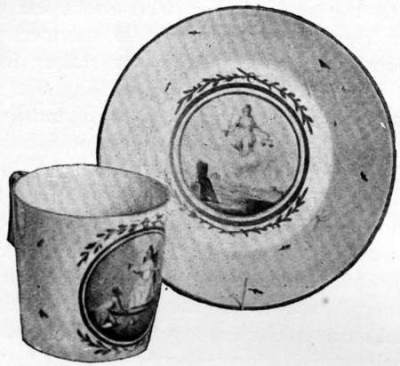
Fig. 170.—Cup and Saucer.
Fig. 170 is painted in colours, with medallions containing figures of Justice; mark, S; diam. 2½ and 5 in.
Herend, in Hungary. There was a manufactory of porcelain here towards the end of the 18th century, but particulars concerning its origin are not known.
Fig. 171 is painted in oriental style, with flowers, &c.; late 18th century.[Pg 167]

Fig. 171.—Portion of a Cabaret or Breakfast Service.
Nyon, on the lake of Geneva. A manufactory was in full work here towards the end of the 18th century. It is said to have been established by a French flower painter named Maubrée, and several Genevese artists painted on the porcelain, occasionally marking it with a “G” or “Geneva” in full; but there never was a manufactory of china at Geneva itself.

Fig. 172.—Cup and Saucer.
Zürich. Established here in 1763 by a few Zürich gentlemen, with the aid of a workman, named Spengler, from Höchst. Another German, Sonnenschein, a sculptor, was employed to model figures and groups. The factory was not a financial success. In 1793 the works were sold to a potter named Nehracher, and on his death in 1800 the works ceased.[Pg 169]
NYON

Fig. 173.—Cup and Saucer.
With mark, fish in blue.
Fig. 174 represents a soldier trampling on a Turk and unveiling a lady, martial and love trophies on the ground.

Fig. 174.—A Group.
Weesp. The first manufactory for porcelain in Holland was at Weesp, near Amsterdam. It was established in 1764 by the Count Cronsfeldt-Diepenbroick, who had by some means obtained the secret of the composition of hard paste. After existing seven years, the factory was closed in 1771. Notwithstanding the unsuccessful result from a commercial point of view, it was reopened by a Protestant minister, the Rev. De Moll, of Oude Loosdrecht, associated with some capitalists of Amsterdam, but the next year it was removed to Loosdrecht. The decorations are very much of the Saxon character.
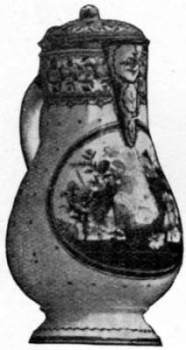
Fig. 175.—Ewer.
With mark, W.

Fig. 176.—Coffee-pot.
Mark, a cross and dots.
[Pg 171]Oude Loosdrecht, situated between Utrecht and Amsterdam, was the next town where porcelain was successfully made. It sprang from the ashes of Weesp, and in 1772 became a company, with the Rev. De Moll at its head; after his death, in 1782, the concern passed into the hands of his partners, J. Rendorp, A. Dedel, C. Van der Hoop, Gysbz, and J. Hope, and was by them removed, in 1784, to Oude Amstel. The ware is of fine quality, decorated in the Saxon style; specimens are frequently met with, having gilt borders and a light blue flower between green leaves.
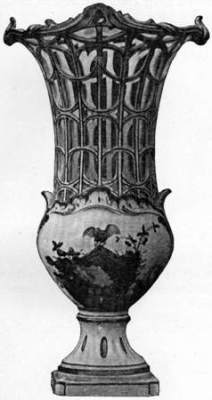
Fig. 177.—Vase.

Fig. 178.—Panel.
Mark, M : o L. in blue.
Width 12¾ in.
Amsterdam. Fig. 179. Painted in lake camaïeu with birds and trees; the mark, lion, in blue.

Fig. 179.—A Pair of Bottles.
[Pg 173]Oude Amstel. On the death of the Rev. De Moll in the year 1782, the manufactory of Loosdrecht was removed to Oude Amstel (Old Amstel), near Amsterdam, and carried on with redoubled zeal by the same company, directed by a German named Däuber, about 1784. It flourished under his direction for a few years, and produced a fine description of porcelain, but it gradually declined, in consequence of the large importations from England which inundated the country. In 1789 it came into the hands of J. Rendorp, C. Van der Hoop, and Gysbz, still remaining under Däuber’s direction, but it was entirely demolished at the close of the 18th century.

Fig. 180.—Teapot and Sucrier.

Fig. 181.—Sucrier.
[Pg 174]The Hague. About the year 1775, a porcelain manufactory for both hard and soft paste was opened at The Hague, under the direction of a German named Leichner or Lynker. The works ceased in 1785 or 1786.

Fig. 182.—Plate.
Of soft paste.
Fig. 182 bears the mark of a stork in blue; diam. 9½ in.
Tournai. Established in 1750 by Peterinck. For some time previous to 1815 the works were carried on by M. Maximilien de Bettignies, who, in consequence of the annexation of Tournai to Belgium, ceded it in that year to his brother Henri, and established another factory at St. Amand-les-Eaux. Soft paste, which has been discontinued for many years in every other fabrique in France, is still made at both places, and they consequently produce the closest imitations of old Sèvres pâte tendre.
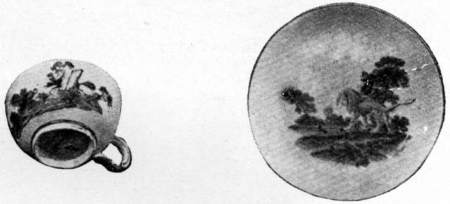
Fig. 183.—Cup and Saucer.
With the early mark in gold.
Fig. 184 is painted in blue; mark, crossed swords and three crosses; diam. 9½ in.

Fig. 184.—Plate.

Fig. 185.—Salt-cellar.
[Pg 177]Fig. 185 is painted with birds; mark, crossed swords and four crosses, in gold; height 4⅜ in.
Brussels. There was a manufactory of hard paste porcelain here towards the end of the 18th century.

Fig. 186.—Milk Jug.
Signed L. Cretté.

Fig. 187.—Teapot.
A factory for hard paste porcelain was established at Sept Fontaines about 1806, by the brothers Boch. Both pottery and porcelain were made here, including plates, vases, figures, &c.
LUXEMBURG

Fig. 188.—Two Figures of “The Seasons.”
With mark, B. L.
At St. Petersburg, an Imperial china manufactory was established in 1744, by the Empress Elizabeth Petrowna, with workmen from Meissen. Catherine II. patronised the works, and in 1765 enlarged them considerably, under the direction of the minister, J. A. Olsoufieff, since which this fabrique has held a distinguished place among European manufactories. The paste is hard and of a blueish cast, finely glazed, and it betrays its Dresden origin.

Fig. 189.—Cup and Saucer.
With the mark of the Emperor Paul.

Fig. 190.—Verrière.
[Pg 180]Moscow, 1720. The potter Eggebrecht, who had undertaken a manufactory of delft at Dresden, by direction of Böttcher, had, after that was discontinued, left to go to Moscow, and, being acquainted with some of the processes for making porcelain, commenced manufacturing it at Moscow.

Fig. 191.—Statuette.
Mark, G in blue.
Height 8 in.

Fig. 192.—Cup and Saucer.
With view of Moscow. Mark, A. Popoffe’s initials.
A porcelain manufactory was established at Twer, by an Englishman named Gardner, in 1787, and another by A. Popoff.
[Pg 182]Korzec, in Volhynia. About 1803, Mérault, a chemist of the Sèvres manufactory, went to direct the fabrique at Korzec, taking with him a laboratory assistant named Pétion. After carrying it on for a few years, Mérault abandoned the direction, and returned to France.

Fig. 193.—Pâte dure Cup and Saucer.
Painted with a
portrait of a lady, en grisaille, with gilt borders.
Mark, Eye within a triangle.
Baranowka, in Volhynia. A small factory existed [Pg 183]here at which the porcelain clay found in the neighbourhood was used.

Fig. 194.—Milk Jug.
Mark, the name of the town.
Marieberg. This manufactory produced porcelain (soft paste), as well as fayence. In quality as well as in decoration the porcelain is like that of Mennecy-Villeroy in France. The industry was established by Ehrenreich, under the patronage of Count Scheffer, Councillor of State, in 1750, and altogether ceased about 1780.

Fig. 195.—Custard Cup and Cover.
Mark, M.B. combined.
Height 3¼ in.
Copenhagen. This manufactory was commenced by an apothecary of the name of Müller, in 1772, and Baron von Lang, from the Fürstenberg manufactory, is said to have been instrumental in forming it. The capital was raised in shares, but the factory not being successful, the Government interfered, and it became a royal establishment in 1775, and has remained so ever since.

Fig. 196.—Cabaret.
With portraits of Raphael, and other celebrated painters.

Fig. 197.—Cabaret.
St. Cloud. A factory was established here about 1695 for the production of porcelain, at which time M. Morin was proprietor, and M. Chicanneau director of the works.
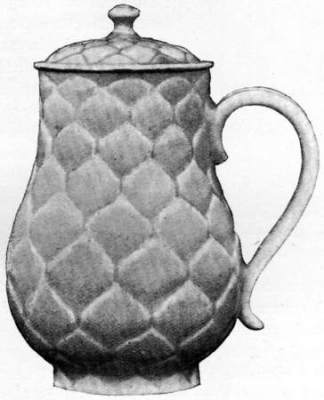
Fig. 198.—Jug.
[Pg 188]According to letters patent of 1702, granted to the heirs of Chicanneau, his widow, Barbe Courdray, and her children, were interested in the works; their father had made many experiments and attempts to discover the secret of true porcelain, and from the year 1696 had produced some nearly equal to the porcelain of China. His children, to whom he imparted the secret, successfully continued the fabrication, and were permitted to manufacture porcelain at St. Cloud, or in any other part or parts of the kingdom, except Rouen and its faubourgs. In 1712 a renewal of the patent took place for ten years, and in the meantime the widow Barbe Courdray married a M. Trou.

Fig. 199.—Statuette.
Astronomy seated, holding the sun.
In 1722 letters patent were granted for twenty years more to Jean and Jean Baptiste Chicanneau, Marie Moreau, the widow of Pierre Chicanneau (third son) and Henri and Gabriel Trou, children of Barbe Courdray by her second marriage. About this time serious disagreements occurred between the two families, and they separated, Gabriel and Henri Trou remaining at St. Cloud, patronised by the Duke of Orleans; while Marie Moreau opened another establishment in the Rue de la Ville l’Évêque, Faubourg St. Honoré, directed by Dominique François[Pg 189] Chicanneau. In 1742 another arrêt granted privileges for twenty years to both these establishments, and Marie Moreau dying in 1743 left Dominique her business.
The manufactory at St. Cloud was destroyed by fire (the act of an incendiary) in 1773, and the manufacture ceased, the proprietors not being able to raise sufficient funds to rebuild it.
Chantilly. This manufactory was founded in 1725 by Ciquaire Cirou, under the patronage of the Prince de Condé, as appears by letters patent dated 1735, who was succeeded by Antheaume and others. The porcelain was highly esteemed, and there was hardly any object which they did not produce, from the lofty vase to the simplest knife handle. The Chantilly pattern was a great favourite for ordinary services; it was called “Barbeau,” and consisted of a small blue flower running over the white paste.

Fig. 200.—Dish.
Mark, hunting horn and P, in gold.
Diameter 12 in.

Fig. 201.—Pair of Figures.
Rouen. Louis Poterat, Sieur de St. Ètienne, of St. Sever, at Rouen, obtained letters patent in 1673,[Pg 191] stating that he had discovered processes for fabricating porcelain similar to that of China, and wares resembling those of Delft; but the former was of a very rude character and never arrived at any perfection.
After the establishment at St. Cloud had commenced selling porcelain, the proprietors of the Rouen manufactory appear to have revived their porcelain in the hopes of competing with them, but with no good result.
Mennecy-Villeroy. This important manufactory was established in 1735 by François Barbin, under the patronage of the Duc de Villeroy. The early specimens are similar to the porcelaine tendre of St. Cloud, of a milky translucent appearance.
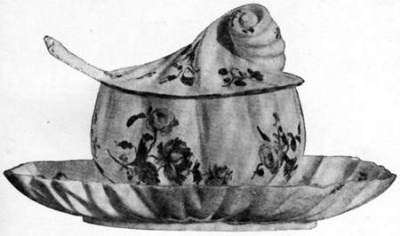
Fig. 202.—Sugar Basin and Stand.
Barbin was succeeded about 1748 by Messieurs[Pg 192] Jacques and Jullien, and the manufactory continued in a flourishing state until 1773, when on the expiration of the lease it was removed to Bourg-la-Reine.
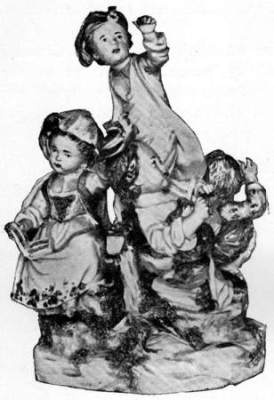
Fig. 203.—Group of Children.
Sceaux Penthièvre, near Paris. Established in 1750 by Jacques Chapelle; it was situated opposite the Petit Châtelet, and was under the patronage of the Duc de Penthièvre. It was carried on by Glot in 1773. The Prince-Protector died in 1794,[Pg 193] but the production of pâte tendre ceased before that time.

Fig. 204.—Cup and Saucer.

Fig. 205.—Milk-pot.
Mark, S. X.
Arras. Established in 1782 by the Demoiselles Deleneur, under the patronage of M. de Calonne, Intendant de Flandre et de l’Artois; it only lasted a few years.
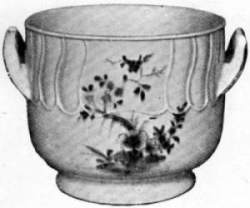
Fig. 206.—Seau.
Mark, A. R.
[Pg 194]Boulogne-sur-mer. Established by M. Haffringue, in the 19th century, with the kaolin of Limoges.

Fig. 207.—Plaque.
White biscuit.

Fig. 208.—Sucrier.
White biscuit.
[Pg 195]Étiolles (Seine-et-Oise), near Corbeil. Established in 1768, by Monnier, for soft paste porcelain. The works lasted only a short time.
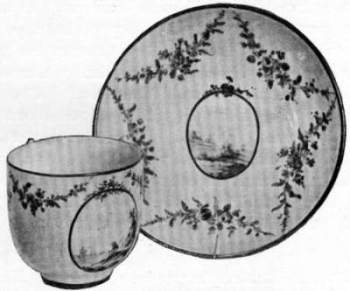
Fig. 209.—Cup and Saucer.
Mark, E. Pellevé, 1770.
Diameter 2½ and 5 in.
Lille. Established in 1711 by Barthélemy Dorez and Pierre Pelissier, his nephew, natives of Lille.[Pg 196] The porcelain (pâte tendre) of this time was like that of St. Cloud, but in the Delft style, the favourite ornamentation being Chinese designs. At a later period (in 1784) a manufactory of hard porcelain was established by Leperre Durot, under the patronage of the Dauphin; it was styled “Manufacture Royale de Monseigneur le Dauphin.” The porcelain of Leperre Durot is richly adorned with gold and with carefully painted bouquets of flowers.

Fig. 210.—Cup and Saucer.
With mark, crowned Dolphin.
M. Roger succeeded Leperre Durot, and in 1792 he sold his interest in the works to Messieurs Regnault and Graindorge; they were, however, soon ruined, and the establishment was closed.
Bourg-la-Reine. Started in 1773 by Messieurs Jacques and Jullien, who removed thither on the expiration of their lease at Mennecy. It was in active existence, making china purely of an industrial character, in 1788.

Fig. 211.—Custard Cup.
Mark, B. R.
Height 3¼ in.
[Pg 197]Clignancourt. Established in 1775 by Pierre Deruelle, under the patronage of Monsieur le Comte de Provence, brother of the king (afterwards Louis XVIII.).

Fig. 212.—Milk-pot and Cover.
Fig. 213.—Cup and Dish. Fig. 214.—Milk Jug.
[Pg 198]Lunéville. A factory called “Manufacture Stanislas” was established in 1731. It lasted only a short time, but a later manufactory, founded about 1769, was celebrated for its productions.
Paul Louis Cyfflé, sculptor, obtained, in 1768, letters patent for fifteen years, by virtue of which he established another manufactory for superior vessels of the material called terre de Lorraine, and in the following year a new privilege was granted for making groups and statuettes with his improved paste, under the name of pâte de marbre.
Orleans. Established by M. Gerréault in 1753, under the protection of the Duc de Penthièvre; the porcelain first made here was of the soft paste, but hard paste was subsequently produced. Gerréault was succeeded by Bourdon fils about 1788, Piédor, Dubois, and lastly, Le Brun, from 1808 to 1811.
Niderviller. Established about 1760 by Baron de Beyerlé. After successfully carrying on this branch for several years, he attempted hard porcelain in 1768, and procured potters and artists from Saxony. Three or four years before his death, which happened in 1784, the estate was bought by General de Custine. This new proprietor continued the fabrique, under the direction of M. Lanfray, who paid especial attention to the production of fine porcelain; the fabrication of statuettes was greatly increased.
ORLEANS

Fig. 215.—Bowl, Cover, and Stand.
Mark, heraldic label in blue.
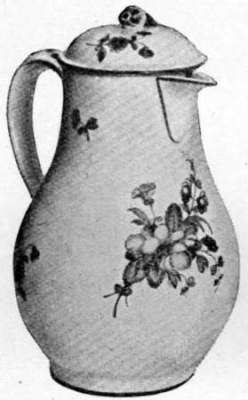
Fig. 216.—Milk-pot and Cover.
Mark, double C under coronet, in blue.
Height 6½ in.
After the decapitation of the unfortunate de Custine, his estates, being forfeited to the Republic, were sold on the 25 Germinal, An X (1802), to M. Lanfray, and carried on by him until his death in 1827, when the manufactory was sold to L. G. Dryander, of Saarbrücken. For many years he continued to make porcelain, as well as fayence groups and statuettes, but the distance of his fabrique from the kaolin of St. Yrieix prevented him from competing successfully with those of Limoges, and this branch was abandoned.
Boissette, near Melun. A factory was [Pg 201]established in 1777 by Jacques Vermonet père et fils, but it lasted only a short time.

Fig. 217.—Teapot.
Caen, Normandy. Established and supported by some of the principal inhabitants, at the time of the French Revolution (about 1793), when several workmen from Sèvres came to join it. It was carried on for a few years, but no market being found for the ware, the factory was discontinued at the commencement of the last century. It is hard paste, and equal to that of Sèvres, and of the same forms.

Fig. 218.—Cup and Saucer.
With “Caen” stencilled in red.
Valenciennes (Nord). By an Order of Council, dated 24th May 1785, M. Fauquet was permitted to[Pg 202] carry on a manufacture of porcelain at Valenciennes. He was originally established at St. Amand in the manufacture of fayence as early as 1775, and probably carried on both works simultaneously.

Fig. 219.—Cup and Saucer.
Mark, F. L. V., in cipher, in
blue.
Diam. 3¾ and 6¼ in.
St. Amand-les-eaux. Founded by M. Maximilien de Bettignies in 1815, for the manufacture of pâte tendre porcelain like the old Sèvres. He was formerly proprietor of the Tournai manufactory, which he ceded to his brother Henri when that city became re-annexed to Belgium.
Strassburg. About the year 1752, Paul Hannong obtained the secret of true porcelain from[Pg 203] Ringler, and started a factory here, but in consequence of the monopoly of Sèvres he was compelled to relinquish it, and in 1753 removed to Frankenthal, where he greatly flourished under the protection of the Elector Palatine Carl Theodore.

Fig. 220.—Cup and Saucer.
Mark, J. H.
Diam. 2⅝ and 5⅝ in.
Marseilles. An important manufactory of porcelain was established here by Jacques Gaspard Robert about 1766. Porcelain was made also by Honoré Savy and Veuve Perrin, but was only of secondary importance. The works were closed about the period of the French Revolution in 1793.
Paris. Rue Thiroux. Established in 1778 by[Pg 204] André Marie Lebeuf, and the ware was called “Porcelaine de la Reine.”

Fig. 221.—Sucrier.
Mark, crowned A.
Paris. Rue de Bondy. Opened in 1780 by Dihl and Guerhard, under the patronage of the Duc d’Angoulême, and the ware was called “Porcelaine d’Angoulême.”

Fig. 222.—Ewer and Basin.
[Pg 205]Paris. Rue Fontaine au Roi. This factory, called “De la Courtille,” was established in 1773 by Jean Baptiste Locré, who was afterwards joined by Russinger in 1784. The latter during the Revolution became sole director.

Fig. 223.—Part of a Tea Service.
Paris. Faubourg St. Honoré. A factory was established here by Veuve Chicanneau, née Marie[Pg 206] Moreau. The teapot, Fig. 224, was probably made at these works.

Fig. 224.—Teapot.
Mark, Ve M. & C.
Paris. Pont-aux-Choux. In 1784, Louis Honoré de la Marre de Villars opened an establishment for the manufacture of porcelain in the Rue des Boulets, Faubourg St. Antoine. It was afterwards disposed of to Jean Baptiste Outrequin de Montarcy and Edmé Toulouse, who in 1786 obtained a brêvet from the Duke of Orleans, Louis Philippe Joseph, and authority to sign the productions with the letters L. P., and to take the title of Manufacture de M. le Duc d’Orléans. They were afterwards established in Rue Amelot, au Pont-aux-Choux, by which name the porcelain is generally known.

Fig. 225.—Teapot.
[Pg 207]The former name ceased in 1793, with the condemnation of the Duke of Orleans, and the objects subsequently produced were inscribed merely “Fabrique du Pont-aux-Choux.”
Paris. Rue de Crussol. Established in 1789 by Charles Potter, an Englishman, and the ware was called the “Prince of Wales’s China.”

Fig. 226.—Cup.
Paris. Belleville. Originally established in 1790 by Jacob Petit; but later removed to Fontainebleau. The products of the first period were much esteemed, being well painted and well modelled, bearing Petit’s mark; but the proprietor unwisely altered his original plan and imitated Dresden, counterfeiting also the mark of the crossed swords. Jacob Petit also made biscuit figures, birds’ nests, flowers, &c.

Fig. 227.—Watch-stand.
Plain white of rococo form.
Mark, J. P. in blue. Height 5 in.
[Pg 208]Paris. Rue du Faubourg St. Denis. Fabrique de Charles Philippe Comte d’Artois, afterwards Charles X. This manufacture was the most ancient of all those established in Paris. Hannong of Strassburg, who brought into France the secret of hard porcelain, formed the first establishment in 1769. Having obtained the protection of Charles Philippe, Comte d’Artois, it was called by his name. The factory belonged actually to Bourdon des Planches, who continued the manufacture of hard porcelain, &c., but the works were closed in 1810.
Vincennes. There was a porcelain manufactory here in 1786, quite apart from the royal factory. It was directed by M. Le Maire, probably the same who founded that in Rue Popincourt, which was ceded to M. Nast in 1783. There were four establishments at Vincennes; the first by the brothers Dubois, subsequently transferred to Sèvres; the second by Maurin des Aubiez, in 1767; the third by Pierre Antoine Hannong; and the fourth that described above.

Fig. 228.—Cup and Saucer.
Mark, H. L. L., in gold .
Diam. 2½ and 5 in.
The history of the celebrated manufactory at Sèvres must be traced back to that of St. Cloud, which was founded as early as 1695. Here Louis XIV. accorded his patronage and favour by granting exclusive privileges. In 1735 the secret of the manufacture was carried, by some of the workmen, to Chantilly, and for a time continued there by the brothers Dubois. They left in a few years, taking with them their secret, and settled at Vincennes, where a laboratory was granted them, but after three years they were dismissed.
In 1745, a sculptor, named Charles Adam, formed a company, and the scheme was approved of by the king, privileges being accorded them for thirty years, and a place granted for their works in the Château de Vincennes. In 1753 the privileges of Charles Adam were purchased by Eloy Brichard, and Louis XV. took a third share; hence the factory became a royal establishment. Madame de Pompadour considerably encouraged the ceramic art, and it arrived at the height of perfection. The buildings were found too small to meet the increasing demands for the beautiful productions, and in 1756 the works were[Pg 210] removed to a large edifice at SÈVRES built expressly for the company.
A favourite decoration of Vincennes porcelain was flowers and birds, on a beautiful bleu de roi ground, and cupids painted in camaïeu of a single colour.

Fig. 229.—Vase.
Bleu de roi ground, with panels with birds in gold.
Mark, double L enclosing a dot, in gold.
Height 9¼ in.
In 1760 the king became sole proprietor, and M. Boileau was appointed director.
[Pg 211]In 1769, after Macquer had brought the making of hard paste to perfection, the manufacture was successfully established at Sèvres, and both descriptions of china continued to be made until 1804, when, Brongniart being director, soft paste was altogether discontinued, and declared to be “useless in art, of expensive manipulation, dangerous to the workmen, subject to great risk in the furnace, &c.”
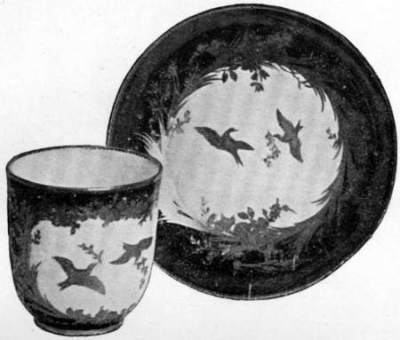
Fig. 230.—Cup and Saucer.
Bleu de roi ground, with white medallions enclosing birds in gold.
Mark, double L, in blue.
Diam. 2⅝ and 5⅜ in.
The principal colours used in decorating the ground of the Sèvres vases were:—
1. The bleu céleste, or turquoise, invented in 1752 by Hellot.
2. The rich cobalt blue, called bleu de roi, of which there were two varieties, the darker being designated gros bleu.
[Pg 212]3. The violet pensée, a beautiful violet from a mixture of manganese, one of the rarest decorations of the pâte tendre.
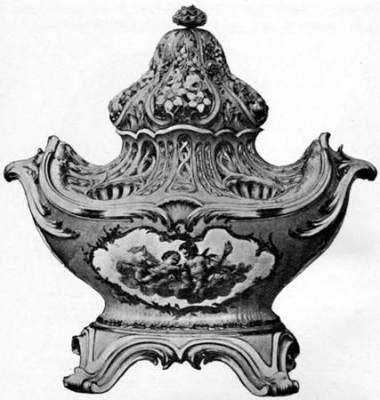
Fig. 231.—Vase.
4. The rose Pompadour (called in England rose Du-Barry), a charming pink or rose colour invented in 1757 by Xhrouet of Sèvres.
[Pg 213]5. The clear yellow or jonquille, a sort of canary colour.
6. The vert pré, or bright grass green.
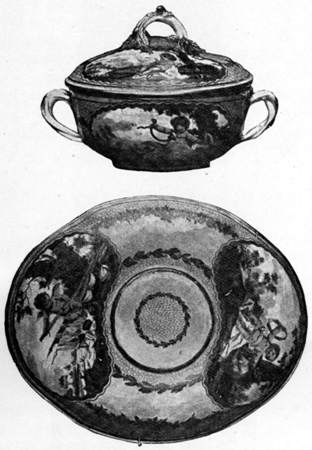
Fig. 232.—Écuelle.
Dated 1771.
7. The vert pomme, or apple green.
8. The rouge de fer, a brilliant red.
9. The œil de perdrix was at a later period a favourite ornament for the grounds of vases.

Fig. 233.—Biscuit Group. Cupid and Psyche.
[Pg 215]The forms are exceedingly varied, but names are assigned to each, either from the designers of the models or their special shapes or ornamentation; these may be found at length in Marks and Monograms on Pottery and Porcelain, 10th edition.
The beautiful pâte tendre ware of Sèvres was always much esteemed, and never could have been produced at a reasonable price even at the time it was made, the expense of decoration as well as the risk in firing being so great. It was manufactured for royal presents or occasionally sold by express permission at exorbitant prices, which bore a more approximate value to the present exorbitant prices than is generally supposed.
The earthenware vessels made in England previous to the 16th century were of a very coarse description, rudely fashioned and usually devoid of ornament, sometimes cast in a mould in grotesque forms, and occasionally covered with a yellow or green glaze. Numerous specimens of early English cups are found in excavations in London and other parts of England, and may be identified by comparison with the vessels in Norman and mediæval manuscripts.
Although inexpensive, they were badly burned, and not very durable; and the German stoneware with a salt glaze was eagerly sought after throughout the 16th century, and imported in large quantities. These stone pots were usually impressed with the arms of German towns; a rose or other device in front, and a ferocious bearded visage under the spout. They were derisively called bellarmines, after the celebrated Cardinal Bellarmin, who in the 16th century made himself so conspicuous by his zealous opposition to the Reformed religion.
These bellarmines were in general use throughout England in the 16th and beginning of the 17th century at inns and public-houses for serving ale to[Pg 217] the customers. The importation of these stone pots was always monopolised by the potters of Cologne, near which city they were made. In the reign of Queen Elizabeth we find one William Simpson presenting a memorial that he may be allowed to bring “the drinking stone pottes made at Culloin” into this country, and requesting permission to make similar stone pots in England; but he was not successful in his suit.
In 1626, however, two other potters, named Rous and Cullyn, merchants of the city of London, obtained the exclusive privilege of making stone pots and jugs in this country, and a patent was granted them for fourteen years; the preamble states that “heretofore, and at this present, our kingdom of England has been served with stone pottes, stone jugges, and stone bottells, out of foreign parts, from beyond the seas.”
When Dr. Plot wrote his natural history of this county in 1686 there were very few manufactories of pottery; he only speaks of one at Amblecott and another at Wednesbury; but he says: “The greatest pottery they have in this country is carried on at Burslem, near Newcastle-under-Lyme.” The earthenware made here towards the end of the 17th century was of a very coarse character, and the decoration extremely rude, consisting merely of patterns trailed over the surface in coloured clay, technically termed slip, diluted to the consistence of syrup, so that it could run out through a quill. The[Pg 218] usual colours of these slips were orange, white, and red, the orange forming the ground and the white and red the paint. After the dishes had been thus ornamented they were glazed with lead ore beaten into dust, finely sifted, and strewed over the surface, which gave it the gloss but not the colour. The vessels remained twenty-four hours in the kiln, and were then drawn for sale, principally to poor cratemen, who hawked them at their backs all over the country.

Fig. 234.—Tyg. With four handles.
Dated 1621.

Fig. 235.—Mug. With two handles.
Dated 1682.

Fig. 236.—Plateau. With Charles II. and his Queen, in relief.
By Ralph Toft. 1677.
The forms of these vessels were tygs or mugs, with two or more handles for passing round a table, candlesticks, dishes, &c. The earliest names found upon them are Thomas and Ralph Toft, William Talor, Joseph Glass; all names still known in Staffordshire.
[Pg 220]Burslem. The family of Wedgwood was of long standing at Burslem, and many members of it were employed in making pottery long before the birth of the great potter, Josiah Wedgwood. His father, grandfather, and great-grandfather, as well as many of his other relations, were all engaged in the trade. Josiah Wedgwood was born in 1730, at Burslem; he was the youngest of thirteen children; his father, Thomas Wedgwood, died when Josiah was only nine years old. His eldest brother, Thomas, succeeded his father as a potter, and Josiah was bound apprentice to him in 1744, after the expiration of which he left his brother’s house to make knife handles, imitation agate, and tortoiseshell small wares, at Stoke. Here, in 1752, he entered into partnership with John Harrison, which only lasted two years.

Fig. 237.—Vase.
Pale blue jasper, with subjects in relief.
Next Josiah Wedgwood went into partnership with Thomas Whieldon of Fenton Low, one of the most eminent potters of his day, and they remained [Pg 221]together five years; while here Wedgwood also produced that fine green glaze which covered his dessert services, in imitation of leaves.
At the expiration of the partnership in 1759 Wedgwood returned to Burslem, and commenced business on his own account at the “Churchyard” works. He soon became so successful that he was compelled to enlarge his establishment, and to take over the “Ivy House” works. He engaged the services of his cousin, Thomas Wedgwood, who had gained his experience at the Worcester works, and in 1765 he took him into partnership, and three years later Thomas Bentley joined the firm. The first ware which gained him reputation was his fine cream-coloured ware, which remained a staple article from 1762 down to the time of his decease, and after royalty had approved of it the name was changed to Queen’s ware.
Wedgwood also produced, about this date, a sort of red ware, formed of the same ochreous clay as was used by the Elers nearly a century before; it required no glaze except what it derived from friction on the wheel and lathe, and was covered with engine-turned ornament; and in 1766 he began to make a black ware, which he called basaltes or black Egyptian. The business increased so much that he was obliged to open a new manufactory at Etruria in 1769.
In 1773 he made “a fine white terra-cotta of great beauty and delicacy, suitable for cameos, portraits, and bas-reliefs”; this was the forerunner of the jasper ware, which became by constant attention and successive improvements the most beautiful of all his[Pg 222] wares. In 1776 the solid jasper ware was invented, which, however, attained its greatest perfection ten years later. In the manufacture of this elegant ware Wedgwood largely employed sulphate of barytes, and for many years derived great profits, none of the workmen having any idea of the nature of the material upon which they were operating, until a letter containing a bill of parcels referring to a quantity of the article fell into the hands of a dishonest servant, who told the secret, and deprived the inventor of that particular source of emolument: for when the same article was made by those who employed inferior workmen, to whom they only paid one-fourth of the salary given by Wedgwood, the price of jasper ware became so reduced that he was unable to employ those exquisite modellers whom he had formerly engaged to superintend that branch of the manufacture.

Fig. 238.—Vase.
Of basaltes ware.
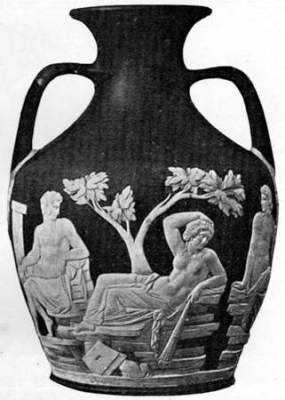
Fig. 239.—The Portland Vase.
Of black and white jasper.
In 1785 a “jasper dip” was introduced, in which[Pg 224] the white clay vessels were dipped, and received a coating of jasper, instead of being jasper throughout. This was considered a great improvement, and caused an increase of 20 per cent. in the price.

Fig. 240.—Teapot, Caddy, and Plate.
With printed transfer.
Flaxman was engaged by Wedgwood and Bentley as early as 1775, and he furnished them with drawings and models. After Bentley’s death in 1780 Flaxman’s fame as a sculptor obtained him more important work, but still, as time permitted, he worked for Wedgwood up to the time of his departure for Rome in 1787.
Josiah Wedgwood died on the 3rd of January 1795, in his 65th year.

Fig. 241.—Six Jasper Cameos.

Fig. 242.—Vase.
Granite ground, with gilt festoons and handles.

Fig. 243.—Ewer.
Of agate ware.

Fig. 244.—An Obelisk, by Ralph Wood,
and A Tea Set, by Aaron Wood.
[Pg 227]In 1773 Ralph Shawe of Burslem took out a patent for chocolate-coloured ware, striped with white and lined with white, glazed with salt. He afterwards transferred his factory to France.
Ralph Wood was established at Burslem about 1730, and was succeeded about 1750 by his son Aaron Wood, who served his apprenticeship to Thos. Wedgwood; he was a very clever cutter of moulds for stoneware plates and dishes, with raised pattern borders, &c., which have been erroneously termed Elizabethan. Cream ware is said to have been invented by him. He was succeeded, about 1770, by his son Enoch Wood, who was also a sculptor, and made many busts of eminent men. His successors were Wood and Caldwell, who continued the manufacture of busts and groups.
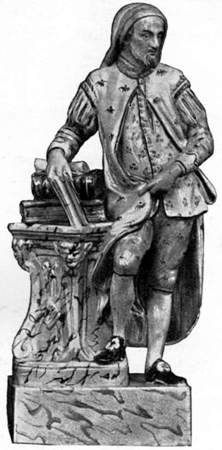
Fig. 245.—Statuette.
Chaucer, by Ralph Wood.
[Pg 228]Moses Steel was a manufacturer at Burslem in 1715. The name of a descendant is found on a vase, with blue ground and white figures in relief, in the style of Wedgwood, in the Victoria and Albert Museum.

Fig. 246.—Vase.
Shelton. Astbury of Shelton, early in the 18th century, made red crouch, and white stoneware. It is said he derived his knowledge of mixing the clays by pretending to be an idiot and obtaining employment at the Elers’ manufactory at Bradwell;[Pg 229] after gaining their secret, he set up in business against them.
The first use of calcined flints as an ingredient in the composition of pottery is attributed to the younger Astbury; it led to the manufacture of fine fayence, and paved the way for the great improvements afterwards achieved by Wedgwood.
Samuel Hollins of Shelton established about 1760 a manufactory of fine red ware teapots; he procured the clay from Bradwell. He was succeeded about 1777 by T. and J. Hollins.

Fig. 247.—Green Bowl.
With ornaments in relief.
Signed “S. Hollins.”

Fig. 248.—Basin.
With white ground and blue figures in relief.
Stamped T. and J. Hollins.
[Pg 230]The New Hall China Works at Shelton owed their origin to the purchase of Champion’s (Cookworthy’s) patent by a company of potters in 1777, and were the first porcelain manufactory in Staffordshire. The ware made here was not of a fine character; inferior artists were employed in its production, and it was never held in any great esteem. The manufacture consequently soon fell to decay, after many changes. The mark is the name of the works in a double ring.

Fig. 249.—Cup and Saucer.
Painted with flowers.
Bradwell. A potter to whom Staffordshire was indebted for great improvements in the ware was John Philip Elers, who about 1690 came over from Holland and settled at Bradwell. He was descended from a noble family of Saxony.
Elers was a clever chemist, and discovered the art of mixing the clays of Staffordshire to greater perfection than had ever before been attained. He manufactured to a considerable extent an improved kind of red pottery, in imitation of that of Japan,[Pg 231] while by the addition of manganese to the clays, he made a fine black ware, which a century afterwards was adopted and improved by Wedgwood.

Fig. 250.—Teapot.
Of red ware, with flowers in relief.
Hanley. Shaw mentions a Mr. Miles of Miles’s[Pg 232] Bank, Hanley, who produced the brown stoneware about 1700. There is in the Victoria and Albert Museum a fayence barrel of brown glaze with gilt hoops, dating apparently from the first half of the 18th century, and it is impressed with the name of Miles (see Fig. 251).

Fig. 251.—Barrel.
Elijah Mayer of Hanley was a contemporary of Wedgwood. He was noted for his cream-coloured ware and brown-line ware, but he produced many other varieties. A vase of unglazed drab terra-cotta, with festoons, &c., in relief, coloured (see Fig. 252).

Fig. 252.—Vase.
He also produced basaltes ware tea services, with animals, &c., in relief.
[Pg 233]Palmer of Hanley was a great pirate of Wedgwood’s inventions, and Mrs. Palmer, who seems to have been the active manager of her husband’s business, engaged persons surreptitiously to obtain Wedgwood and Bentley’s new patterns as soon as they arrived at the London warehouse, for the purpose of copying them. Palmer had a London partner of the name of Neale. They imitated Wedgwood’s black Egyptian vases and other inventions, and eventually his Etruscan painted vases. In 1776 Palmer failed, and the business was carried on by Neale & Co., who by some means discovered the secret of the jasper body. They became formidable rivals of Wedgwood.

Fig. 253.—Jardinière.
Of blue and white jasper.

Fig.254.—Vase.
J. Voyez of Hanley was a clever artist; he was employed by Wedgwood and afterwards by Neale and Palmer.
[Pg 234]Fenton. Thomas Whieldon of Fenton established a pottery in 1740; besides the common household articles, he made fancy marbled ware. Aaron Wood and Josiah Spode were his apprentices, and Josiah Wedgwood was in partnership with him until 1759.
Tunstall. Enoch Booth of Tunstall, and John Warburton of Cobridge in the same county, were extensive potters, and first made cream-coloured pottery by the use of fluid glaze introduced by Booth.
William Adams of Tunstall was a favourite pupil of Wedgwood, and while with him executed some of his finest specimens of jasper ware. He afterwards went into business on his own account, and carried on an extensive trade.
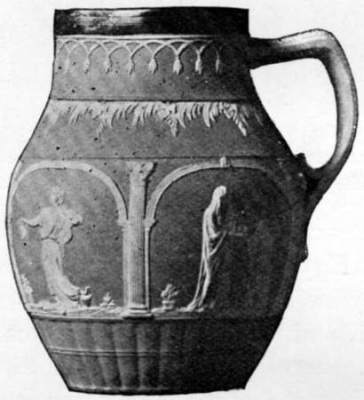
Fig. 255.—Jug.
Of blue jasper.
[Pg 235]Lane End. John Turner of Lane End made a fine description of ware, and his productions were the most successful imitation of Wedgwood’s jasper, with ornaments in relief, and only second to the latter’s in excellence; he also made a fine white stoneware.

Fig. 256.—Sugar Basin.
Of yellow clay, with figures in relief.

Fig. 257.—Teapot.
With medallion, figures in relief.
Longport. The Messrs. Davenport of Longport made great improvements in the manufacture of earthenware; they were celebrated especially for their stone china. The manufactory was established in 1793, and has been successfully carried on up to the present day in the same family.

Fig. 258.—Cup, Cover, and Saucer.

Fig. 259.—Dish.
[Pg 236]Lane Delph (now Middle Fenton). Miles Mason of Lane Delph early in the last century produced some fine ware. The ironstone china was brought to great perfection by Charles James Mason, and the forms were of a high quality, very much resembling porcelain.

Fig. 260.—Cup, Cover, and Saucer.
Stoke-on-Trent. Thomas Minton established a manufactory at Stoke-upon-Trent in 1791; he was apprenticed to Turner of Caughley as an engraver. His productions were of the useful kind, viz., services for the table, in imitation of common nankin. He died in 1836, and was succeeded by his second son, the celebrated Herbert Minton, who brought the potter’s art to great perfection. He largely increased the business, and manufactured articles in earthenware, hard and soft porcelain, and parian.[Pg 237] Reproductions of Italian maiolica, Delia Robbia, Palissy, and Henri II. ware were also extensively made by him. He died in 1858, and was succeeded by Michael Daintry Hollins and Colin Minton Campbell, his nephew and heir. The founder’s grandsons afterwards succeeded to the business; the firm of Messrs. Minton & Co. still exists, but there are no members of the family now connected with it.

Fig. 261.—Mug.
Liverpool. Early in the 18th century, and probably much before that, Liverpool was noted for the manufacture of pottery. Little is known of its early history, and it was not until Mr. Jos. Mayer rescued from oblivion many interesting particulars that anything like a succinct account was published. In his interesting notice of the Art of Pottery in Liverpool, we learn that the most celebrated of the early potters was Alderman Thomas Shaw, who had works for making pottery in the beginning of the 18th century; several large plaques and monumental slabs of his make are in existence, dated from 1716 to 1756. About this time, there seems to have been a large demand for punch bowls; as these formed the principal ornaments on the sideboards of the middle classes, and especially on board the ships, which were constantly going and coming in the port, considerable pains were taken[Pg 238] in decorating them, and many are still in existence painted with ships, convivial mottoes, and inscriptions.
Another important establishment was founded by Mr. John Sadler, the son of a painter, who had learnt the art of engraving.
He was the inventor, about 1752, of the method of transferring prints from engraved copper plates upon pottery, and in conjunction with Guy Green, proposed to take out a patent in 1756, the draft of which is still preserved, but they preferred keeping the invention secret to the doubtful security of patent rights.

Fig. 262.—Punch Bowl.
Wedgwood availed himself of this new mode of decoration, and sent his Queen’s ware weekly to Messrs. Sadler and Green to be printed.

Fig. 263.—Tiles.
By J. Sadler.
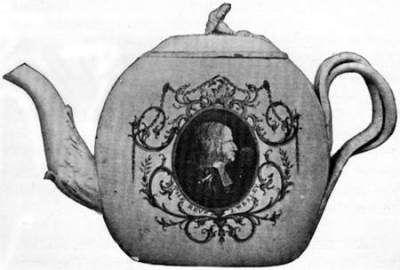
Fig. 264.—Teapot.
With portrait of Wesley.
[Pg 240]Richard Chaffers was the principal manufacturer of Liverpool; he served his apprenticeship with Alderman Shaw, and in 1752 established a bank for the manufacture of blue and white earthenware and fine porcelain, which gained him great reputation; they were largely exported to our American Colonies (now the United States).
His porcelain works were established about the same time as those of Worcester and Derby, and his productions had a great sale in England.
The Liverpool establishments of Pennington, Philip Christian and Richard Abbey were on an extensive scale, but towards the end of the eighteenth century only one of any importance survived, and that belonged to Messrs. Worthington, Humble and Holland, who in 1796 established a large manufactory on the south bank of the Mersey. As Wedgwood had christened his settlement Etruria they called theirs Herculaneum. A larger capital being required, in 1806 an increase of proprietors took place. The first wares made here were Queen’s and blue printed ware. About 1800 the production of porcelain was commenced, the mark used being “Herculaneum,” or “Herculaneum Pottery.” About 1836, when the factory came into possession of Messrs. Case, Mort & Co., the mark used was a bird called the liver, which forms the crest of the Borough of Liverpool.
Jackfield, near Thursfield, in Shropshire. There was an old pottery here about 1760. The ware was of a red clay, with a brilliant black glaze, sometimes with scrolls and flowers in relief. Tea services[Pg 241] are frequently seen. The jugs were known in the locality as “black decanters.” About 1780 the works were taken by Mr. John Rose, and subsequently removed to Coalport, on the opposite side of the Severn, where the well-known Salopian porcelain was made.

Fig. 265.—Teapot.
Fig. 265. A black glazed teapot inscribed “Richard and Ruth Goodin, 1769.”
Fulham. The first successful imitation of the grès de Cologne was made by John Dwight, an Oxfordshire gentleman, and in course of time it almost entirely superseded the importation from abroad. This great potter took out his first patent in 1671, and probably established a manufactory at Fulham in that year, which was successfully carried on through two patents of fourteen years each. The Fulham stoneware is of exceedingly hard and close texture, very compact and sonorous, covered with a salt glaze, of grey colour, ornamented with a brilliant blue enamel in bands, leaves, and flowers, having medallions of kings and queens of England in front, with Latin names and titles, or their initials only.
Dwight produced a great variety of objects, and[Pg 242] brought the potter’s art to a great perfection. The figures, busts, and groups are exquisitely modelled, and will bear comparison with any contemporary manufactures of Europe. A careful inspection will convince any unprejudiced mind of the erroneous impression which exists, that until the time of Wedgwood the potter’s art in England was at a very low ebb, and that none but the rudest description of pottery was made, without any attempt to display artistic excellence. For here, a century before Josiah Wedgwood’s time, we have examples of English pottery which would do credit to the atelier of that distinguished potter himself. John Dwight died in the year 1737, and with him also departed the glory of his manufactory at Fulham.

Fig. 266.—“Lydia Dwight.
Dyed March 3, 1673.”
[Pg 243]Lambeth. The next important pottery in England in the 17th century was that of Lambeth. In the History of Lambeth it is related that about 1650 some Dutch potters established themselves here, and by degrees the industry became important, for the village contained no less than twenty manufactories, in which were made the glazed pottery and tiles used in London and various parts of England. The ware was very much of the character of Delft, with a fine white creamy glaze, painted with landscapes and figures in blue.

Fig. 267.—Dish.
[Pg 244]The white bottles or jugs, upon which are written the names of wines accompanied by dates, were made here.
The trade flourished here for more than a century, until about 1780 or 1790, at which time the Staffordshire potters, by the great improvements they had made in the quality of their ware, and having coal and clay ready to their hand, were enabled to produce it at a cheaper rate, and eventually beat the Lambeth potters out of the field.
The Lambeth potters, about the end of the 17th century, appear also to have copied the forms of the Palissy ware, especially in large oval dishes with initials and dates. Fig. 267 is an example of one of these dishes.
Yearsley, in Yorkshire. A pottery of coarse character was made here in the 17th century. A factory was established by an ancestor of Josiah Wedgwood about the year 1700; and on the estate of Sir George Wombwell fragments of pottery, of a coarse brown ware, with lead glaze, have been frequently found on the site of the old manufactory.
[Pg 245]There was also a manufactory established at the Manor-house, York, about 1665, of which little is known except the mention of its existence by Ralph Thoresby and Horace Walpole; although it is by the former erroneously called porcelain, the ware was actually a fine stoneware, with a salt glaze.
Don Pottery. There was a pottery on the river Don, near Doncaster, established by Mr. John Green of New-hill, who came from the Leeds pottery about 1790. In 1807 some other members of his family joined the firm, and it was for a short time “Greens, Clark, & Co.”

Fig. 268.—Tea Caddy.
Of yellow clay, ornamented with
chocolate brown appliqué
medallions of female figures in relief.
The Don Pottery was very similar to that of Leeds, frequently producing pierced work-baskets, vases, dinner, dessert and tea services, &c.
Leeds. This ware was made by Messrs. Hartley, Greens, & Co. in 1770. It is of a sort of cream colour, and has much perforated or basket-work, sharply cut out of the borders in various patterns.[Pg 246] Important centre-pieces with figures were also made here.

Fig. 269.—Chestnut Bowl and Cover.
Castleford, about twelve miles from Leeds. Here David Dunderdale established works in 1790 for the finer kinds of pottery, especially Queen’s ware and the black Egyptian.

Fig. 270.—Teapot.
With ornaments in relief, of white
ware edged with blue.
[Pg 247]Swinton, near Rotherham. Initiated by Edward Butler in 1757, on the estate of the Marquis of Rockingham. In 1765 it was carried on by William Malpas, and in 1778 by Messrs. Bingley, Brameld, & Co., who enlarged the works, and made earthenware of a very superior quality. Rockingham teapots, of a mottled chocolate colour, glazed inside with white, were in great repute. But the aims of the Messrs. Brameld were of a higher character, and some works of artistic merit were produced. When the Rockingham works were closed in 1842 many of the moulds were purchased by Mr. John Reed, and transferred to the Mexborough pottery.

Fig. 271.—Teapot.
[Pg 248]Newcastle-on-Tyne. There were some extensive manufactories here at the end of the 18th century for making Queen’s ware, some of which is perforated like that of Leeds, and has wicker pattern borders. Some of the earthenware mugs have a pink metallic lustre, and are ornamented with transfer engravings. On the inside was usually a toad in relief.

Fig. 272.—Dish.
Of Queen’s ware, marked “fell.”

Fig. 273.—Mug.
With printed monument of Lord Nelson;
inside is a toad;
marked “Fell & Co., Newcastle Pottery.”
St. Anthony’s, about 2½ miles from [Pg 249]Newcastle-upon-Tyne. Established by Sewell & Donkin in 1780. Queen’s ware and pink metallic lustre, also printed subjects, were produced; pierced wicker baskets, like that of Leeds, were also made.

Fig. 274.—Jug.
With cupids in relief, coloured with
pink metallic lustred clouds.
Nottingham. Stoneware was made here in the first half of the 18th century; it usually has a dark brown glaze, with a slightly metallic lustre, is very hard and durable, and is frequently ornamented with outlines of stalks and flowers, especially the pink.

Fig. 275.—Mug.
Inscribed, “Made at Nottingham, the 17th
August 1771.”

Fig. 276.—Jug.
In the form of a Bear.
Great Yarmouth. A potter named Absolon about 1790 decorated pottery of the cream colour. The favourite subjects are single flowers and plants, with their names on the back of the piece.

Fig. 277.—Plate.
[Pg 251]Lowesby, in Leicestershire. A pottery was established by Sir Francis Fowkes, about the year 1835. Red terra-cotta with black enamelled ornaments, in imitation of Wedgwood, was made.

Fig. 278.—Garden Pot.

Fig. 279.—Vase.
Bristol. At Redcliffe Backs a manufactory of Delft ware was carried on in the 18th century by Richard Frank.
At Temple Backs, Bristol, Joseph Ring, son-in-law of Cookworthy (after the porcelain works had been relinquished in 1777), opened a manufactory called the “Bristol Pottery.” It was continued for[Pg 252] many years, and about 1820 it was occupied by Messrs. Pountney & Allies. The articles produced were similar to those of the superior potteries in Staffordshire.
BRISTOL (Redcliffe Backs)

Fig. 280.—Tiles.
St. Mary Redcliffe Church.
Cadborough, near Rye in Sussex. A pottery was established here early in the 19th century for the manufacture of common sorts of pottery, but some vases of glazed ware of elegant forms were also [Pg 253]produced. The works are now carried on at Bellevue Pottery, Rye.

Fig. 281.—Vessel.
In form of a pig.
Swansea. Established about 1750; it was greatly enlarged by George Haynes in 1780, who styled it the “Cambrian Pottery.” In 1802 the works were purchased by Lewis Weston Dillwyn, and about 1810 an improved ware was made which was termed opaque porcelain; with the assistance of Young, a draughtsman employed in delineating natural history, the ware became remarkable for its beautiful and truthful paintings.
The early Swansea ware was elegant in form, and frequently covered with a deep blue glaze.

Fig. 282.—Dish.
Mark, Swansea and letter C.
The manufacture of porcelain in England began much earlier than has been generally supposed, and the invention was patented in England by John Dwight of Fulham in 1671, while that at St. Cloud was not patented until 1702, thirty years afterwards.
Worcester. Although this manufactory originated more than a century and a half ago, and has always been carried on by private enterprise, it is still in a flourishing state. It was established in 1751, chiefly through the exertions of Dr. Wall, a physician and a good practical chemist, who in conjunction with others formed the “Worcester Porcelain Company.” The early productions were principally of the useful description, and were sold at a cheaper rate than the wares of Bow and Chelsea. About the year 1757, the important method of multiplying designs upon the biscuit ware by means of transferring impressions of engraved copper plates to the surface, was adopted at Worcester almost at the same time as at Liverpool, the invention being in fact claimed by both; but specimens are found bearing the names of Sadler and Green of Liverpool, and Richard Holdship and Robert Hancock of Worcester, dated in the same year. Bat printing succeeded the printing from engraved or etched plates. This new style was accomplished thus: instead of the design being first printed upon paper and then transferred, the plate was stippled with a fine point by London artists after designs of landscapes, shells, fruit, and flowers by Cipriani, Bartolozzi, Cosway, and Angelica Kauffmann, who were so fashionable about the end of the 18th century. The copper plate being carefully cleaned, a thin coating of linseed oil was laid upon it, and removed by the palm of the hand from the surface, leaving the oil in the engraved spots; instead of paper, bats of glue were used, cut into squares of the size of the engraving; one of these bats was pressed on to the plate, so as to receive the oil out of the engraved holes, and laid on to the china, transferring the oil to the surface; it was then dusted with the colour required, the superfluous colour being removed carefully with cotton wool, and the china was then placed in the kiln.
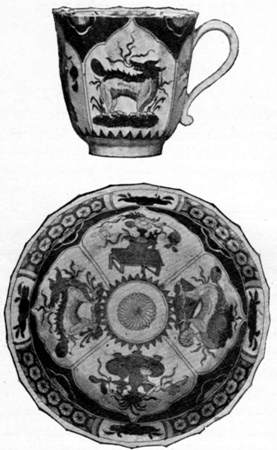
Fig. 283.—Cup and Saucer.
[Pg 257]In 1783 the Worcester porcelain works were purchased by Mr. Thomas Flight, from whom they afterwards passed to Messrs. Flight and Barr; the principal painters at this time were: J. Pennington, who painted figures; S. Astles, flowers; G. Davis, exotic birds in the Chelsea style; Webster, landscapes and flowers; J. Barker, shells; Brewer of Derby, landscapes; while Thomas Baxter, an accomplished artist, painted figure subjects.
The Worcester works remained with Messrs. Flight & Barr until 1840, when the two principal manufactories of Worcester—that of Flight & Barr, and that of the Messrs. Chamberlain, were amalgamated; the plant and stock were removed to the premises of the latter, and the new firm was styled Chamberlain & Co. The last-named works were established by Robert Chamberlain in 1786; he was the first apprentice at the Old Worcester Porcelain Company, and he and his brother Humphrey took premises in High Street. At first they only decorated porcelain, which they bought of Turner of Caughley; but they afterwards manufactured largely on their own account,[Pg 258] and their business increased to a great extent, being patronised by the royal family.

Fig. 284.—Portion of a Tea Service.
Japanese pattern, blue, red, and gold.

Fig. 285.—Portion of a Tea Service.
Transfer coloured, and partly gilt.
These two works which were united in 1840, remained so until 1852, when Messrs. Kerr & Binns became the ostensible proprietors. In 1862 another Joint Stock Company was formed, Mr. R. W. Binns having the direction of the artistic department and Mr. Edward Phillips being general superintendent.
Swinton, near Rotherham. The manufacture of porcelain at the Rockingham Works was introduced, under the patronage of the Earl Fitzwilliam, about the year 1823 by Thomas Brameld, who spared no expense in endeavouring to bring it to perfection. The china was of a superior description, and the painting and decoration were of a high character. In 1832 royal patronage was obtained and a magnificent service was ordered by King William IV.; instead, however, of placing the firm in a flourishing condition, it was actually the cause of its ruin, for the expense incurred by the engagement of first-class artists, and the super-abundance of gold employed in decorating the service, resulted in so great a loss that the manufacture was totally discontinued a few years after.

Fig. 286.—Plate.

Fig. 287.—Vase.
Centre-piece of the service made for King William IV.
Height 14 in.
[Pg 260]Derby. The earliest manufactory was called “The Derby Pot Works,” and was carried on at Cock Pit Hill by Messrs. John and Christopher Heath for pottery and porcelain. It is said to have been on an extensive scale, but little is known of its operations. The proprietors, who were bankers in Full Street, became bankrupt in 1780, when the stock was sold and the works discontinued.

Fig. 288.—Group.
Chelsea Derby.

Fig. 289.—Pair of Vases.
Chelsea Derby.

Fig. 290.—Plate.
With flowers by Billingsley.
The “Derby Porcelain Manufactory” was founded in 1751 by William Duesbury; the first productions were chimney ornaments, lambs, sheep, and services for the table, but it was probably not until he purchased the Chelsea works in 1769 that any great[Pg 262] reputation was acquired, and few if any of the early specimens can be identified. Some beautiful examples of porcelain painted in the Chinese style were produced about this time, but as the rage for oriental ware seemed so prevalent, the proprietor, to insure the sale of his china, copied the Chinese marks as well as the style of decoration. Crown Derby was produced from 1780, and was continued by Bloor, the successor of Duesbury, as late as 1830. After the purchase of the Chelsea and Bow works, the Derby porcelain manufactory rose to great importance, the proprietors having of course retained the best workmen who had been engaged there. In fact, with all the models and moulds, the mixers, throwers, and painters of those two great establishments, the manufactory may be considered as the Chelsea and Bow works continued in another locality. Upon the death of William Duesbury, in 1785, his son William continued the business, and a third William Duesbury succeeded in the beginning of the last century. About 1815, Robert Bloor took over the works, which were altogether closed in 1848. An offshoot, however, is still carried on.

Fig. 291.—Cup, Cover, and Saucer.
Crown Derby.

Fig. 292.—Scent Vase.
Crown Derby.

Fig. 293.—Cup, Cover, and Saucer.
Crown Derby.
[Pg 264]Burton-on-Trent. A manufactory of earthenware was established here early in the last century, and from about 1839 porcelain was made for seven years.

Fig. 294.—Comport.
Wirksworth. A manufactory of china as well as pottery, established by a Mr. Gill, existed here about 1770, and continued for about twenty years.

Fig. 295.—Cup.
Pinxton in Derbyshire. Established about 1795, by Billingsley in partnership with John Coke; the former was a practical potter, having been engaged at the Derby works as a flower painter, in which capacity he excelled; he brought with him a staff of workmen and their families, and the factory went[Pg 265] on successfully for about five or six years, when Billingsley left; it was continued by Coke, and afterwards by Cutts the foreman, but was altogether discontinued about 1812. The ware made here by Billingsley was of a peculiar transparent character; and a favourite pattern was the French sprig or “Chantilly,” being an imitation of the Angoulême china.

Fig. 296.—Jardinière.

Fig. 297.—Sugar Bowl and Cover.
Lowestoft. According to Gillingham’s History of Lowestoft, written in 1790, an attempt was made to manufacture porcelain there in 1756 by Mr.[Pg 266] Hewlin Luson of Gunton Hall, he having found some fine clay on his estate suitable for the purpose, and in the following year Messrs. Gillingwater, Walker, Browne, Aldred, and Richman, established the Lowestoft porcelain works, which existed until 1802. The porcelain was of soft paste, and in 1902 fragments of it and moulds were found on the site of the factory. The theory that hard paste was made at Lowestoft or that Chinese porcelain was painted there has now been abandoned.
Plymouth. About the year 1755 William Cookworthy commenced his experiments to ascertain the nature of true porcelain of hard paste, and searched with great perseverance throughout England for the materials which were the constituent parts of Chinese porcelain. At length a friend of his discovered on the estate of Lord Camelford, in the parish of St. Stephen’s, Cornwall, “a certain white saponaceous clay, and close by it a species of granite or moorstone, white with greenish spots, which he immediately perceived to be the two long sought-for ingredients, the one giving whiteness and body to the paste, the other vitrification and transparency.”

Fig. 298.—Coffee-pot.

Fig. 299.—Beaker and Cover.

Fig. 300.—Centrepiece.
[Pg 268]The patent was obtained in 1768, and the materials were described as growan stone and growan clay. The works were carried on for nearly six years, and consequently a considerable quantity of ware was made. Cookworthy engaged the services of a French artist, M. Soqui, whose ornamental delineations on the articles produced here were very beautiful. Some elegant salt-cellars and table ornaments in the form of open conch shells resting on a bed of coral, &c., all well modelled in hard paste, were favourites for the table.

Fig. 301.—A Shepherdess.

Fig. 302.—A Shepherd.
Cookworthy and Lord Camelford continued to work this manufactory until 1774, when the patent right was sold and transferred to Richard Champion.
[Pg 269]Bristol. A manufactory of soft paste porcelain was founded at Bristol about 1750. Later Richard Champion, having in 1774 purchased Cookworthy’s patent, opened a manufactory for hard paste. The ware was brought to great perfection, but the large outlay prevented its being remunerative, and in three or four years he sold his interest in the patent to a company of Staffordshire potters.

Fig. 303.—Bowl and Cover.

Fig. 304.—Dish.
[Pg 270]Caughley, near Broseley, Salop. Established in 1751 by a Mr. Brown, and afterwards carried on by a Mr. Gallimore. It was not until 1772 that it rose to any importance, when Thomas Turner commenced operations. He came from the Worcester porcelain manufactory; he was an engraver, and probably learnt his art from Robert Hancock.

Fig. 305.—Mug.
Painted in blue.

Fig. 306.—Plate.
Blue willow pattern.
The excellence of Turner’s porcelain gained him great patronage. In 1780 he produced the celebrated “willow pattern,” and completed the first blue printed table service made in England. Thomas Minton of Stoke assisted in the completion of it, being articled as an engraver at Caughley.
In 1799 Turner retired and John Rose became[Pg 271] proprietor; the latter removed the works to Coalport about 1814 or 1815.
Coalport, in Shropshire. The porcelain works here were established about 1780 by John Rose, who had removed his manufactory from Jackfield. He carried on this and the Caughley works simultaneously. In 1820, both the Swansea and the Nantgarw manufactories having been purchased, they were incorporated with Coalport, and Billingsley of Nantgarw was engaged as mixer of the clays; he remained at Coalport until his death in 1828. The “worm sprig” and the “Tournay sprig” were much made at Coalport.

Fig. 307.—Dish.
Marked “Coalport improved Feltspar (sic) Porcelain.”
[Pg 272]Colebrook Dale is another name for the Coalport works.
Stoke-on-Trent. The first Josiah Spode had a factory here in 1784 for the production of earthenware. He died in 1797 and was succeeded by his son Josiah, who commenced the manufacture of porcelain about 1800. He was a most successful man of business and was appointed potter to the Prince of Wales. Josiah Spode took William Copeland into partnership, and the works are still carried on by Messrs. Copeland & Sons.

Fig. 308.—Cup, Cover, and Saucer.

Fig. 309.—Vase.
Herbert Minton when he succeeded to the business at Stoke-on-Trent (see page 236), greatly[Pg 274] developed the manufacture of hard and soft porcelain, and copies were made of Sèvres porcelain vases.

Fig. 310.—Bowl.
Blue and gold, painted with flowers.
Longton Hall. A porcelain factory was established here about 1752 by William Littler. The ware appears to have been rather vitreous in character, and somewhat resembles Chelsea and Bow porcelain. The works closed about 1759, and the moulds, &c., are believed to have been purchased by Duesbury of Derby.
LONGTON HALL
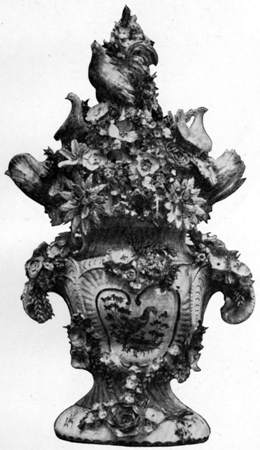
Fig. 311.—Vase.
[Pg 276]Bow. The manufactory of porcelain at Stratford-le-Bow was established about the middle of the 18th century. Thomas Frye, an eminent painter, appears to have been instrumental in bringing the china to that perfection for which the manufactory was celebrated. He took out two patents for the improvement of porcelain; the first in 1744 was in conjunction with Edward Heylyn, the second in 1749. In 1750 the works were disposed of to Messrs. Weatherby & Crowther.
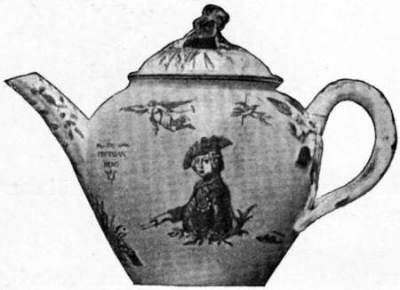
Fig. 312.—Teapot.
Printed with King of Prussia.

Fig. 313.—Bowl.

Fig. 314.—Plate.
Printed with Æneas and Anchises.

Fig. 315.—Statuette, “Flora.”

Fig. 316.—Bust of George II.
The interesting bowl (now in the British Museum), made at the Bow works in the year 1760, and painted by Thomas Craft, is accompanied by a short history of the works, which informs us that the names of the[Pg 279] proprietors were known all over the world, that they employed 300 persons, about 90 painters, and 200 turners, throwers, &c., all under one roof. (See Fig. 313.) In 1775 or 1776 the works were sold to Duesbury, and all the moulds and implements were transferred to Derby.

Fig. 317.—Group: “A Tea Party.”
For a more detailed account of the Bow porcelain manufactory, the reader is referred to Marks and Monograms on Pottery and Porcelain, by W. Chaffers.
Chelsea. This celebrated porcelain manufactory was established about 1740, shortly after that of Bow, and the early productions of the two are frequently mistaken one for the other; but, fortunately, the Chelsea wares, especially the finest pieces,[Pg 280] were subsequently marked with an anchor in gold or red. The period of its greatest excellence was from 1750 to 1765.
The early pieces were copied principally from the Oriental, being decorated with Chinese patterns, and these were marked with an embossed anchor.

Fig. 318.—Marshal Conway.

Fig. 319.—Shepherd.
The beautiful vases in the French style, in imitation of Sèvres, with gros bleu, crimson, turquoise, and apple-green grounds were made from 1760 to 1765.
[Pg 281]In 1769, by order of M. Sprimont, the proprietor, the Chelsea porcelain manufactory was sold by auction.

Fig. 320.—Vase. “Death of Cleopatra.”
The works were purchased by W. Duesbury of Derby, and carried on by him at Chelsea until 1784. The later pieces made here under his direction are easily distinguished; these vessels are of simple elegant forms, with the frequent recurrence of gold stripes, and the same forms and style were adopted simultaneously at Derby, but they are inferior to the[Pg 282] vases made when M. Sprimont had the works under his direction.
Swansea. The manufacture of porcelain was revived at Swansea in 1814 by L. L. Dillwyn. At that time Billingsley had commenced making his porcelain at Nantgarw; it naturally attracted Dillwyn’s attention, and conceiving that the kilns used by Billingsley & Walker might be considerably improved, he made arrangements with them to carry on their process at Swansea. Hence the origin of the Swansea porcelain, which obtained great repute, and was continued for six or seven years. Baxter, a clever painter of figure subjects, left Worcester and entered Dillwyn’s service in 1816 and continued there for three years, returning to Worcester in 1819. In the year 1820 the manufactory was discontinued, and all the moulds and appliances were purchased by John Rose, who removed them to Coalport about the same time as those of Nantgarw.

Fig. 321.—Plate.

Fig. 322.—Plate.
[Pg 283]Nantgarw. Established in 1813 by Billingsley, the celebrated flower painter of Derby, with Walker, after they left Worcester. They produced some very fine porcelain, of the same peculiar character as that of Pinxton, with a sort of vitreous appearance and a granulated fracture like that of lump sugar. Being very soft the paste would not in all cases stand the heat of the kiln; some of the early pieces are consequently found cracked on the glaze, or slightly warped and bent.

Fig. 323.—Plate.

Fig. 324.—Cup and Saucer.
[Pg 284]The Nantgarw porcelain was of remarkably fine body and texture, but its production was expensive. About the year 1820 the manufacture was discontinued; Billingsley and Walker having disposed of their interest in the concern to J. Rose, the moulds and everything connected with the works were removed to Coalport.

Fig. 325.—Vase.
The porcelain of China is composed of two earths, the one a decomposed felspathic rock called kaolin, and the other a rock of the same geological origin, mixed with quartz, called petuntse. They both harmonise so completely that they have an equally resisting power when placed in the kiln. The kaolin used in making porcelain is much softer than petuntse when dug out of the quarry, yet it is this which, by its mixture with the other, gives strength and firmness to the work.
Chinese porcelain was classified by the late Dr. S. W. Bushell, C.M.G., under the following periods:—
1. Primitive period, including the Sung dynasty (960-1279) and the Yuan dynasty (1280-1367).
2. Ming period, comprising the whole of the Ming dynasty (1368-1643).
3. K’ang Hsi period, extending from the fall of the Ming dynasty to the close of the reign of K’ang Hsi (1662-1722).
4. Yung Chêng and Chiên Lung period (1723-1795), the two reigns being conjoined.
[Pg 286]5. Modern period, from the beginning of the reign of Chia Ch’ing to the present day.
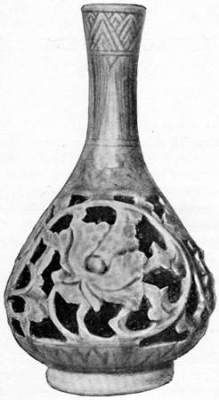
Fig. 326.—Stoneware Vase.
With Céladon green glaze.
Ming dynasty.
The most ancient mode of decoration was the blue camaïeu, and it is still much esteemed in China; it was executed on the ware, simply dried before the[Pg 287] glaze was applied, and then placed in the kiln. Being all completed in one baking, au grand feu, the painting thus executed became imperishable.

Fig. 327.—Stoneware Vase.
With Céladon crackle glaze.
It is on this blue ware that the greater number of the Chinese characters are found denoting the period in which the porcelain was made. The cobalt on the earlier pieces was not so fine as on those of the Siouen-te and Ching-hoa periods, which are now much[Pg 288] sought after. It is extremely difficult to tell even the approximate date of the coloured pieces, especially as there was a conventional method of decorating them which had been practised from time immemorial; the painters worked according to given models or patterns, and monsters, deities, or flowers and landscapes, of the same uncouth and rude designs, were placed in successive ages upon the ware.

Fig. 328.—Porcelain Vase.
Painted in enamel colours.
The Père d’Entrecolles tells us the manner of painting vases in China, and how the different parts[Pg 289] of a landscape on one vase were intrusted to various hands according to their ability to paint special objects mechanically. He says: “One is employed solely to form the coloured circle which is seen round the border of the ware, a second traces the flowers in outline, which a third fills in with colour; another excels only in painting the water and the mountains, while the next is only competent to portray birds or animals.”

Fig. 329.—Porcelain Ewer.
Painted in enamel colours,
and mounted with Florentine copper gilt.
17th century.
[Pg 290]A sort of very hard stoneware, covered with a thick glaze, may be the most ancient description seen at the present day. The surface is covered with a semi-opaque glaze which is called céladon by the French, and which varies in colour from a russet grey to a sea green. The glaze of this ware is frequently seen crackled all over in irregular lines, which is termed in England crackle. This crackle china is the most esteemed of Oriental porcelain, although it arises from a defective cause.

Fig. 330.—Bottle.
Powder blue porcelain.
Ming dynasty.

Fig. 331.—Jar.
Painted with plum blossoms.
Ming dynasty.
The same effect may be easily produced upon all terra-cottas of which the paste is more sensible to the changes of temperature than the exterior coating or glaze. In fayence this accident is of frequent occurrence; the red porous clay, being more expansive, draws away the enamel, which, being less elastic, is separated into fragments, and the greater the resistance the more they are multiplied. Now one of the qualities of porcelain is precisely to avoid this double action. Its paste is composed of a felspathic rock, decomposed and infusible, called kaolin; the cover or glaze comes also from a felspathic rock, slightly crystallised; these melt and assimilate together [Pg 292]harmoniously in vitrification, and a complete affinity is evident between the two elements of porcelain. Nevertheless the Chinese, in modifying the glaze, are able to render it more or less expansive and to break the harmony between its own shrinkage and that of the paste or body which it covers.

Fig. 332.—Plate.
Egg shell porcelain.
Hence the crackle, at the option of the potter, is made of large, middling, or small size.
Various kinds of crackle are thus produced, sometimes upon one and the same piece, as by exposing the porcelain or portions of it when at its greatest[Pg 293] heat to a sudden cold or contact of water, large fissures may be obtained. These cracks are sometimes filled in with black, red, chocolate, or purple colours.
Others may be classed among the curiosities of porcelain—for example, cups or bowls which have an outer reticulated coating, pierced or cut out into arabesques, completely insulated from the inner vessel, except at the rim at top and bottom where it is joined; these have been used for tea or hot liquids, and may be held in the hand with impunity, notwithstanding the heat enclosed within it.

Fig. 333.—Plate.
Egg shell porcelain.
Another variety consists in cutting or punching out pieces of the paste or body of the ware in patterns before it is baked; the pieces so cut out are small[Pg 294] ovals like grains of rice placed in more or less numerous stars, rosettes, &c. The vase thus ornamented is dipped into the glaze which fills up all these small holes, and then placed in the kiln. The pattern, being much more transparent than the body of the ware, is distinctly seen, but especially so when held to the light.
Another beautiful effect is produced by means of the glaze itself, which is of a light or dark shade according to its intensity or thickness; for example: a fish, animal, or other object is stamped incuse on the upper surface of a plate, it is then filled in with a coloured glaze and vitrified, and is consequently shaded according to the thickness of the glaze on each portion of the design, the surface being perfectly smooth.
Vases are sometimes seen separated in the middle into two pieces (which must have been cut while the clay was soft), the upper half being completely divided from the lower half—in arabesques and dove-tail patterns, in such a manner, that although separate, they cannot be altogether removed from each other; the wonder is, that in the baking, the edges in juxtaposition should not have become again cemented together.
The Chinese themselves are great forgers, and endeavour to impose not only upon the Europeans, but upon their own countrymen, many of whom are great amateurs, and are willing to pay extravagant prices for ancient examples of porcelain, especially if made by a celebrated potter.
The information concerning the origin of making porcelain in Japan is very scanty. Dr. Hoffmann of Leyden published a history of the principal porcelain manufactories in 1799, which is appended to M. Stanislas Julien’s account of those of China: it was a translation from a Japanese work. He says it was to a colony of Koræans established in the province of Omi, in the island of Nippon, in the year 27 B.C., that the introduction of this art was attributed. About the same epoch there lived in the province of Idsumi, situated like that of Omi in the island of Nippon, a man named Nomino Sukuné, who made, in pottery and porcelain, vases and notably figures of the size of life, to substitute for slaves, which it had been previously the custom to bury with their masters. Nomino received as a recompense authorisation to take the name of Fazi, in the Koræan language Patzi, artist-workman.
Under Sei-wa (859-876 A.D.) the number of fabriques increased considerably.
Under Syun-tok (1211-1221), a Japanese potter named Katosiro-uye-mon commenced the making of small vases in which to preserve tea, but for want of a better process he placed them in the kiln on their orifices, which consequently appeared as if they had been used, and the vases were little cared for. Desirous of improving himself in the art, Katosiro, accompanied by a Bonze or Buddhist monk, visited China in 1211, with orders from his Government to make himself acquainted with all the secret processes of the manufacture, which was at that time brought to so great perfection there.

Fig. 334.—Porcelain Vase.
Hizen ware.
About 1690.

Fig. 335.—Fukurokuji.
The god of longevity.
On his return, he made such important improvements in the composition and decoration of porcelain that henceforth it became superior in many instances to the Chinese, especially in the manufacture of the best specimens, upon which much time and labour were bestowed. The porcelain of Japan is very much like that of China, but the colours are more brilliant on the fine pieces; it has a better finish, and the designs are more of the European character, the flowers, birds, &c., being more natural, and the ky-lins, dragons, and other monsters less hideous; the paste is of better quality and a purer white, especially in ware of the 17th and 18th centuries.

Fig. 336.—Saké Cup and Stand.
Porcelain gold ornament on red ground.

Fig. 337.—Stoneware Jar.
Ôto ware.

Fig. 338.—Porcelain Vase.
Kishin ware.
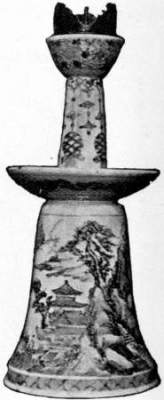
Fig. 339.—Candlestick.
Tozan porcelain.
Painted in blue.
Perhaps the most beautiful of all the porcelain made in Japan is the egg shell, so called because it is extremely thin and translucent, yet so compact that it can be formed into large vases, as well as plates and bowls or cups.
The small cups without saucers, which are usually placed upon présentoirs of lac, are seldom painted on[Pg 301] the exterior; but within is frequently found a fillet of gold, and slight sketches in blue or gold indicating the outline of a mountain, the sun, clouds, and a line of birds taking flight, or sometimes animals, all in outline. On other pieces are birds, flowers, and animals delicately painted in colours.

Fig. 340.—Flask.
Satsuma ware.
The art has been continued to the present day; those beautiful and extremely delicate cups and saucers, thin as paper, are frequently seen covered on the outside with a casing of bamboo threads woven together; the larger basins and covers are also made of equally thin porcelain.
All these are produced now, as they were in ancient times, at Imari, in the province of Hizen. It is not in the village itself that these manufac[Pg 302]tories are established, but as many as twenty-four or twenty-five are situated near the mountain of Idsumi-yama, whence the kaolin is obtained of which the vessels are made.
Crackle china was made in Japan as well as in China from a very early period, and was frequently painted with flowers, landscapes, and birds.

Fig. 341.—Incense-burner.
Imari porcelain. 18th century.
According to the late Sir Augustus W. Franks, K.C.B., “the ceramic wares of Japan exhibit great differences in their composition, texture, and appearance, but may be roughly classed under three principal heads: (1) common pottery and stoneware,[Pg 303] generally ornamented simply by scoring and glazing the surface; (2) a cream-coloured faïence, with a glaze, often crackled and delicately painted in colours; (3) hard porcelain.
“To the first of these classes belong the wares of Bizen, old Seto, Shigaraki, and other small fabrics, including the Raku wares. The principal factories of the second class are Awata, Satsuma, and the recent imitations of the latter at Ôta and elsewhere. Among the porcelain, the coarsest is that made at Kutani, but the most celebrated fabrics are in the province of Hizen, at Seto in Owari, and Kiyomidzu near Kiôto.”
Siliceous-glazed wares were produced in Persia at a very early period, and the late Mr. C. Drury E. Fortnum, in his Historical Treatise on Majolica, states that the decoration by means of metallic lustre was practised in that country in the course of the thirteenth century, if not long before. Glass-glazed bricks, tiles, and other wares, were made in Babylon at a remote period, as well as in Assyria and Egypt; and it is probable that the art of their manufacture spread into the surrounding countries.
The Persian ware is principally decorated with blue and black. The lustres are a rich orange gold, a dark copper colour, and a brass lustre. The patterns upon the tiles and vases are similar, and consist of elegant arabesques, foliage, and ornamented flowers, more or less in imitation of nature. Among these we notice the tulip, the Indian pink, the rose, and other flowers. The tulip in Persia is the emblem of Affection, which is thus symbolised at the present day. The bowls and vases are sometimes ornamented with fabulous birds, gazelles, antelopes, hares, &c., mixed with scrolls and foliage. The forms include hemispherical and cylindrical[Pg 305] cups, vases, and bowls on conical feet; common forms are a bottle with a very long neck, probably used to hold wine, and ewers and basins, the former like a bottle with handle and long spout, used especially for ablutions, the latter with a pierced cover. The tiles being mostly made to cover walls, form continuous arabesques when placed side by side. Chardin says of them, “In truth, nothing can be seen more lively or more brilliant than this sort of work, nor of equally fine design.”

Fig. 342.—Wall Tile.
Glazed earthenware.
13th century.
The Persian fayence was probably the same as[Pg 306] the Gombroon ware, which was shipped by the English East India Company from a port of that name in the Persian Gulf, where they formed their first establishment about the year 1600, and whence the great bulk of Chinese porcelain was exported.

Fig. 343.—Water-bottle.
With metallic lustre.
15th or 16th century.
[Pg 307]It has long been a vexata quæstio whether porcelain was ever made in Persia; some say the idea is altogether chimerical, but M. Jacquemart endeavours to prove that both hard and soft porcelain were made at Iran, and has devoted three or four long chapters to the support of his theory (Les Merveilles de la Céramique).
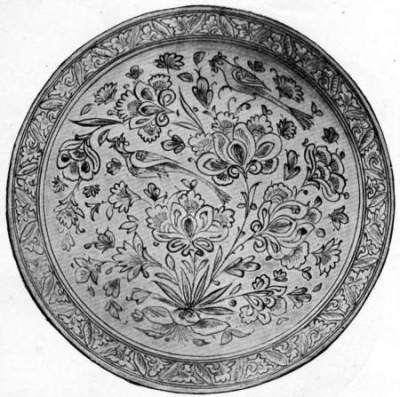
Fig. 344.—Dish for Rice.
The nearest approach to porcelain in Persian ware is a sort of siliceous frit or fine stoneware, which possesses a very slight degree of translucency[Pg 308] but is not true porcelain composed of kaolin and petuntse like Chinese porcelain. Small creamy white basins, with the sides pierced with slashes and filled with translucent glazes, are semi-translucent and have the appearance of porcelain.

Fig. 345.—Rose-water Sprinkler.

Fig. 346.—Rose-water Sprinkler.
Dr. Fortnum was of opinion that what is generally known as Damascus ware was probably made not only in that city but at Constantinople, Broussa, and all the principal sites of manufacturing industry throughout Syria and Asia Minor. It is distinguished by the great brilliancy of its enamel colours, the principal of which are a deep lapis-lazuli blue, turquoise, a vivid emerald green, a brilliant red purple, orange or buff, olive green and black. The pieces consist principally of circular dishes, jugs with long cylindrical necks and globular bodies, flasks, &c., and the best specimens were probably produced during the first half of the 16th century.

Fig. 347.—Damascus Plate.
Painted in colours.
Remains of potteries are stated to have been found at Lindus on the Island of Rhodes, and at[Pg 311] one period all the ware of Asia Minor was attributed to those works and was called Rhodian. The pottery actually manufactured there appears, however, to have been of a somewhat coarser character than that made at Damascus and elsewhere. Richly painted tiles with diapering and conventional floral patterns under a vitreous glaze were used largely for the decoration of palaces, mosques, and tombs throughout Asia Minor and Syria; these tiles are also to be found at Constantinople.

Fig. 348.—Damascus Dish.

Fig. 349.—Rhodian Plate.
Adams, William, 234
Alcora, 47, 129
Amstel, Oude, 173
Amsterdam, 105, 172
Anspach, 143
Aprey, 74
Apt, 53
Armentières, 74
Arnstadt, 98
Arras, 193
Asia Minor, 310
Astbury, 228
Avignon, 54
Baden-Baden, 156
Baranowka, 182
Bassano, 35
Bayreuth, 87, 144
Beauvais, 53
Berlin, 135
Blois, 54
Boissette, 200
Booth, Enoch, 234
Boulogne-sur-Mer, 194
Bourg-la-Reine, 80, 196
Bow, 274
Bradwell, 230
Bristol, 251, 269
Broussa, 310
Brussels, 177
Buen Retiro, 127
Bunzlau, 95
Burslem, 220
Burton-on-Trent, 264
Cadborough, 252
Caen, 201
Cafaggiolo, 19
Capo di Monte, 114
Castel Durante, 10
Castelli, 27
Castleford, 246
Caughley, 270
Chaffers, Richard, 240
Chantilly, 189
Château-la-Lune, 74
Chelsea, 279
China, 285
Città di Castello, 37
Clignancourt, 197
Closter Veilsdorf, 146
Coalport, 241, 271
Cobridge, 234
Colebrook Dale, 272
Cologne (Köln), 88
Constantinople, 312
Copenhagen, 185
Creil, 80
Damascus, 310
Davenport, Messrs., 235
Delft, 100
Derby, 260
Diruta, 15
Doccia, 113
Don Pottery, 245
Douai, 78
Dresden, 96, 130
Dwight, John, 241
Elers, John Philip, 230
Étiolles, 195
Etruria, 221
[Pg 314]
Faenza, 12
Faïence d’Oiron, 50
Fenton, 234
Ferrara, 34
Florence, 26, 112
Fontainebleau, 207
Forlì, 17
Frankenthal, 98, 139
Frechen, 89
Fulda, 148
Fulham, 241
Fürstenberg, 149
Genoa, 35
Gera, 155
Gotha, 158
Great Yarmouth, 250
Grenzhausen, 92
Grossbreitenbach, 153
Gubbio, 6
Hagenau, 63
Hague, The, 174
Hanley, 231
Harburg, 95
Henri Deux ware, 50
Herend, 166
Hispano-Moresque ware, 41
Höchst, 96, 138
Hollins, Samuel, 229
Infreville, 74
Jackfield, 240
Japan, 295
Kelsterbach, 144
Kiel, 99
Kloster Veilsdorf, 146
Korzec, 182
Kreussen, 94
La Fratta, 39
Lambeth, 243
Lane Delph, 236
Lane End, 235
Lauenstein, 89, 96
Leeds, 245
Leipzig, 86
Lille, 81, 195
Limbach, 155
Limburg, 89
Liverpool, 237
Longton Hall, 274
Longport, 235
Loosdrecht, Oude, 171
Loreto, 37
Lowesby, 251
Lowestoft, 265
Ludwigsburg, 151
Lunéville, 72, 198
Luxemburg, 106, 177
Madrid, 127
Majorca, 42
Malaga, 42
Malicorne, 74
Manerbe, 74
Manises, 46
Marieberg, 109, 184
Marseilles, 69, 202
Mason, Miles, 236
Mayer, Elijah, 232
Meissen, 130
Mennecy-Villeroy, 191
Milan, 31
Minton, Herbert, 236, 273
Minton, Thomas, 236
Monte Lupo, 30
Montereau, 81
Moscow, 180
Moustiers, 65
Murano, 25
Nantgarw, 283
Naples, 30, 114
Neale, 233
Neudeck, 141
Nevers, 56
Newcastle-on-Tyne, 248
New Hall China Works, 230
Niderviller, 76, 198
[Pg 315]
Nottingham, 249
Nove, 25, 122
Nuremberg (Nürnberg), 84
Nymphenburg, 141
Nyon, 168
Oberdorf, 87
Oiron, Faïence d’, 50
Orleans, 198
Overtoom, 106
Oude Amstel, 173
Oude Loosdrecht, 171
Padua, 26
Palissy, Bernard, 55
Palmer, 233
Paris, 203
" Belleville, 207
" Faubourg St. Honoré, 205
" Pont-aux-Choux, 206
" Rue de Bondy, 204
" Rue de Crussol, 207
" Rue Fontaine au Roi, 205
" Rue du Faubourg St. Denis, 208
" Rue Thiroux, 203
Pavia, 39
Persia, 304
Pesaro, 8
Pinxton, 264
Pisa, 23
Plymouth, 266
Raeren, 89
Ratisbon, 153
Rauenstein, 158
Ravenna, 18
Regensburg, 153
Rhodes, Island of, 310
Rimini, 18
Rockingham, 247, 260
Rörstrand, 107
Rouen, 59, 190
Rudolstadt, 147
St. Anthony’s, 248
St. Armand-les-Eaux, 79, 202
St. Clément, 76
St. Cloud, 187
St. Petersburg, 107, 179
St. Porchaire, 50
Salopian, 270
Sarreguemines (Saargemünd), 78
Savona, 36
Sceaux Penthièvre, 79, 192
Scherzheim, 96
Schlaggenwald, 166
Sèvres, 209
Sgraffiato, 37
Shawe, Ralph, 227
Shelton, 228
Siegburg, 89
Siena, 20
Sinceny, 70
Spode, Josiah, 272
Staffordshire, 217
Steel, Moses, 228
Stockholm, 109
Stoke-on-Trent, 236, 272
Strassburg, 63, 202
Strehla, 87
Swansea, 253, 282
Swinton, 247, 258
Syria, 310
Talavera, 48
Teinitz, 98
Thuringia, 145
Toft, Ralph, 219
Toft, Thomas, 219
Toulouse, 76
Tournai, 175
Treviso, 18, 117
Triana, 46
Tunstall, 234
Turkey, 310
Turin, 33, 118
Turner, John, 235
Urbino, 1
Utrecht, 105
Valencia, 44
Valenciennes, 201
[Pg 316]
Varages, 68
Venice, 24, 119
Vienna, 160
Vincennes, 78, 208, 209
Vineuf, 118
Vinovo, 118
Viterbo, 18
Volkstedt, 146
Voyez, J., 233
Wallendorf, 158
Warburton, J., 234
Wedgwood, 220
Weesp, 170
Whieldon, Thomas, 234
Wirksworth, 264
Wood, Aaron, 227
Wood, Enoch, 228
Wood, Ralph, 227
Worcester, 255
Yarmouth, Great, 250
Yearsley, 244
York, 245
Zürich, 168
Printed by Ballantyne, Hanson & Co.
Edinburgh & London
Footnotes:
[1] As Strassburg and Hagenau belonged to France at this period, they are included in the French section.
[2] Now Niederweiler, in Germany.
[3] Now Saargemünd, belonging to Germany.
Transcriber’s Notes:
Punctuation has been corrected without note.
Images have been moved from the middle of a paragraph to a nearby paragraph break.
The text in the list of illustrations is presented as in the original text, but the links navigate to the page number closest to the illustration’s loaction in this document.
End of the Project Gutenberg EBook of The Collector's Handbook to Keramics
of the Renaissance and Modern Periods, by William Chaffers
*** END OF THIS PROJECT GUTENBERG EBOOK COLLECTOR'S HANDBOOK TO KERAMICS ***
***** This file should be named 34508-h.htm or 34508-h.zip *****
This and all associated files of various formats will be found in:
http://www.gutenberg.org/3/4/5/0/34508/
Produced by Chris Curnow, Joseph Cooper and the Online
Distributed Proofreading Team at http://www.pgdp.net
Updated editions will replace the previous one--the old editions
will be renamed.
Creating the works from public domain print editions means that no
one owns a United States copyright in these works, so the Foundation
(and you!) can copy and distribute it in the United States without
permission and without paying copyright royalties. Special rules,
set forth in the General Terms of Use part of this license, apply to
copying and distributing Project Gutenberg-tm electronic works to
protect the PROJECT GUTENBERG-tm concept and trademark. Project
Gutenberg is a registered trademark, and may not be used if you
charge for the eBooks, unless you receive specific permission. If you
do not charge anything for copies of this eBook, complying with the
rules is very easy. You may use this eBook for nearly any purpose
such as creation of derivative works, reports, performances and
research. They may be modified and printed and given away--you may do
practically ANYTHING with public domain eBooks. Redistribution is
subject to the trademark license, especially commercial
redistribution.
*** START: FULL LICENSE ***
THE FULL PROJECT GUTENBERG LICENSE
PLEASE READ THIS BEFORE YOU DISTRIBUTE OR USE THIS WORK
To protect the Project Gutenberg-tm mission of promoting the free
distribution of electronic works, by using or distributing this work
(or any other work associated in any way with the phrase "Project
Gutenberg"), you agree to comply with all the terms of the Full Project
Gutenberg-tm License (available with this file or online at
http://gutenberg.net/license).
Section 1. General Terms of Use and Redistributing Project Gutenberg-tm
electronic works
1.A. By reading or using any part of this Project Gutenberg-tm
electronic work, you indicate that you have read, understand, agree to
and accept all the terms of this license and intellectual property
(trademark/copyright) agreement. If you do not agree to abide by all
the terms of this agreement, you must cease using and return or destroy
all copies of Project Gutenberg-tm electronic works in your possession.
If you paid a fee for obtaining a copy of or access to a Project
Gutenberg-tm electronic work and you do not agree to be bound by the
terms of this agreement, you may obtain a refund from the person or
entity to whom you paid the fee as set forth in paragraph 1.E.8.
1.B. "Project Gutenberg" is a registered trademark. It may only be
used on or associated in any way with an electronic work by people who
agree to be bound by the terms of this agreement. There are a few
things that you can do with most Project Gutenberg-tm electronic works
even without complying with the full terms of this agreement. See
paragraph 1.C below. There are a lot of things you can do with Project
Gutenberg-tm electronic works if you follow the terms of this agreement
and help preserve free future access to Project Gutenberg-tm electronic
works. See paragraph 1.E below.
1.C. The Project Gutenberg Literary Archive Foundation ("the Foundation"
or PGLAF), owns a compilation copyright in the collection of Project
Gutenberg-tm electronic works. Nearly all the individual works in the
collection are in the public domain in the United States. If an
individual work is in the public domain in the United States and you are
located in the United States, we do not claim a right to prevent you from
copying, distributing, performing, displaying or creating derivative
works based on the work as long as all references to Project Gutenberg
are removed. Of course, we hope that you will support the Project
Gutenberg-tm mission of promoting free access to electronic works by
freely sharing Project Gutenberg-tm works in compliance with the terms of
this agreement for keeping the Project Gutenberg-tm name associated with
the work. You can easily comply with the terms of this agreement by
keeping this work in the same format with its attached full Project
Gutenberg-tm License when you share it without charge with others.
1.D. The copyright laws of the place where you are located also govern
what you can do with this work. Copyright laws in most countries are in
a constant state of change. If you are outside the United States, check
the laws of your country in addition to the terms of this agreement
before downloading, copying, displaying, performing, distributing or
creating derivative works based on this work or any other Project
Gutenberg-tm work. The Foundation makes no representations concerning
the copyright status of any work in any country outside the United
States.
1.E. Unless you have removed all references to Project Gutenberg:
1.E.1. The following sentence, with active links to, or other immediate
access to, the full Project Gutenberg-tm License must appear prominently
whenever any copy of a Project Gutenberg-tm work (any work on which the
phrase "Project Gutenberg" appears, or with which the phrase "Project
Gutenberg" is associated) is accessed, displayed, performed, viewed,
copied or distributed:
This eBook is for the use of anyone anywhere at no cost and with
almost no restrictions whatsoever. You may copy it, give it away or
re-use it under the terms of the Project Gutenberg License included
with this eBook or online at www.gutenberg.net
1.E.2. If an individual Project Gutenberg-tm electronic work is derived
from the public domain (does not contain a notice indicating that it is
posted with permission of the copyright holder), the work can be copied
and distributed to anyone in the United States without paying any fees
or charges. If you are redistributing or providing access to a work
with the phrase "Project Gutenberg" associated with or appearing on the
work, you must comply either with the requirements of paragraphs 1.E.1
through 1.E.7 or obtain permission for the use of the work and the
Project Gutenberg-tm trademark as set forth in paragraphs 1.E.8 or
1.E.9.
1.E.3. If an individual Project Gutenberg-tm electronic work is posted
with the permission of the copyright holder, your use and distribution
must comply with both paragraphs 1.E.1 through 1.E.7 and any additional
terms imposed by the copyright holder. Additional terms will be linked
to the Project Gutenberg-tm License for all works posted with the
permission of the copyright holder found at the beginning of this work.
1.E.4. Do not unlink or detach or remove the full Project Gutenberg-tm
License terms from this work, or any files containing a part of this
work or any other work associated with Project Gutenberg-tm.
1.E.5. Do not copy, display, perform, distribute or redistribute this
electronic work, or any part of this electronic work, without
prominently displaying the sentence set forth in paragraph 1.E.1 with
active links or immediate access to the full terms of the Project
Gutenberg-tm License.
1.E.6. You may convert to and distribute this work in any binary,
compressed, marked up, nonproprietary or proprietary form, including any
word processing or hypertext form. However, if you provide access to or
distribute copies of a Project Gutenberg-tm work in a format other than
"Plain Vanilla ASCII" or other format used in the official version
posted on the official Project Gutenberg-tm web site (www.gutenberg.net),
you must, at no additional cost, fee or expense to the user, provide a
copy, a means of exporting a copy, or a means of obtaining a copy upon
request, of the work in its original "Plain Vanilla ASCII" or other
form. Any alternate format must include the full Project Gutenberg-tm
License as specified in paragraph 1.E.1.
1.E.7. Do not charge a fee for access to, viewing, displaying,
performing, copying or distributing any Project Gutenberg-tm works
unless you comply with paragraph 1.E.8 or 1.E.9.
1.E.8. You may charge a reasonable fee for copies of or providing
access to or distributing Project Gutenberg-tm electronic works provided
that
- You pay a royalty fee of 20% of the gross profits you derive from
the use of Project Gutenberg-tm works calculated using the method
you already use to calculate your applicable taxes. The fee is
owed to the owner of the Project Gutenberg-tm trademark, but he
has agreed to donate royalties under this paragraph to the
Project Gutenberg Literary Archive Foundation. Royalty payments
must be paid within 60 days following each date on which you
prepare (or are legally required to prepare) your periodic tax
returns. Royalty payments should be clearly marked as such and
sent to the Project Gutenberg Literary Archive Foundation at the
address specified in Section 4, "Information about donations to
the Project Gutenberg Literary Archive Foundation."
- You provide a full refund of any money paid by a user who notifies
you in writing (or by e-mail) within 30 days of receipt that s/he
does not agree to the terms of the full Project Gutenberg-tm
License. You must require such a user to return or
destroy all copies of the works possessed in a physical medium
and discontinue all use of and all access to other copies of
Project Gutenberg-tm works.
- You provide, in accordance with paragraph 1.F.3, a full refund of any
money paid for a work or a replacement copy, if a defect in the
electronic work is discovered and reported to you within 90 days
of receipt of the work.
- You comply with all other terms of this agreement for free
distribution of Project Gutenberg-tm works.
1.E.9. If you wish to charge a fee or distribute a Project Gutenberg-tm
electronic work or group of works on different terms than are set
forth in this agreement, you must obtain permission in writing from
both the Project Gutenberg Literary Archive Foundation and Michael
Hart, the owner of the Project Gutenberg-tm trademark. Contact the
Foundation as set forth in Section 3 below.
1.F.
1.F.1. Project Gutenberg volunteers and employees expend considerable
effort to identify, do copyright research on, transcribe and proofread
public domain works in creating the Project Gutenberg-tm
collection. Despite these efforts, Project Gutenberg-tm electronic
works, and the medium on which they may be stored, may contain
"Defects," such as, but not limited to, incomplete, inaccurate or
corrupt data, transcription errors, a copyright or other intellectual
property infringement, a defective or damaged disk or other medium, a
computer virus, or computer codes that damage or cannot be read by
your equipment.
1.F.2. LIMITED WARRANTY, DISCLAIMER OF DAMAGES - Except for the "Right
of Replacement or Refund" described in paragraph 1.F.3, the Project
Gutenberg Literary Archive Foundation, the owner of the Project
Gutenberg-tm trademark, and any other party distributing a Project
Gutenberg-tm electronic work under this agreement, disclaim all
liability to you for damages, costs and expenses, including legal
fees. YOU AGREE THAT YOU HAVE NO REMEDIES FOR NEGLIGENCE, STRICT
LIABILITY, BREACH OF WARRANTY OR BREACH OF CONTRACT EXCEPT THOSE
PROVIDED IN PARAGRAPH 1.F.3. YOU AGREE THAT THE FOUNDATION, THE
TRADEMARK OWNER, AND ANY DISTRIBUTOR UNDER THIS AGREEMENT WILL NOT BE
LIABLE TO YOU FOR ACTUAL, DIRECT, INDIRECT, CONSEQUENTIAL, PUNITIVE OR
INCIDENTAL DAMAGES EVEN IF YOU GIVE NOTICE OF THE POSSIBILITY OF SUCH
DAMAGE.
1.F.3. LIMITED RIGHT OF REPLACEMENT OR REFUND - If you discover a
defect in this electronic work within 90 days of receiving it, you can
receive a refund of the money (if any) you paid for it by sending a
written explanation to the person you received the work from. If you
received the work on a physical medium, you must return the medium with
your written explanation. The person or entity that provided you with
the defective work may elect to provide a replacement copy in lieu of a
refund. If you received the work electronically, the person or entity
providing it to you may choose to give you a second opportunity to
receive the work electronically in lieu of a refund. If the second copy
is also defective, you may demand a refund in writing without further
opportunities to fix the problem.
1.F.4. Except for the limited right of replacement or refund set forth
in paragraph 1.F.3, this work is provided to you 'AS-IS' WITH NO OTHER
WARRANTIES OF ANY KIND, EXPRESS OR IMPLIED, INCLUDING BUT NOT LIMITED TO
WARRANTIES OF MERCHANTIBILITY OR FITNESS FOR ANY PURPOSE.
1.F.5. Some states do not allow disclaimers of certain implied
warranties or the exclusion or limitation of certain types of damages.
If any disclaimer or limitation set forth in this agreement violates the
law of the state applicable to this agreement, the agreement shall be
interpreted to make the maximum disclaimer or limitation permitted by
the applicable state law. The invalidity or unenforceability of any
provision of this agreement shall not void the remaining provisions.
1.F.6. INDEMNITY - You agree to indemnify and hold the Foundation, the
trademark owner, any agent or employee of the Foundation, anyone
providing copies of Project Gutenberg-tm electronic works in accordance
with this agreement, and any volunteers associated with the production,
promotion and distribution of Project Gutenberg-tm electronic works,
harmless from all liability, costs and expenses, including legal fees,
that arise directly or indirectly from any of the following which you do
or cause to occur: (a) distribution of this or any Project Gutenberg-tm
work, (b) alteration, modification, or additions or deletions to any
Project Gutenberg-tm work, and (c) any Defect you cause.
Section 2. Information about the Mission of Project Gutenberg-tm
Project Gutenberg-tm is synonymous with the free distribution of
electronic works in formats readable by the widest variety of computers
including obsolete, old, middle-aged and new computers. It exists
because of the efforts of hundreds of volunteers and donations from
people in all walks of life.
Volunteers and financial support to provide volunteers with the
assistance they need are critical to reaching Project Gutenberg-tm's
goals and ensuring that the Project Gutenberg-tm collection will
remain freely available for generations to come. In 2001, the Project
Gutenberg Literary Archive Foundation was created to provide a secure
and permanent future for Project Gutenberg-tm and future generations.
To learn more about the Project Gutenberg Literary Archive Foundation
and how your efforts and donations can help, see Sections 3 and 4
and the Foundation web page at http://www.pglaf.org.
Section 3. Information about the Project Gutenberg Literary Archive
Foundation
The Project Gutenberg Literary Archive Foundation is a non profit
501(c)(3) educational corporation organized under the laws of the
state of Mississippi and granted tax exempt status by the Internal
Revenue Service. The Foundation's EIN or federal tax identification
number is 64-6221541. Its 501(c)(3) letter is posted at
http://pglaf.org/fundraising. Contributions to the Project Gutenberg
Literary Archive Foundation are tax deductible to the full extent
permitted by U.S. federal laws and your state's laws.
The Foundation's principal office is located at 4557 Melan Dr. S.
Fairbanks, AK, 99712., but its volunteers and employees are scattered
throughout numerous locations. Its business office is located at
809 North 1500 West, Salt Lake City, UT 84116, (801) 596-1887, email
business@pglaf.org. Email contact links and up to date contact
information can be found at the Foundation's web site and official
page at http://pglaf.org
For additional contact information:
Dr. Gregory B. Newby
Chief Executive and Director
gbnewby@pglaf.org
Section 4. Information about Donations to the Project Gutenberg
Literary Archive Foundation
Project Gutenberg-tm depends upon and cannot survive without wide
spread public support and donations to carry out its mission of
increasing the number of public domain and licensed works that can be
freely distributed in machine readable form accessible by the widest
array of equipment including outdated equipment. Many small donations
($1 to $5,000) are particularly important to maintaining tax exempt
status with the IRS.
The Foundation is committed to complying with the laws regulating
charities and charitable donations in all 50 states of the United
States. Compliance requirements are not uniform and it takes a
considerable effort, much paperwork and many fees to meet and keep up
with these requirements. We do not solicit donations in locations
where we have not received written confirmation of compliance. To
SEND DONATIONS or determine the status of compliance for any
particular state visit http://pglaf.org
While we cannot and do not solicit contributions from states where we
have not met the solicitation requirements, we know of no prohibition
against accepting unsolicited donations from donors in such states who
approach us with offers to donate.
International donations are gratefully accepted, but we cannot make
any statements concerning tax treatment of donations received from
outside the United States. U.S. laws alone swamp our small staff.
Please check the Project Gutenberg Web pages for current donation
methods and addresses. Donations are accepted in a number of other
ways including including checks, online payments and credit card
donations. To donate, please visit: http://pglaf.org/donate
Section 5. General Information About Project Gutenberg-tm electronic
works.
Professor Michael S. Hart is the originator of the Project Gutenberg-tm
concept of a library of electronic works that could be freely shared
with anyone. For thirty years, he produced and distributed Project
Gutenberg-tm eBooks with only a loose network of volunteer support.
Project Gutenberg-tm eBooks are often created from several printed
editions, all of which are confirmed as Public Domain in the U.S.
unless a copyright notice is included. Thus, we do not necessarily
keep eBooks in compliance with any particular paper edition.
Most people start at our Web site which has the main PG search facility:
http://www.gutenberg.net
This Web site includes information about Project Gutenberg-tm,
including how to make donations to the Project Gutenberg Literary
Archive Foundation, how to help produce our new eBooks, and how to
subscribe to our email newsletter to hear about new eBooks.